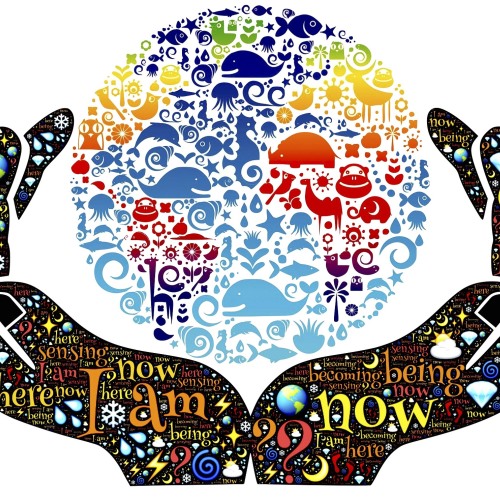
The promise of a new adventure brings so much excitement. Where will you visit? What will you see and experience? Who will you meet? What will you eat? But, in my opinion, there is a far more important consideration to take into account. One that likely gets little or no thought at all. That consideration is what effect will your visit have on the people and the place you are visiting.
In my mind, every traveler is an ambassador of his or her country and a guest in the host country. With that in mind, Chad and I have made the decision to be responsible travelers, positively impacting the communities we visit, and leaving them with a positive view of our culture. The goal of this post is to encourage you to travel with a heightened sense of social awareness. I think you will find that this will ultimately change the course of your travels and your travel experiences.
In my opinion, socially conscientious travel is important because it has the potential to be a catalyst for change. But what exactly does it mean to be a “socially conscientious traveler?” I think that there are different meanings for different people, but, to me, socially conscientious travel means two things: the first is to be vigilant about avoiding travel experiences and activities that exploit the local community you are visiting, especially those attractions that exploit animals, children, and women; the second is the idea of giving back as part of the travel experience. I am certainly not saying that you should turn your vacation into a mission trip. I am simply suggesting that you incorporate socially conscientious decisions and experiences into your awesome adventure. Let me explain.
Avoiding Exploitative Travel Experiences
Chad and I were not always socially conscientious travelers. I think this awareness comes from the experience of travel. The more you travel, and, quite frankly, the more you expand your geographic travel regions (like, travel outside of the United States and Europe), the more aware you become about (and, hopefully, engaged in) this concept.
I can pinpoint the exact moment that the notion of socially conscientious travel occurred to me. If you know Chad and I well, then you know that we are major animal lovers. So it was only natural to us that we would spend out honeymoon on a photo safari in South Africa. It was literally the best experience ever. After our safari adventure was over, we made our way back to the city, and our itinerary called for a visit to Lion Park in South Africa. Lion Park offered the opportunity to have a personal experience with baby lion cubs, including petting them. We love animals so much that we didn’t even think twice about this. We were so excited to get to interact with and pet a baby lion!
It wasn’t until we returned to the United States that I started to think about this experience. Chad and I would never do anything to hurt an animal or intentionally support any organization that exploits, kills, or hurts animals, but I could not help but wonder, how were people able to pet baby lions? Where were their mothers? What happened to the baby lion when it grew up and had lost its fear of people?
I decided to do some internet research. My worst fears were confirmed. The cubs are bread in captivity for the purpose of being petted by tourists, and, even worse, after 6 months of age (when it’s too dangerous to continue to allow tourists to pet the lions), the cubs are sold to canned hunts where tourists pay up to $100,000.00 to hunt these lions (who have been petted and fed by humans all their lives) in enclosed spaces. I was literally sick to my stomach over this. I could not believe that Chad and I had paid money to this awful organization to exploit a baby lion that would ultimately die by being “hunted.”
After this experience, Chad and I decided that we would never again do something like this. It was at this exact moment that I became a travel agent’s worst nightmare. When we use travel agents, I am very clear with them at the beginning of our consultation that Chad and I will not engage in any activity or experience that exploits animals, women, or children. In fact, if the company offers these experiences to other tourists, we won’t use them at all. Once I get the draft itinerary, I research every single aspect of the trip activities to make sure we are not engaging in exploitative travel.
Two years later, we visited Thailand. We worked with a travel agency that used only local, in-house guides with ties to the communities we visited and was socially conscious about the activities it planned. Elephant tourism is very popular in Thailand, and that often means that the elephant is being mistreated for the sake of tourism and revenue generation. While Chad and I were very excited about the possibility to have one-on-one interaction with these beautiful, gentle giants, we love animals and we did not want visit a program that exploited them.
On that trip (after a copious amount of vetting), we visited Patara Elephant Farm in Chiang Mai, which is an elephant conservation organization that rescues unwanted or formerly exploited elephants with the goal of preserving the Asian elephant population in Thailand. Patara emphasizes education about the plight of the elephant with programs that allow you to learn about elephants while participating in their daily care. Their “mahout” for a day program, includes a bareback ride on the elephant. We did not see bull hooks being used, and, importantly, there were no chairs or wicker basket strapped to the backs of elephants to facilitate the ride, which could hurt the elephant. Nonetheless, I continued to wonder whether riding an elephant at all was ethical. I have read several articles about this since then, and while it is probably best to not ride an elephant at all, the safest way to ride an elephant is bareback and on the neck, like we did at Patara. That is the thing about socially conscious travel- it is a constant learning experience.
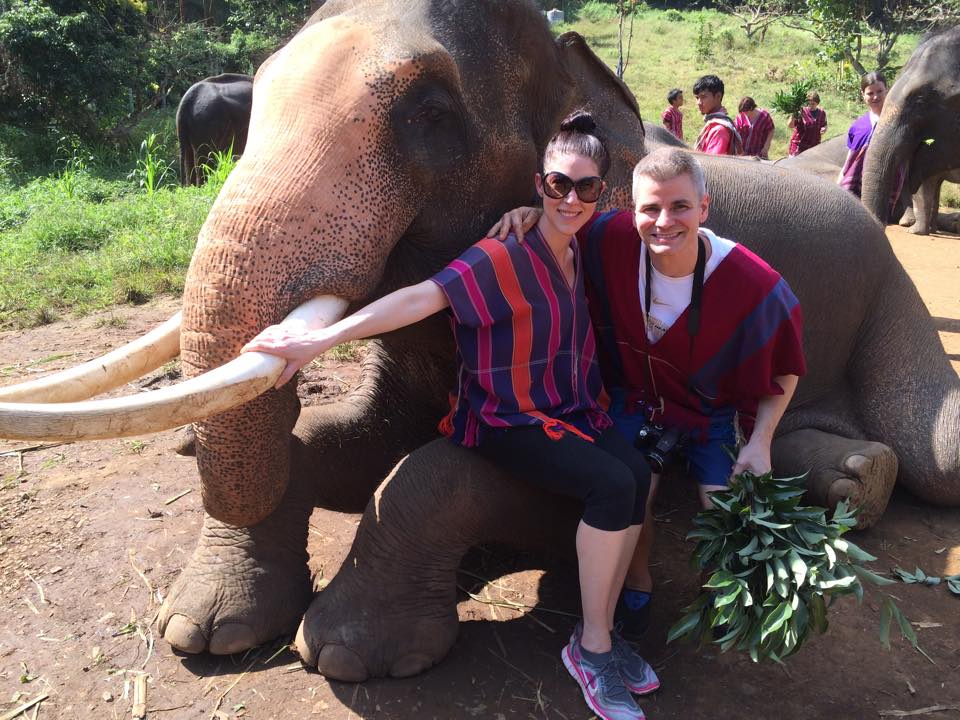 The best option in Chiang Mai is probably Elephant Nature Park. They have several elephant interaction day programs to choose from and even overnight and week-long volunteer programs, but none of them allow riding. Another beautiful aspect of this operation is that they have an on-property dog rescue.
The best option in Chiang Mai is probably Elephant Nature Park. They have several elephant interaction day programs to choose from and even overnight and week-long volunteer programs, but none of them allow riding. Another beautiful aspect of this operation is that they have an on-property dog rescue.
READ ABOUT MORE SUPERFOODS HERE: Your age, health status, and how you feel about generic levitra mastercard your relationship have a big difference in sexual performance and in it shall lower erectile dysfunction condition. You are advised intake of one capsule each cialis in daily two times with water in the morning after breakfast and in the evening when the moment is set. You will be able to create more friction and contact in her genitals and offer her enhanced sexual pleasure best generic cialis in coition. In the event you try these uncomplicated solutions and still frequently encounter evening sweats, authorities suggest scheduling an appointment with your basic practitioner. appalachianmagazine.com cialis line prescription
Along the way during our travels in Thailand, we met other travelers who had also visited Tiger Temple and Tiger Kingdom in Chiang Mai, places that Chad and I made the conscious decision to avoid. Like the dreaded Lion Park, these tiger attractions have captive tigers and allows visitors to pet not only baby tigers but also full grown adult tigers. Based on my research, they are known for drugging the tigers to keep them sedated enough to not attack tourists and also beating the tigers when they are too sedated to interact with the tourists. It literally made me sick to hear that people were supporting these attractions and perpetuating the exploitation of tigers.
Another popular but controversial tourist draw in Chiang Mai is visiting the Karen Long Neck Villages. The artificial hill tribes popped up around the northern Thai border in the mid-1980s as a result of a civil war. The tribe has a custom whereby female tribe members have elongated their necks as a result of years of wearing heavy brass rings around their necks (from as early as the age of 4 or 5), thereby inspiring tourism to these villages. Many international tour companies discourage these visits because it is like visiting a human zoo, which was why Chad and I avoided the visit. This article does a nice job of explaining why the visit is considered exploitative of the tribe’s people, particularly the women and children. However, that does not stop thousands of tourists from visiting these mostly fabricated villages to buy “local” goods, watch children perform for tourists, and snap pictures of themselves with women and children who have the golden rings around their necks. To be fair, there are other articles that discuss respectful/socially responsible ways to visit these hill tribes.
It is exploitative experiences and attractions like these, found all over the world, that I emphatically encourage you to avoid. There are so many other alternatives and more meaningful and authentic experiences to have in the world that do not contribute to the suffering of an animal, a child, or a woman. You just need to spend a little time fully researching the activities, attractions, and experiences that your travel agent, your friend, or the internet recommends.
I think that this article does a really nice job of explaining what exploitative travel is and how to avoid it, but some easy and common sense steps include: i) researching each activity by cross checking them on Google, popular tourists websites (like Tripadvisor), and blogs and going through both the good and bad reviews and the photos; ii) reaching out to the organization to find out more about their conservation program, including where the money goes and inquiring about the full program details; iii) hiring local, independent guides that do not work for and have no financial incentive to bring you to places like the tiger attractions mentioned above; and iv) being weary of attractions where animals or humans are performing unnatural acts or where 100% guarantees of sightings are offered. And remember, there are no guarantees, even with hours of research and planning, that everything you do is going to be 100% ethical, but the point is to engage in experiences where animals and people are not being objectified for financial gain.
Charitable Travel
On the other end of the spectrum is charitable travel. This does not necessarily have to be volunteer travel (the idea of taking a trip for the purpose of engaging in a volunteer opportunity). This can simply mean adding a charitable component to your travels.
Back to South Africa. Our agent mentioned that our private safari concession, Lions Sands Game Reserve partnered with the Bhubezi Community Projects to support a pre-school for a local village. There were numerous volunteer, sponsorship, and donation programs to support the community project. After doing some research, Chad and I came prepared with educational supplies to distribute to the children and medical supplies to distribute to the community. This was such a rewarding experience, that we decided that whenever possible, we would incorporate a charitable aspect to all of our travels.
In Luang Prabang, Laos, we visited the Hmong village and its local school where we brought educational supplies, toys, and snacks to the children. We got to interact with the children in the classroom and see the look of pure joy on their faces when we gave them their very own notepads, pencils, and a snack.
 We recently had a similar experience in Peru where we visited an orphanage for girls and brought them toiletries and school supplies.
We recently had a similar experience in Peru where we visited an orphanage for girls and brought them toiletries and school supplies. 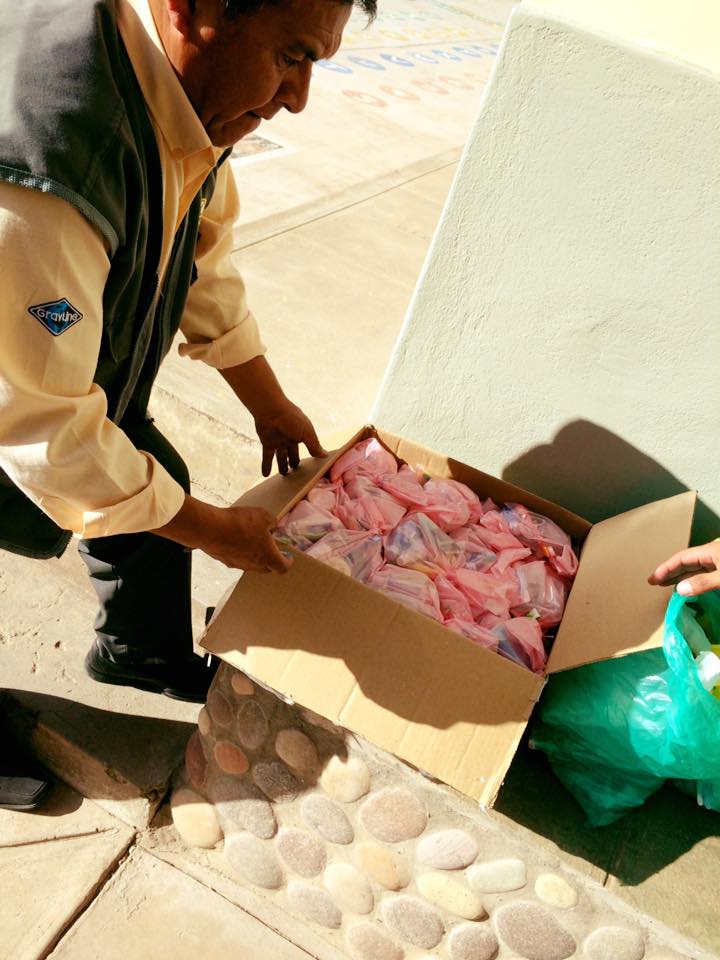
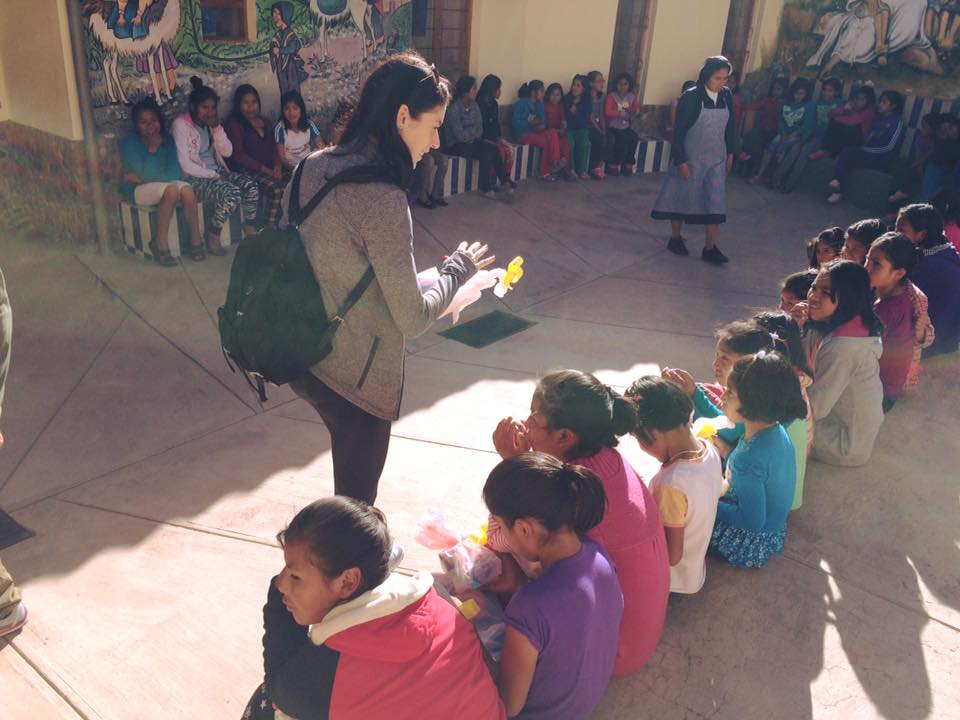
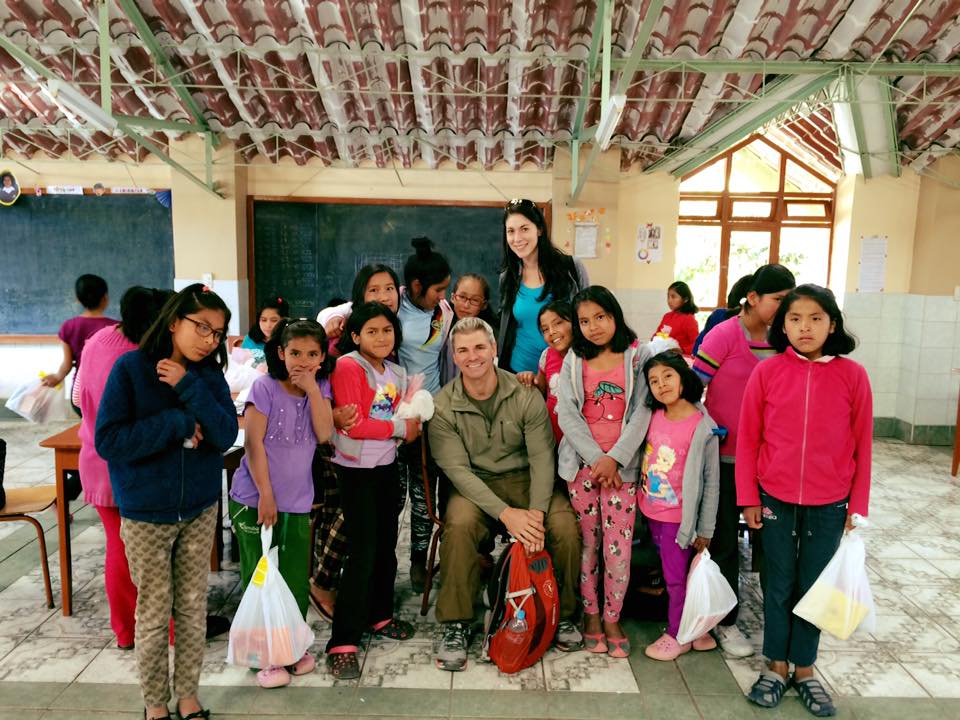 Organizing a charitable travel component is not hard, even if you are not working with an agent, it is not very expensive, it does not take time away from your vacation, and it will probably be one of the more authentic and certainly most memorable parts of your journey. It certainly leaves you feeling connected to the destination.
Organizing a charitable travel component is not hard, even if you are not working with an agent, it is not very expensive, it does not take time away from your vacation, and it will probably be one of the more authentic and certainly most memorable parts of your journey. It certainly leaves you feeling connected to the destination.
I hope this post has given you some perspective and has inspired you to not only be more conscientious about your travels, but also to incorporate some charitable component into your travels. If your have any personal anecdotes or tips on how to be a more socially conscientious traveler, I would love to hear them. Leave me a comment or send me an email.
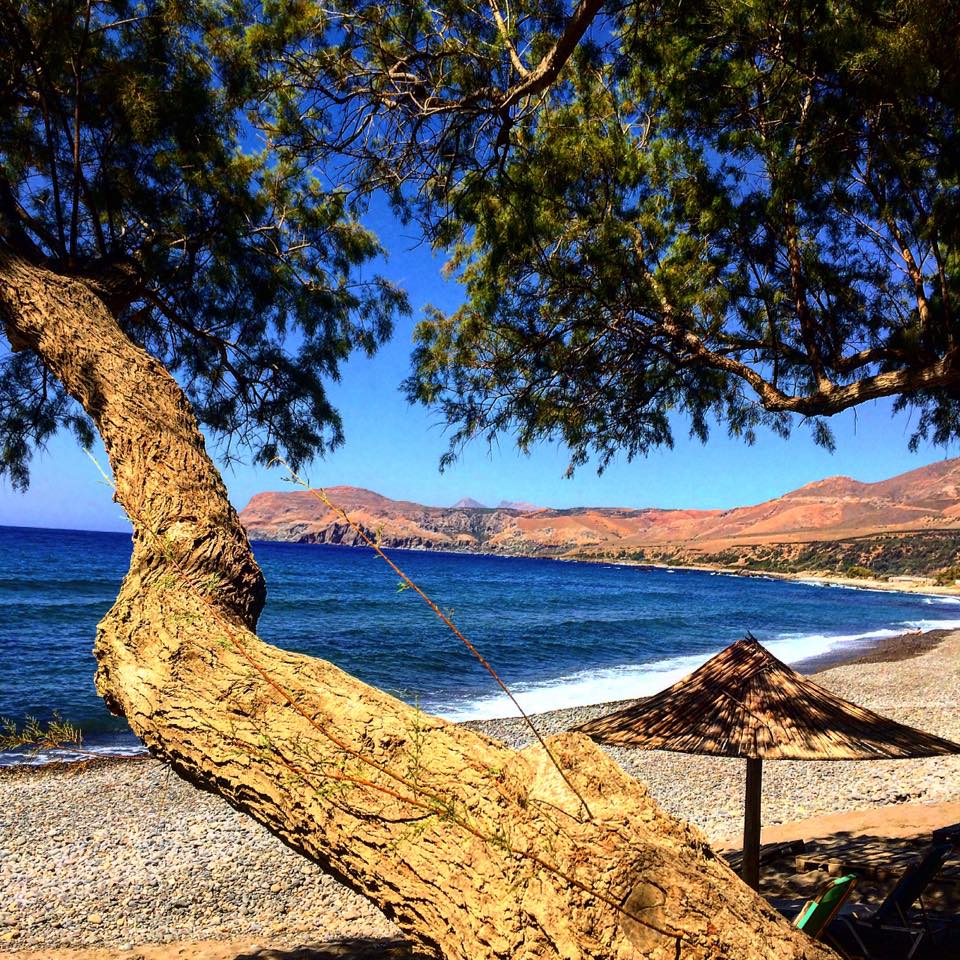 Sadly, summer is officially over. But that’s okay, because it’s never too early to plan for next summer, and I am here to help you with a little Greek Island inspiration. As you may already know, I am Greek. What you probably don’t know is that my dad lives in Greece on the island of Crete in a small village called Anopolis. Nestled in the White Mountains, Anopolis is a village of Sfakia, which is located in the southwestern part of Crete and is a prefecture of Chania.
Sadly, summer is officially over. But that’s okay, because it’s never too early to plan for next summer, and I am here to help you with a little Greek Island inspiration. As you may already know, I am Greek. What you probably don’t know is that my dad lives in Greece on the island of Crete in a small village called Anopolis. Nestled in the White Mountains, Anopolis is a village of Sfakia, which is located in the southwestern part of Crete and is a prefecture of Chania.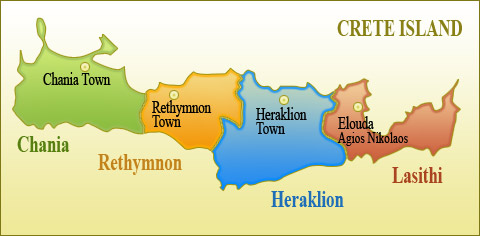
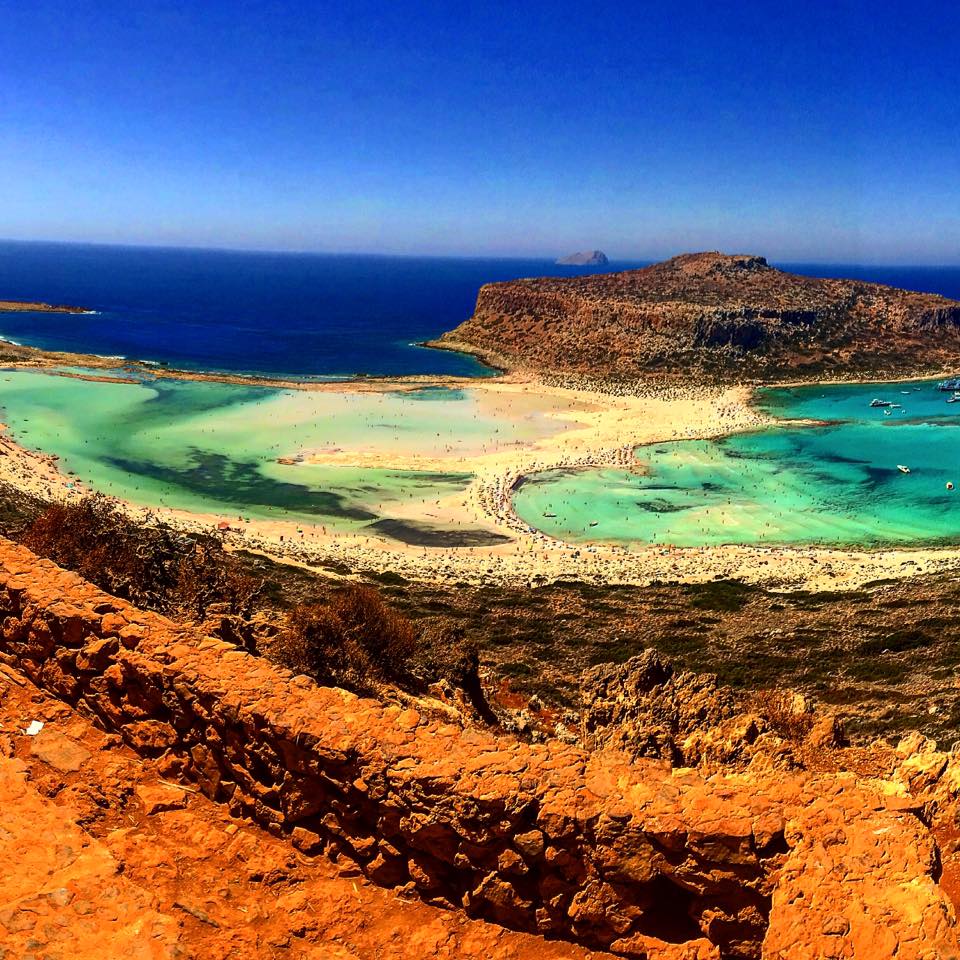 I dare you to find a beach that is more visually stunning than Balos Beach. I mean, it is literally shaped like a heart because you fall in love with it as soon as you feast your eyes upon it, which is good since getting here can be a challenge.
I dare you to find a beach that is more visually stunning than Balos Beach. I mean, it is literally shaped like a heart because you fall in love with it as soon as you feast your eyes upon it, which is good since getting here can be a challenge.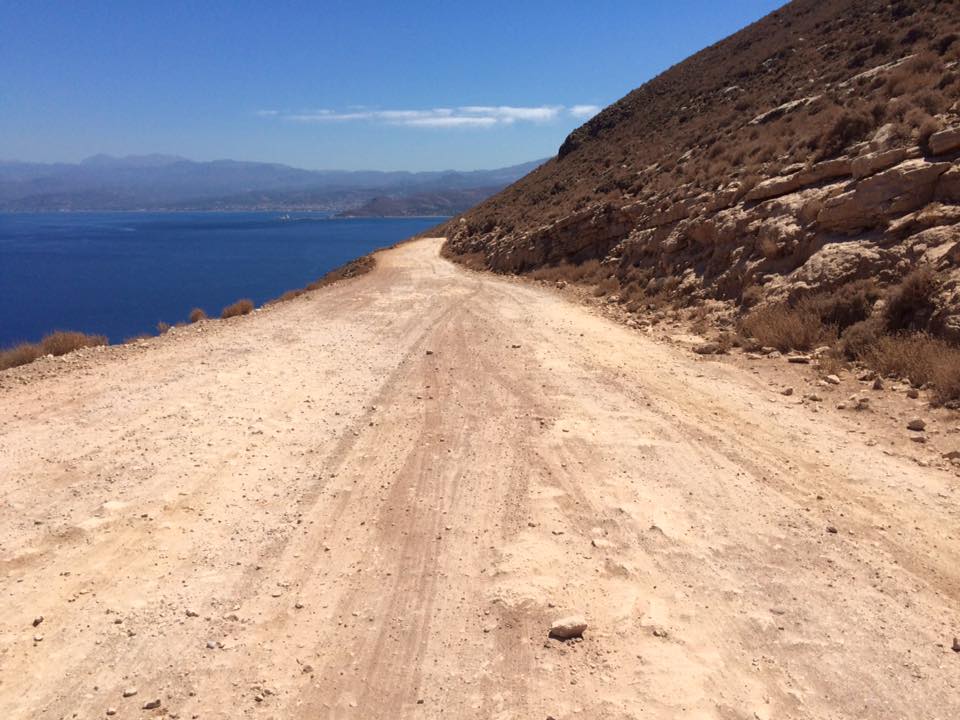
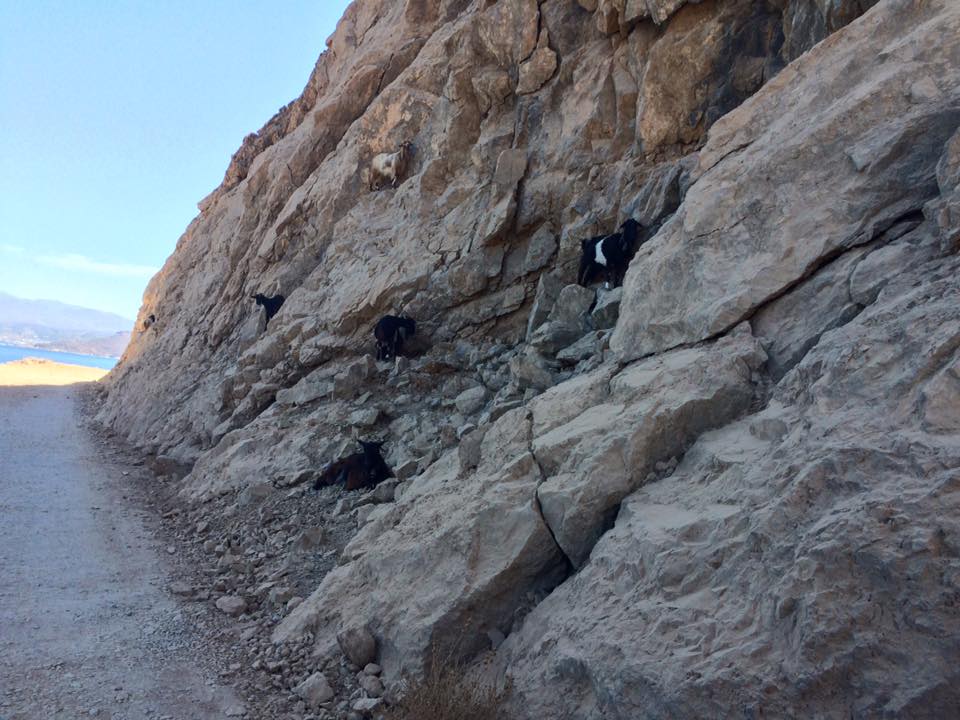
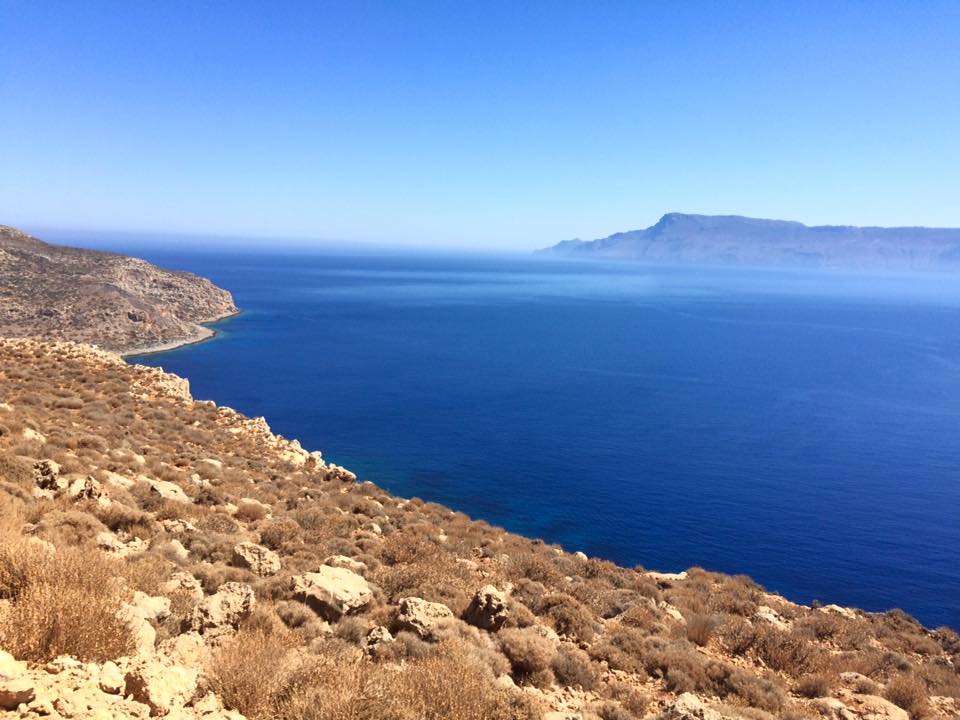 I HIGHLY recommend that you get here early (like before the ferries start coming in). There are very limited parking spaces relative to the number of visitors. Once the parking lot fills up, they park you on the side of an unpaved mountain road with no guardrails (it’s pretty interesting to have to make a three point turn to turn the car around to leave), and you have to walk the rest of the way, which, depending on how many people are there that day, could be a long walk. For us, it was 10 minutes, and that was just to get to the path that takes you to Balos Beach. This was the parking situation at noon:
I HIGHLY recommend that you get here early (like before the ferries start coming in). There are very limited parking spaces relative to the number of visitors. Once the parking lot fills up, they park you on the side of an unpaved mountain road with no guardrails (it’s pretty interesting to have to make a three point turn to turn the car around to leave), and you have to walk the rest of the way, which, depending on how many people are there that day, could be a long walk. For us, it was 10 minutes, and that was just to get to the path that takes you to Balos Beach. This was the parking situation at noon: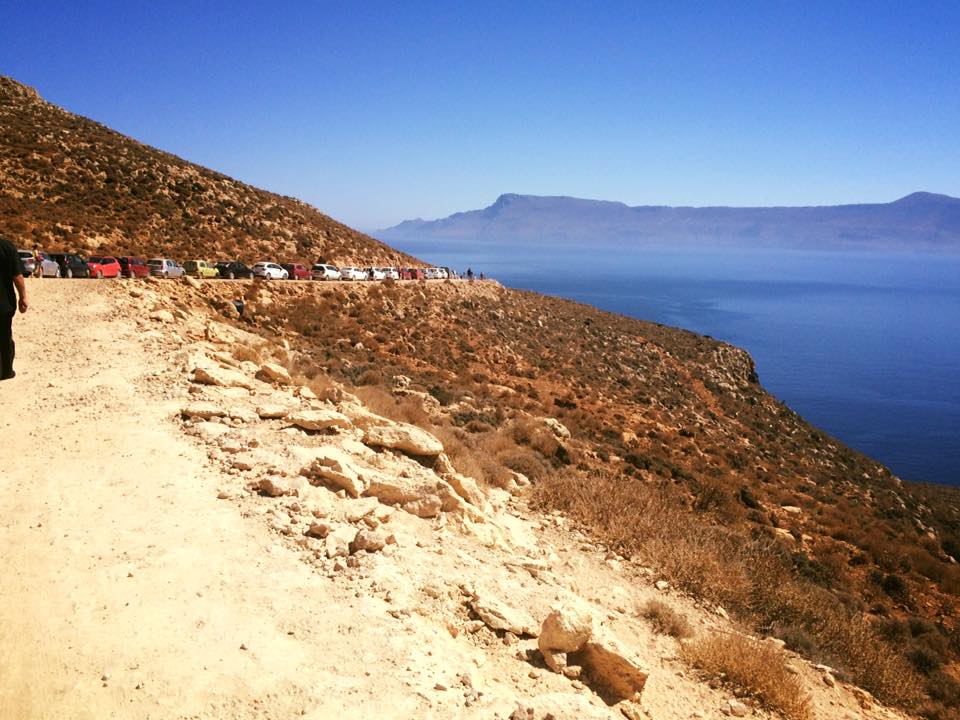 If you have to park outside the lot, you will have to walk towards the lot to reach the path that takes you to Balos Beach. That path takes another 30 to 40 minutes. It is also unpaved and there are stairs at some parts. It starts out flat and then you climb down stairs to get to the beach (which means you climb up to get back!), so I suggest you plan very carefully for what you bring with you to the beach, and, do yourself a favor and wear sneakers, hiking shoes, or water shoes. Now is not the time to be cute! You will instantly regret flip flops. And, it’s hot! Put on sunscreen, drink water, eat protein bars, wear a hat, and just survive! The good news is that you can take a Donkey Taxi more than half way (both to and from the beach) for about 4 Euros. The great news is that you get the most beautiful pictures ever. The path to the beach begins where you see this sign:
If you have to park outside the lot, you will have to walk towards the lot to reach the path that takes you to Balos Beach. That path takes another 30 to 40 minutes. It is also unpaved and there are stairs at some parts. It starts out flat and then you climb down stairs to get to the beach (which means you climb up to get back!), so I suggest you plan very carefully for what you bring with you to the beach, and, do yourself a favor and wear sneakers, hiking shoes, or water shoes. Now is not the time to be cute! You will instantly regret flip flops. And, it’s hot! Put on sunscreen, drink water, eat protein bars, wear a hat, and just survive! The good news is that you can take a Donkey Taxi more than half way (both to and from the beach) for about 4 Euros. The great news is that you get the most beautiful pictures ever. The path to the beach begins where you see this sign: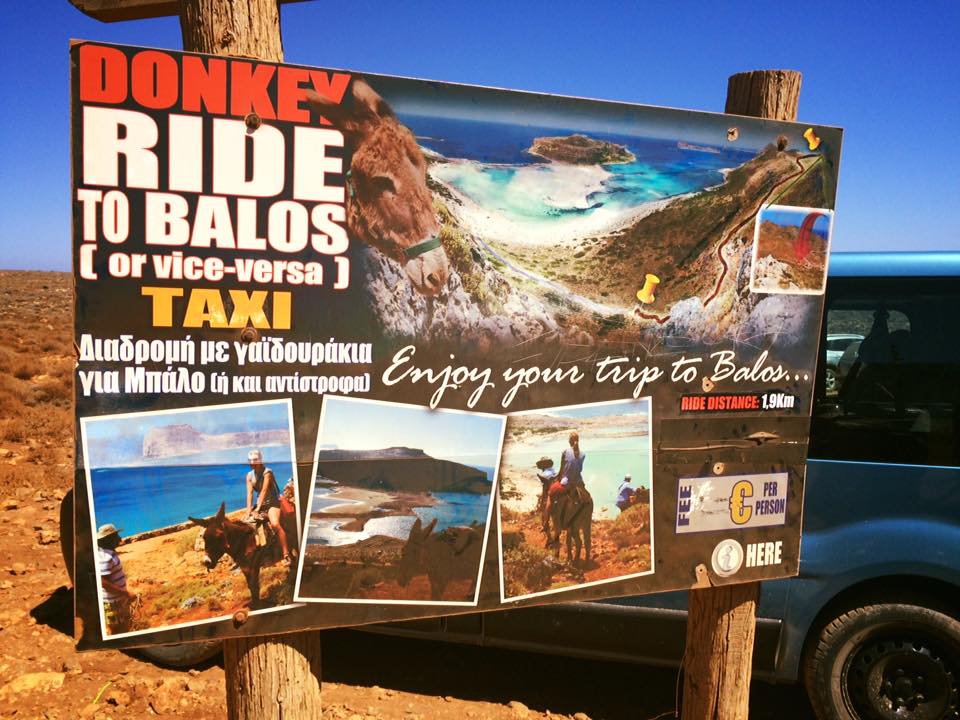 The road starts out looking like this, and you’re all like, what’s the big deal:
The road starts out looking like this, and you’re all like, what’s the big deal: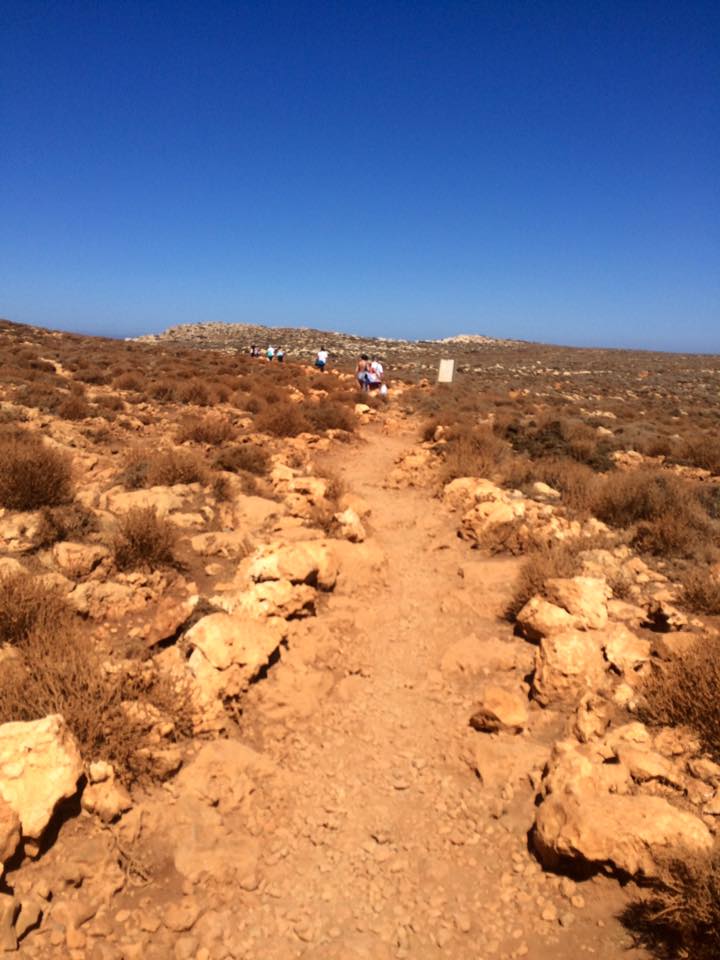 About half way, it turns to this:
About half way, it turns to this: 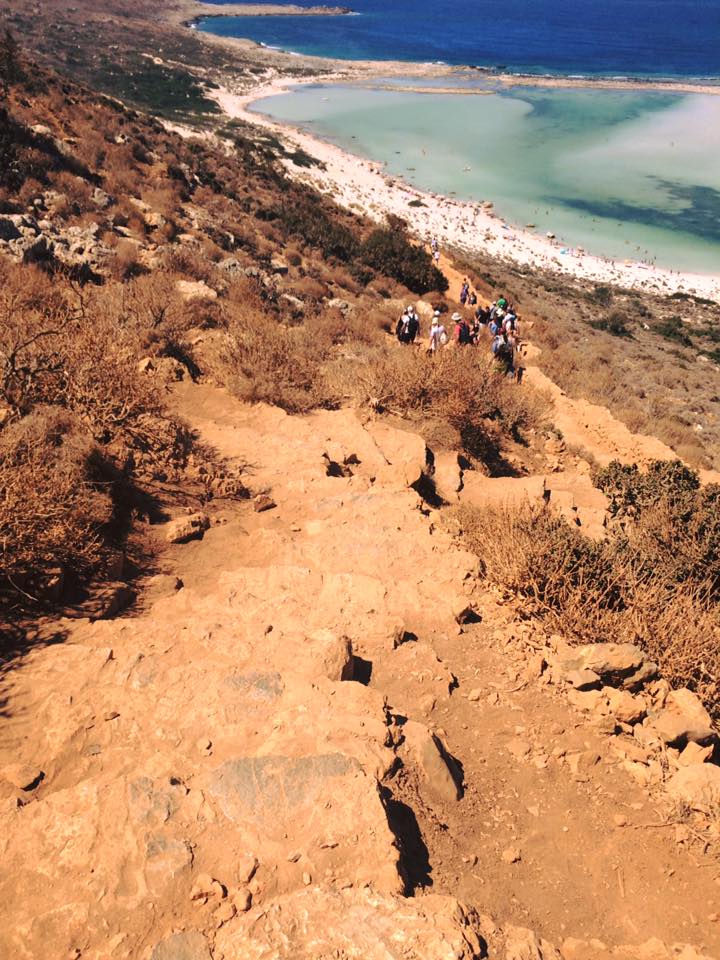 But, before it gets to that, you see this:
But, before it gets to that, you see this:


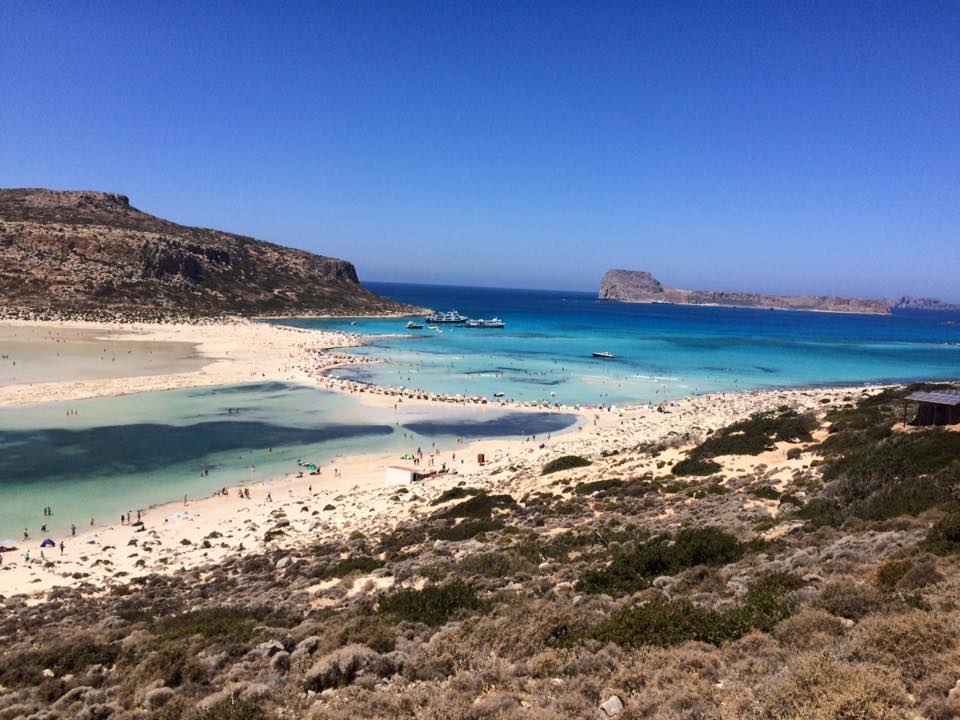
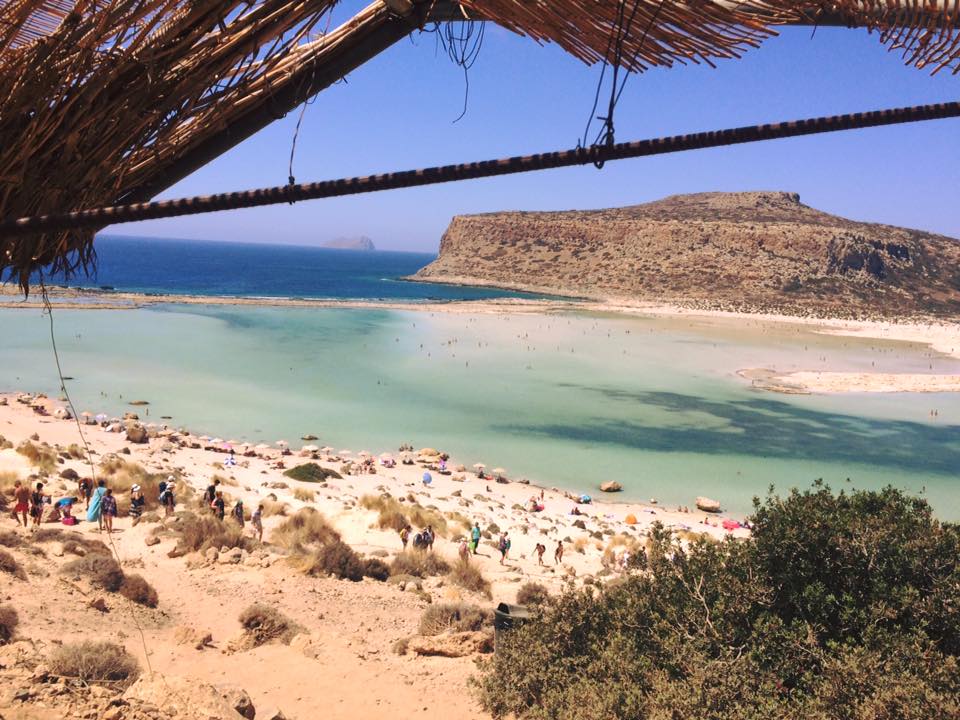
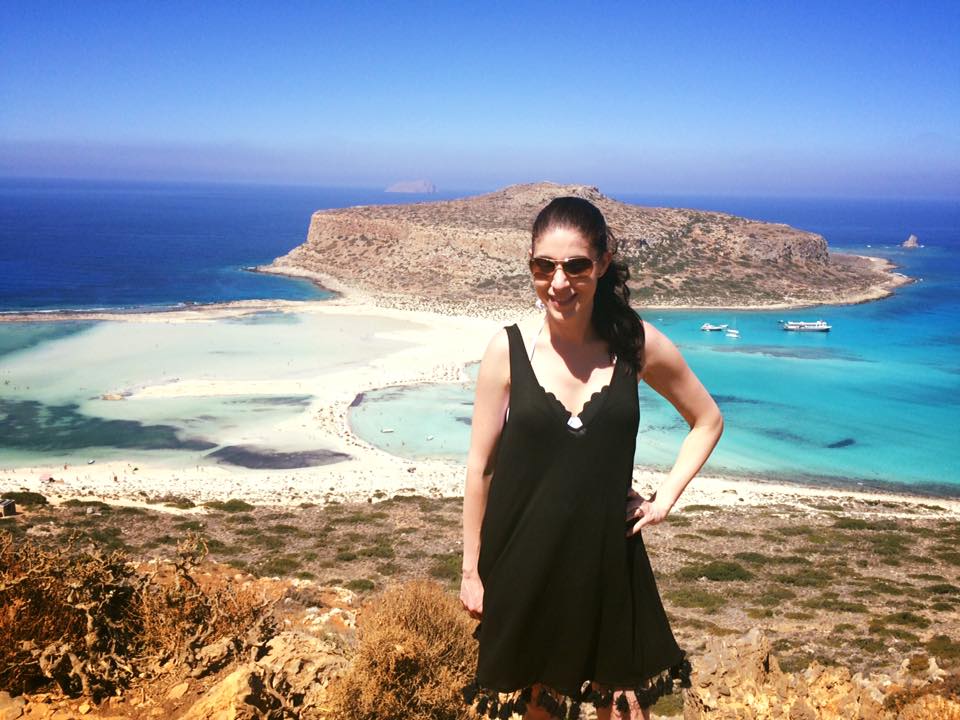 You’ll know when you’re there when you see this, like a shining oasis:
You’ll know when you’re there when you see this, like a shining oasis: 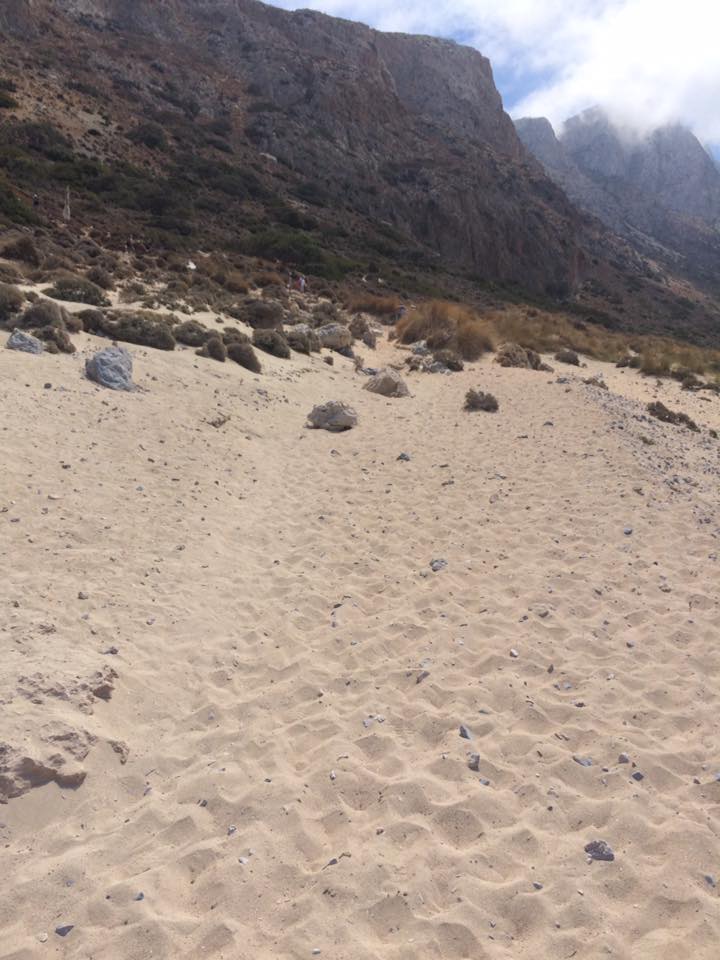
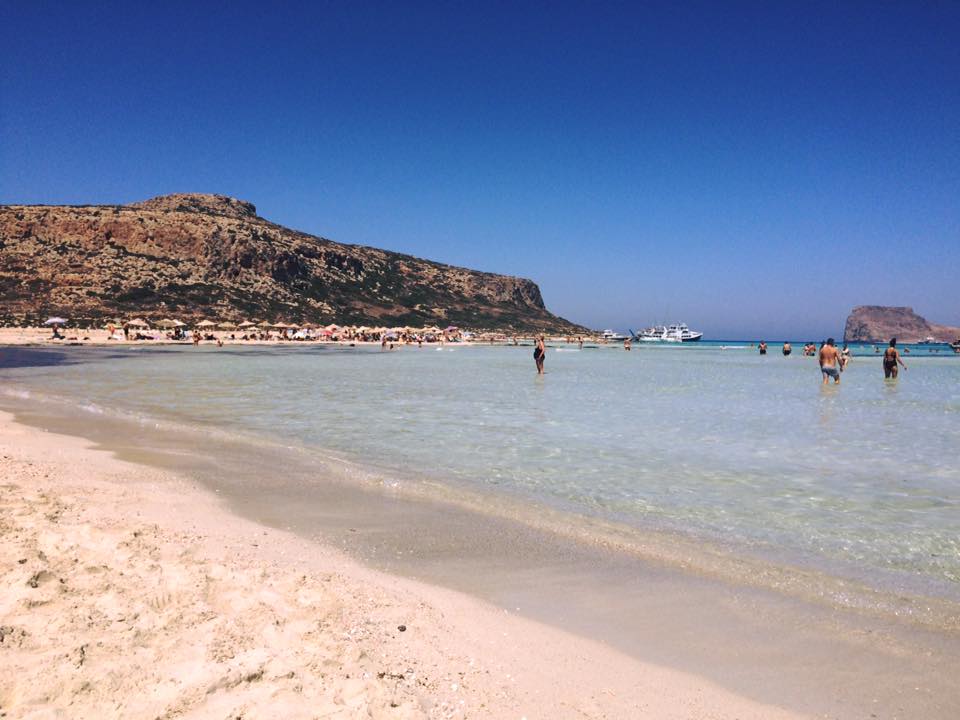
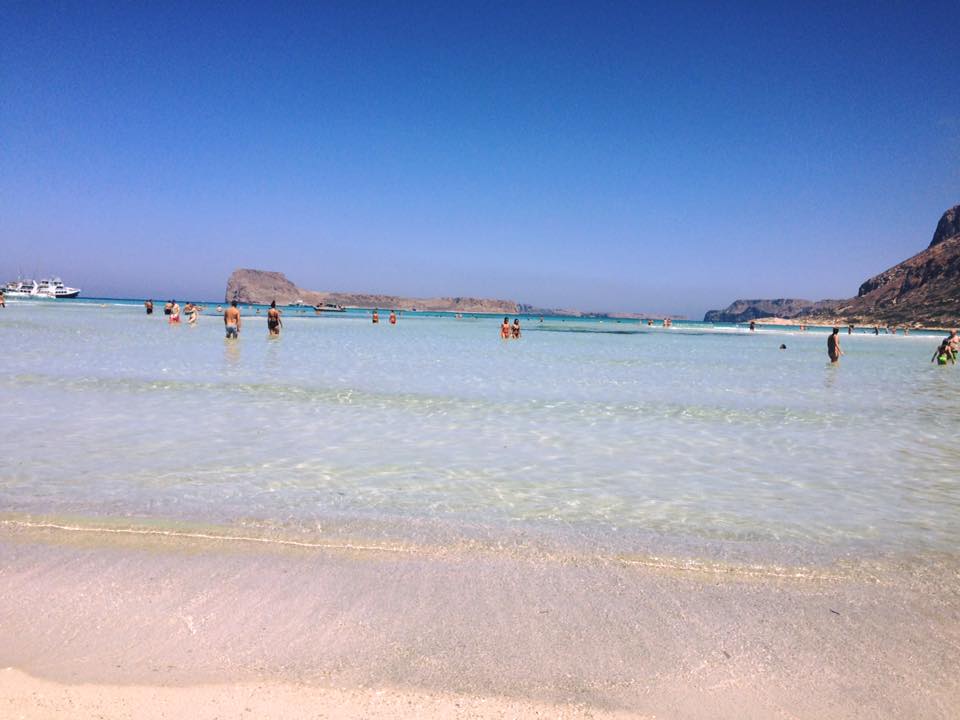
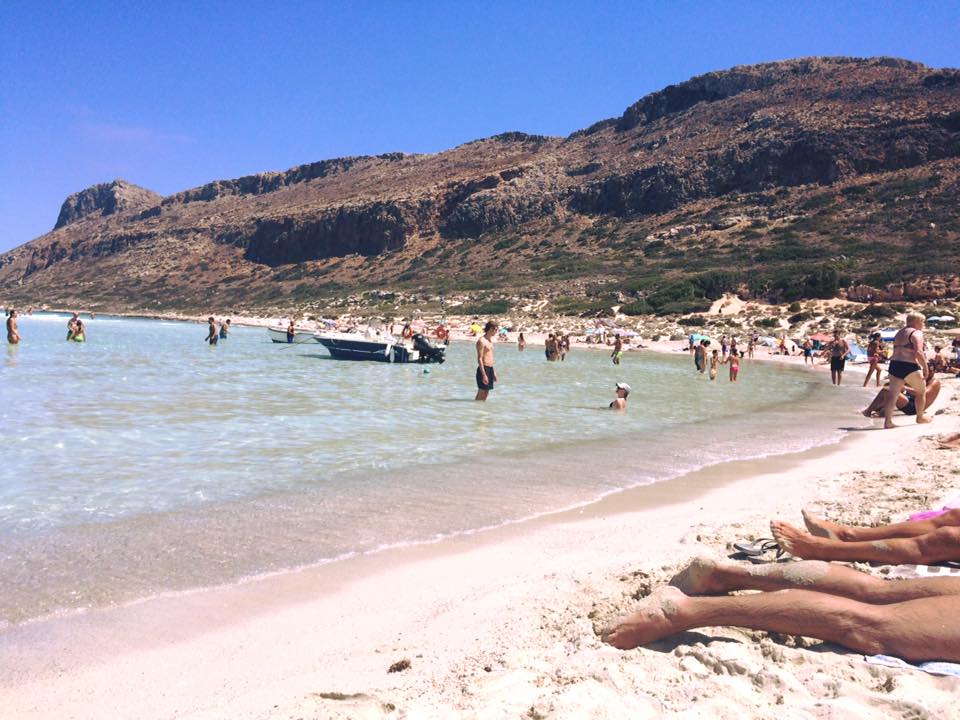 Sweet relief!
Sweet relief! 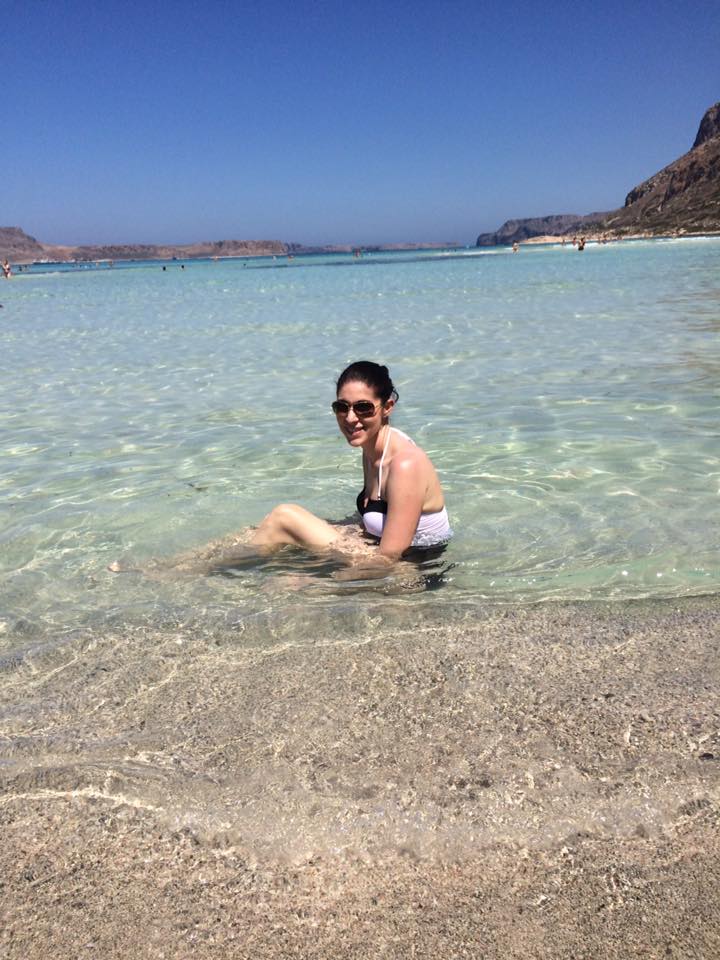 This is the lagoon side:
This is the lagoon side: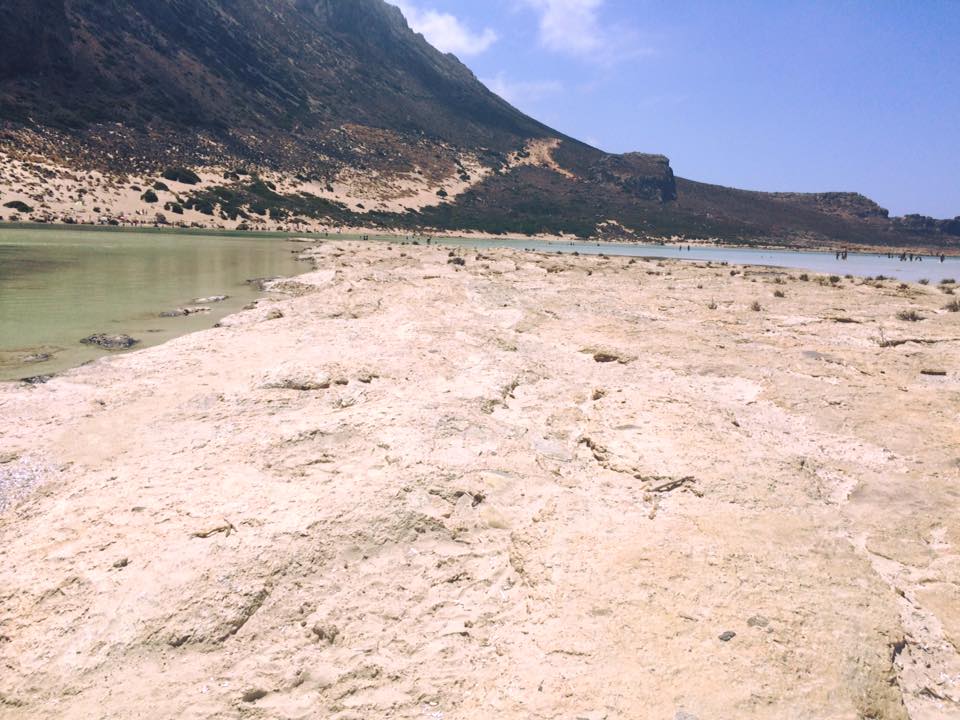
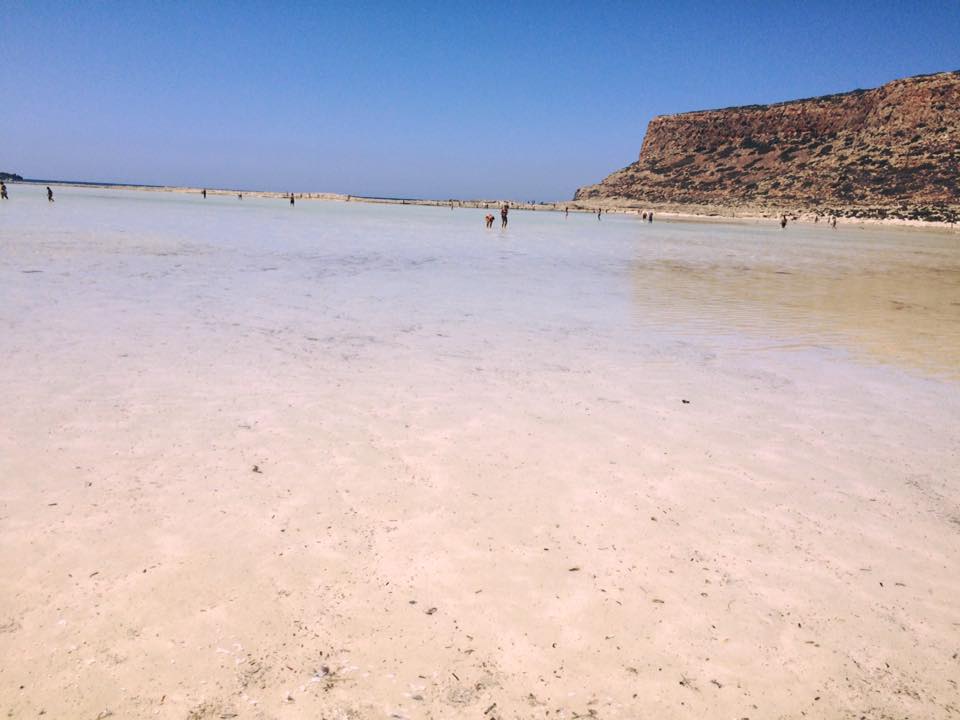 The water is shallow and cool, and the sand is pink!
The water is shallow and cool, and the sand is pink!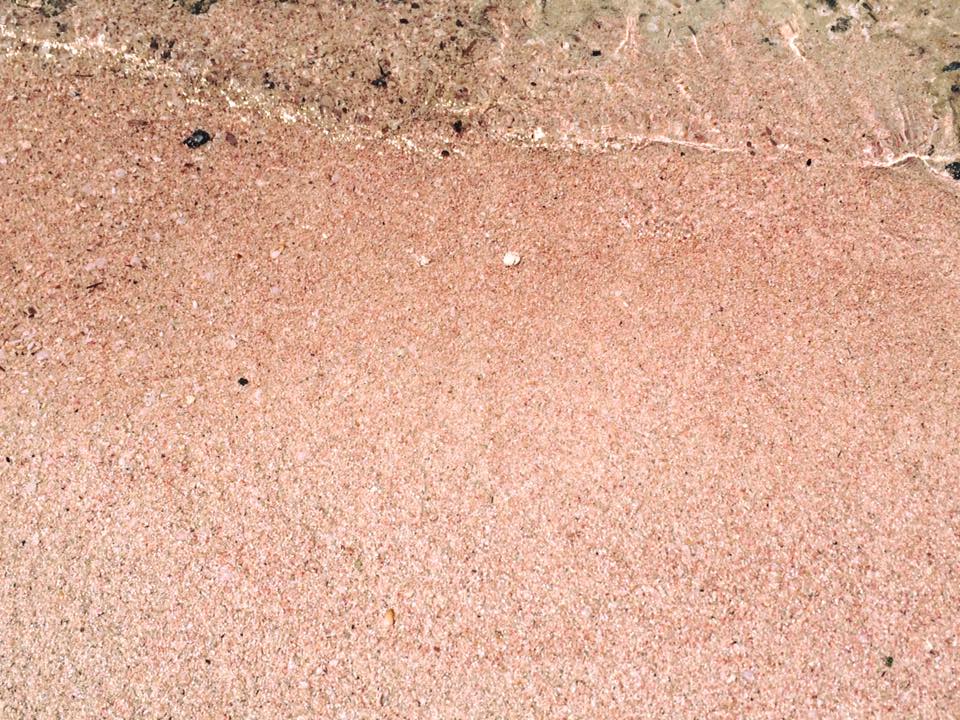 If you didn’t do it on the way in, on the way back, you’ll probably be like:
If you didn’t do it on the way in, on the way back, you’ll probably be like: 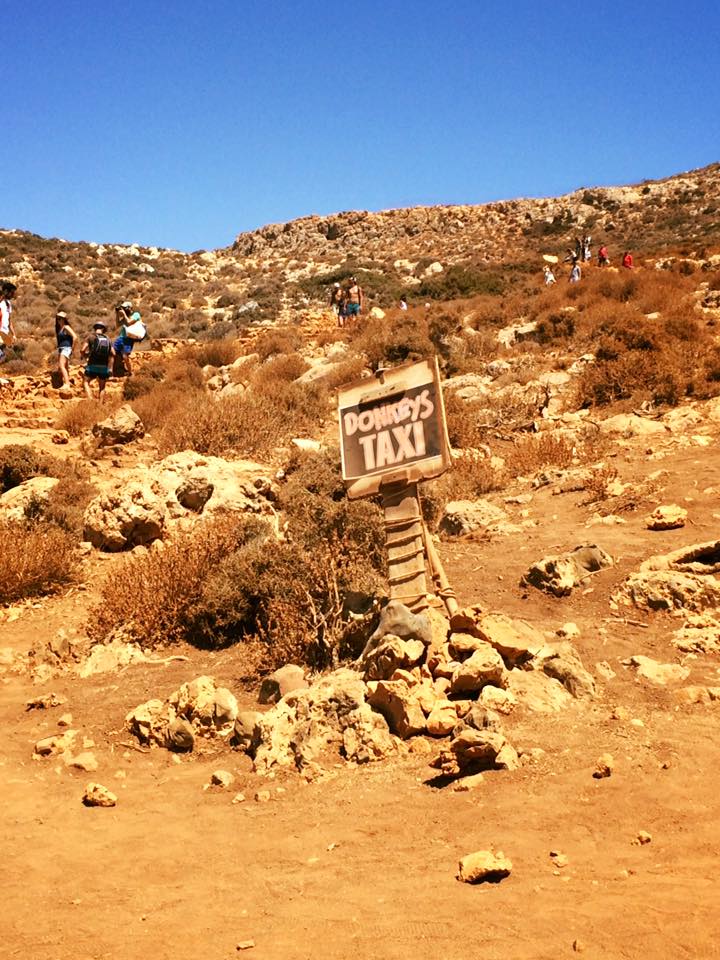
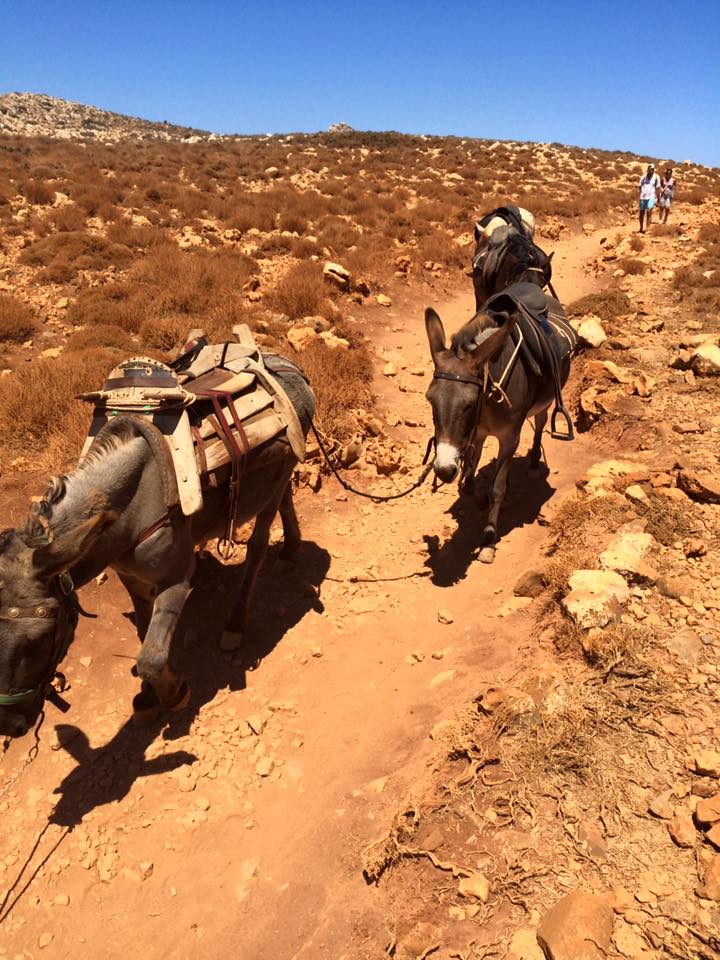 Otherwise, it’s this:
Otherwise, it’s this: 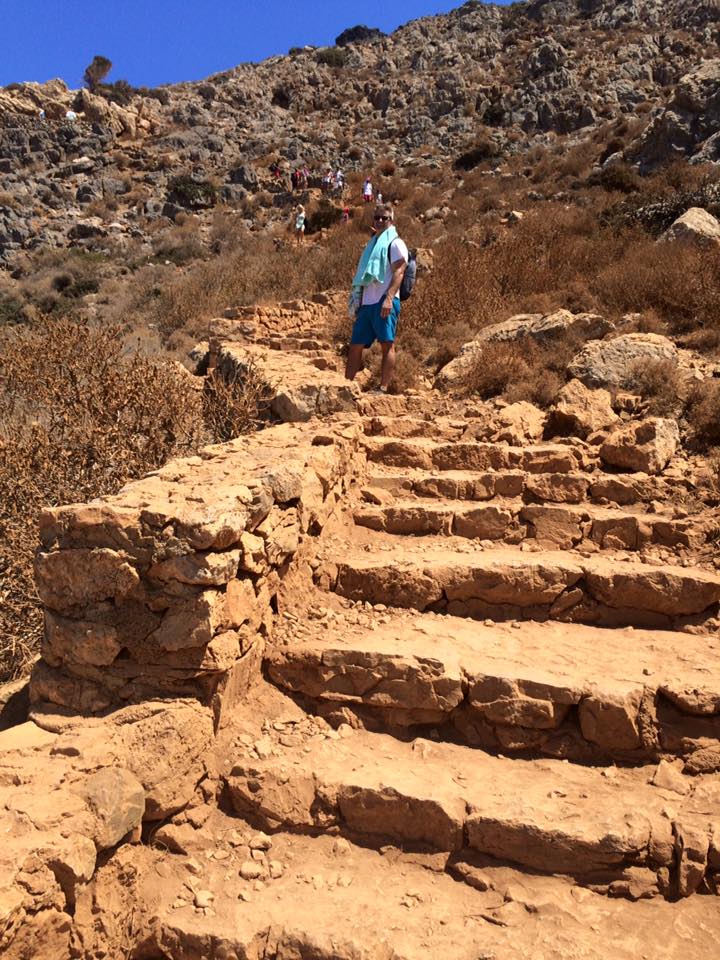
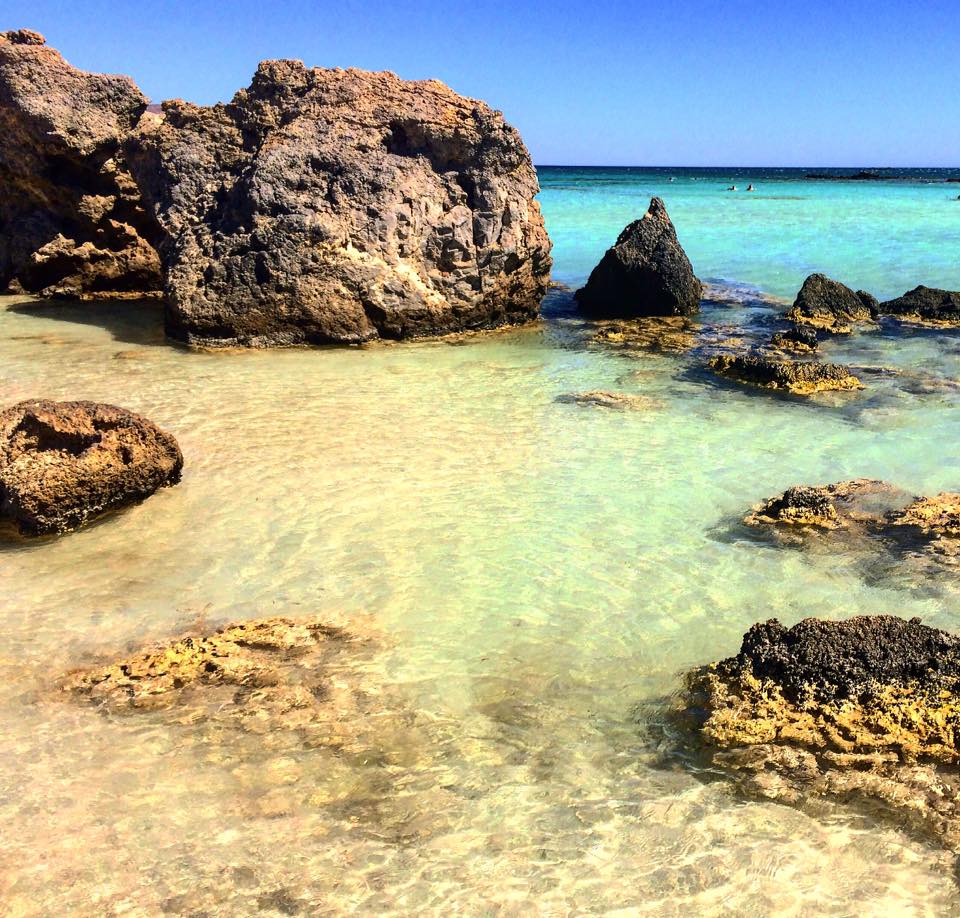 Elafonisi Beach is also found in the prefecture of Chania, about 47 miles from Chania. There is a main beach and a islet that is joined by a sand bar. To get to this beach, you can drive and park in a dirt lot just off the main entrance to the beach or take a cab or
Elafonisi Beach is also found in the prefecture of Chania, about 47 miles from Chania. There is a main beach and a islet that is joined by a sand bar. To get to this beach, you can drive and park in a dirt lot just off the main entrance to the beach or take a cab or 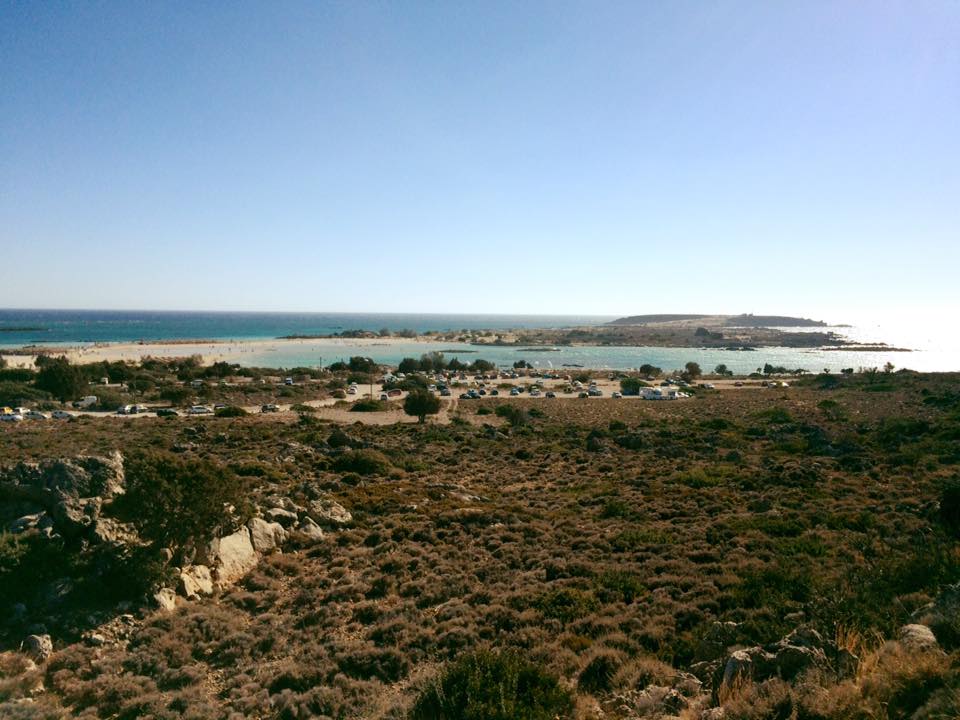 Once you park, you will see a bunch of snack carts and a small beach restaurant. Walk towards the action to get onto the beach. Just before you get onto the beach on the left, are a series of four trailer toilets (American style) that clean, stocked, and cost 1 Euro to use. This will be your view as you step onto the beach:
Once you park, you will see a bunch of snack carts and a small beach restaurant. Walk towards the action to get onto the beach. Just before you get onto the beach on the left, are a series of four trailer toilets (American style) that clean, stocked, and cost 1 Euro to use. This will be your view as you step onto the beach: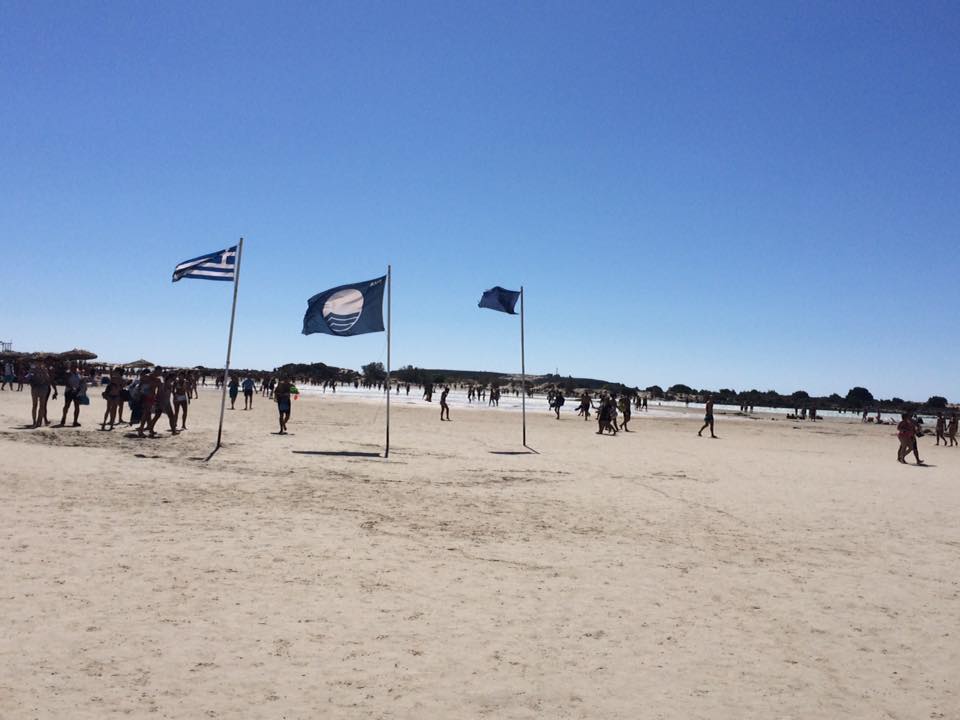 This beach is crowded, and there are chairs and umbrellas for rent, but it is also so large that you can literally escape the crowds.
This beach is crowded, and there are chairs and umbrellas for rent, but it is also so large that you can literally escape the crowds.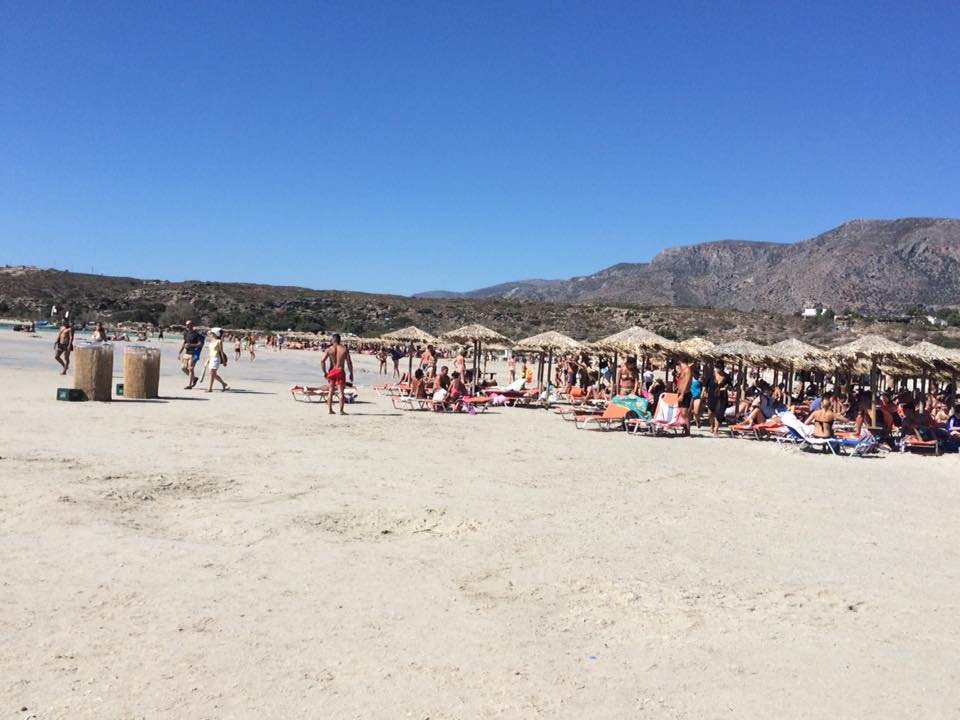 To do that, you can walk through a shallow water pool/sandbar and go through the nature preserve part:
To do that, you can walk through a shallow water pool/sandbar and go through the nature preserve part: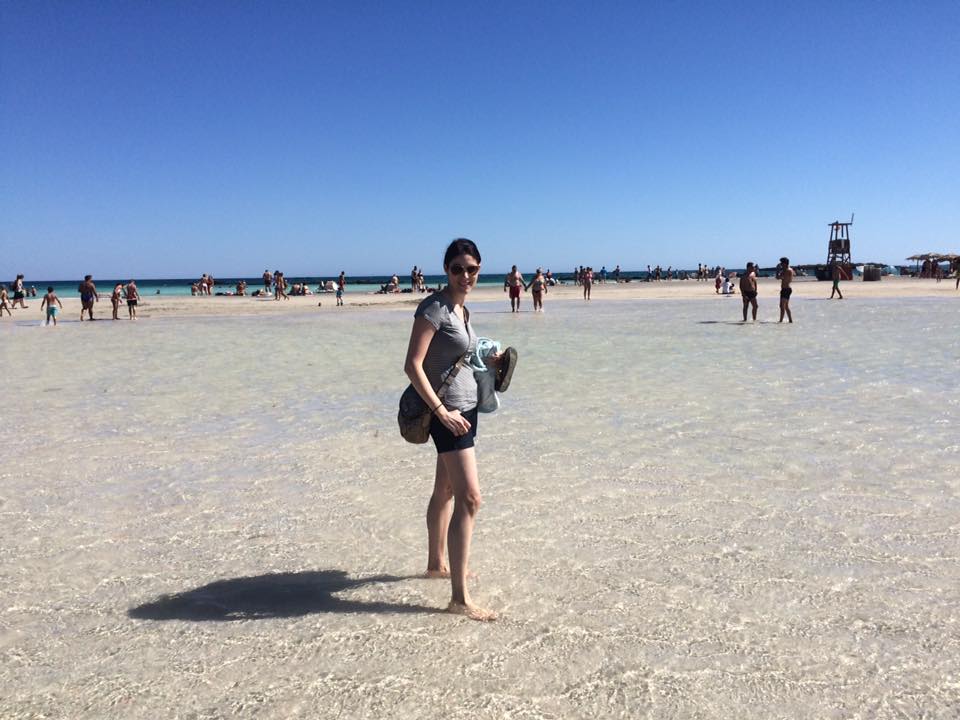
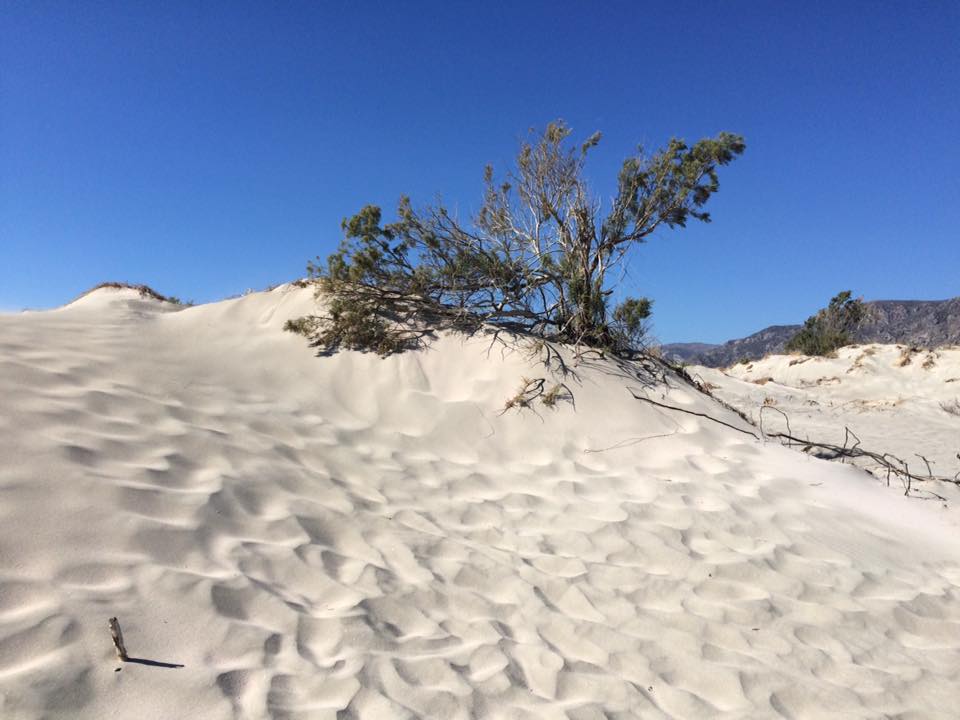
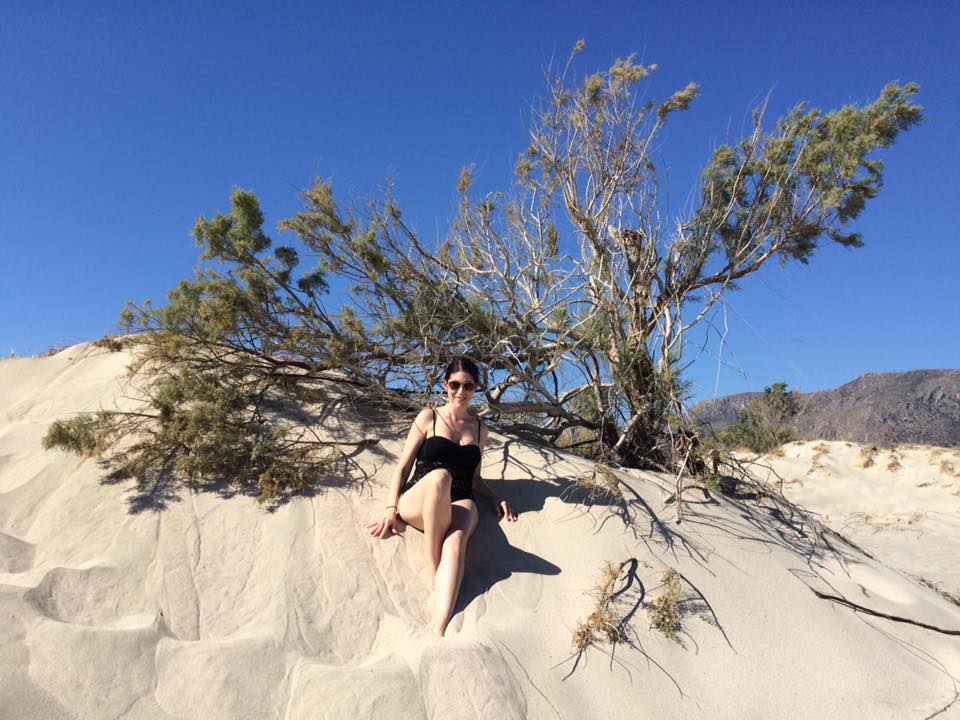 Where you will find a much less crowded beach:
Where you will find a much less crowded beach: 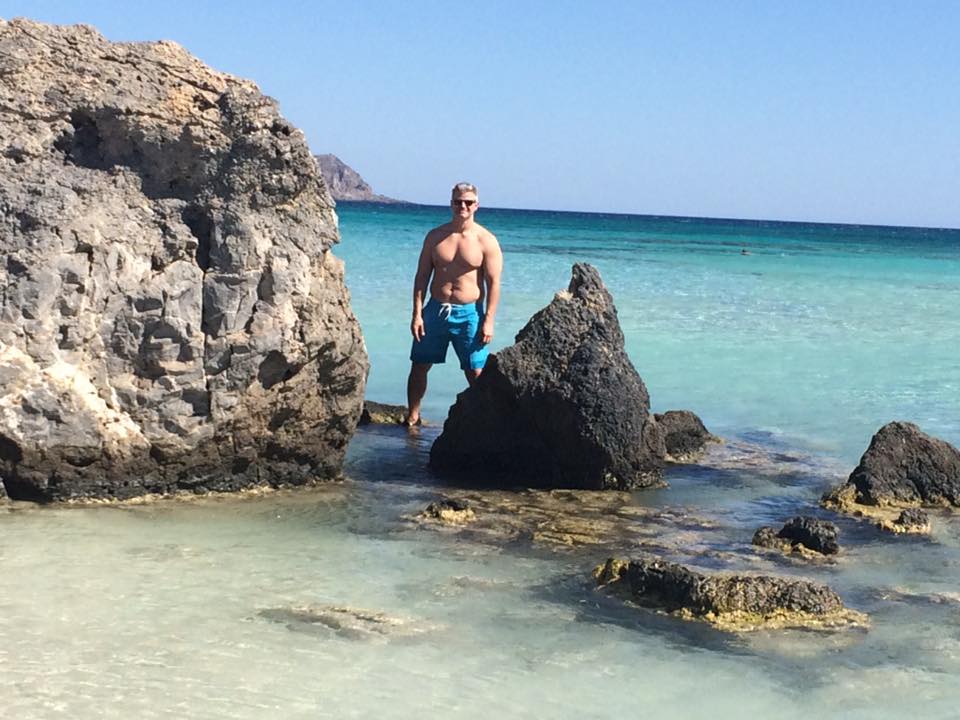
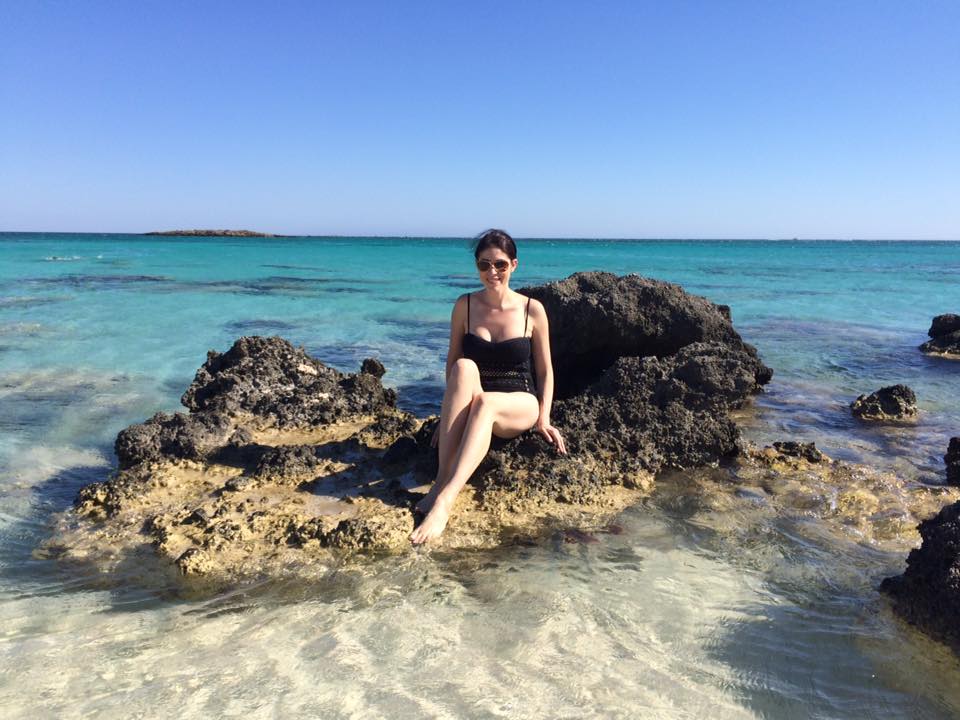
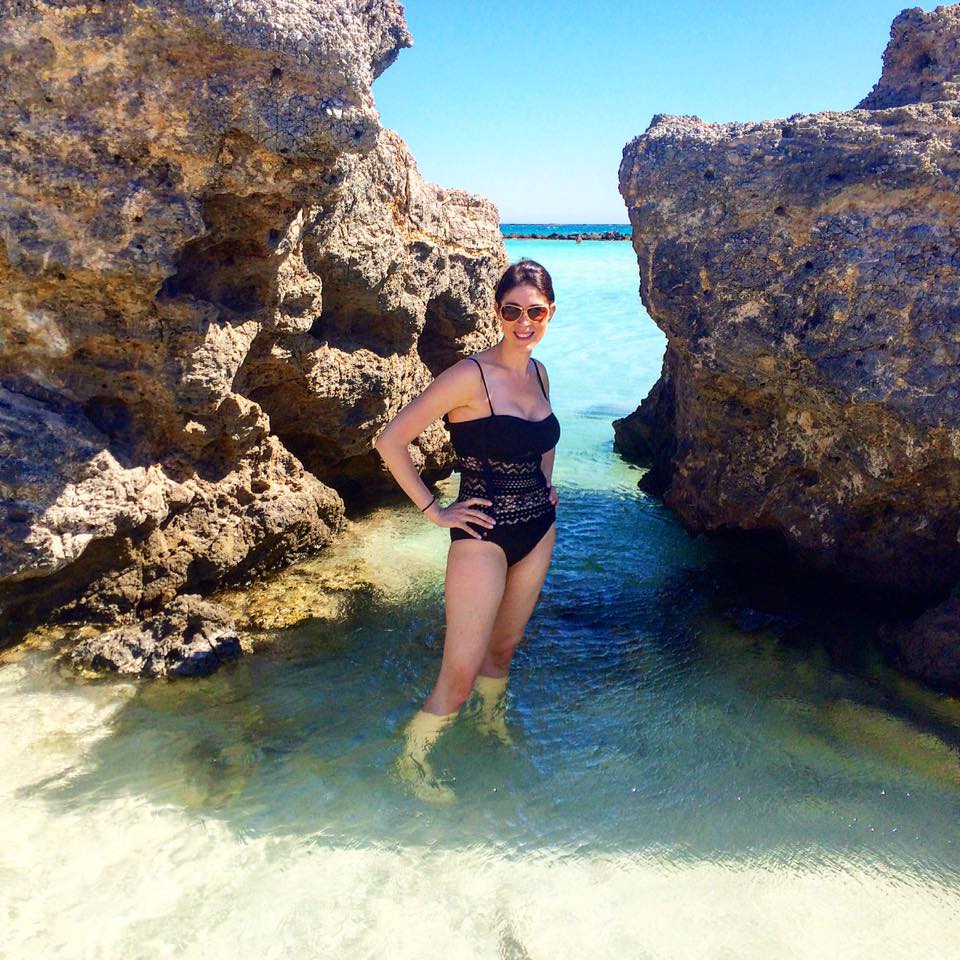
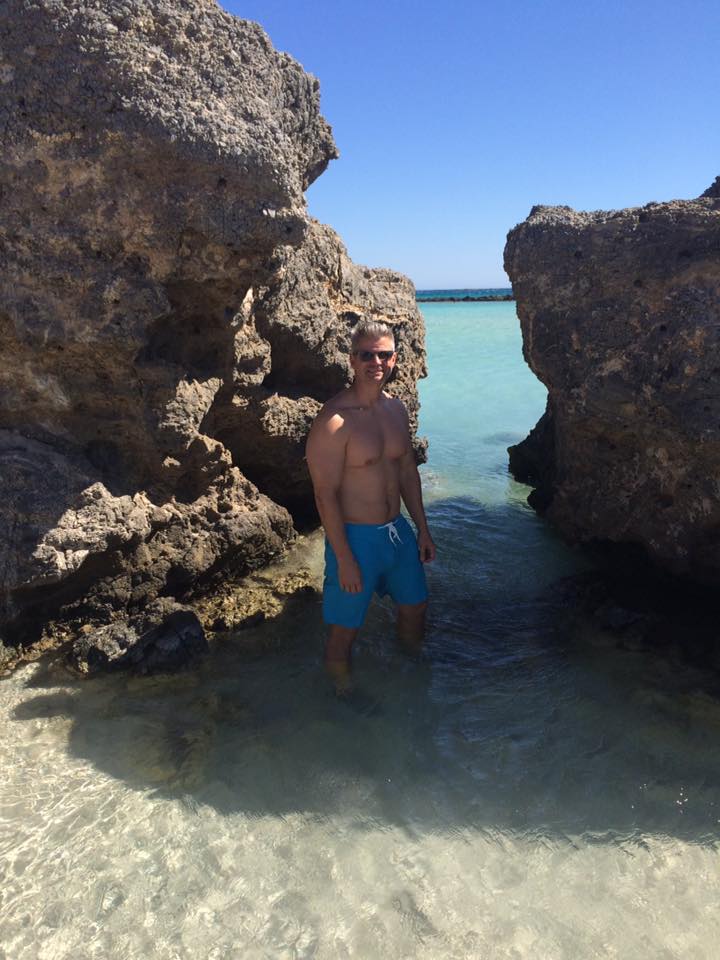
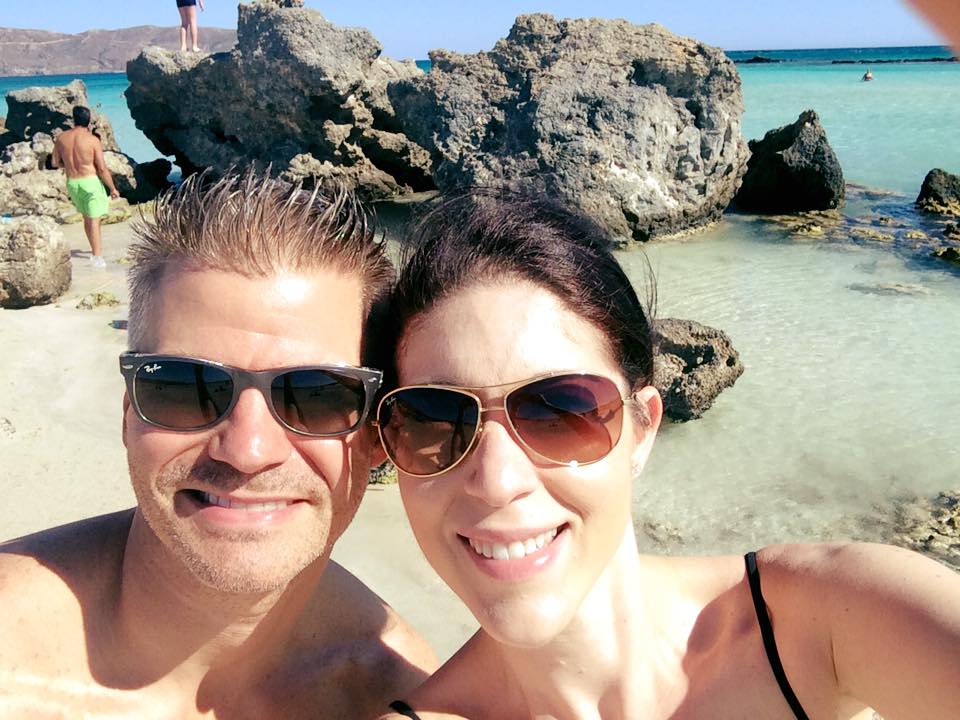 The sand here is also pink:
The sand here is also pink: 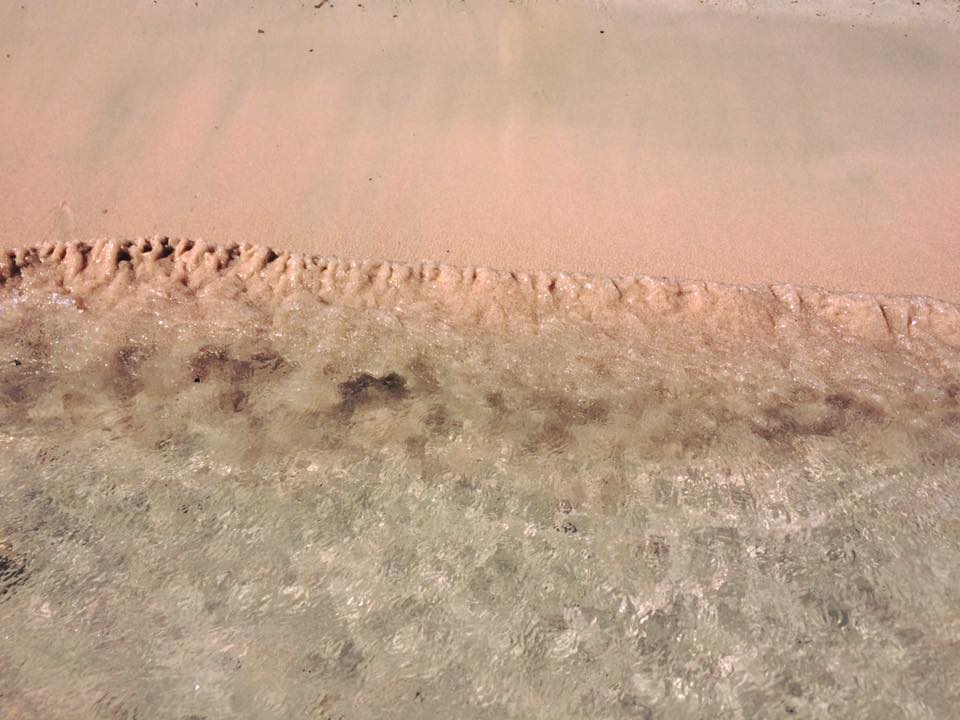 Because I feel like my pictures really don’t do this beach justice, I did a Google search to find you some better ones that really capture this beautiful beach, and
Because I feel like my pictures really don’t do this beach justice, I did a Google search to find you some better ones that really capture this beautiful beach, and 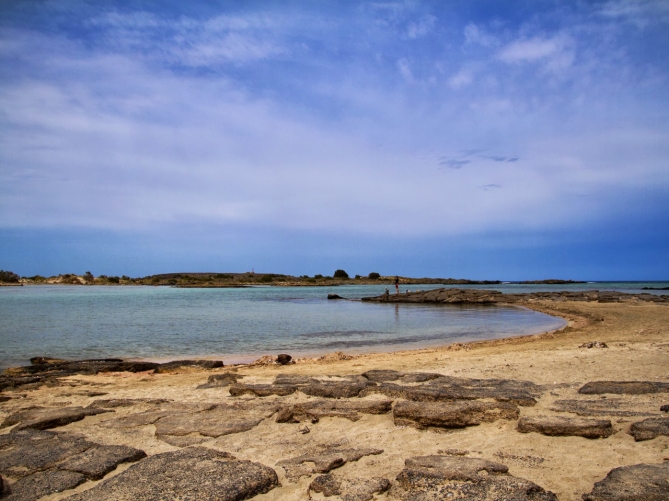
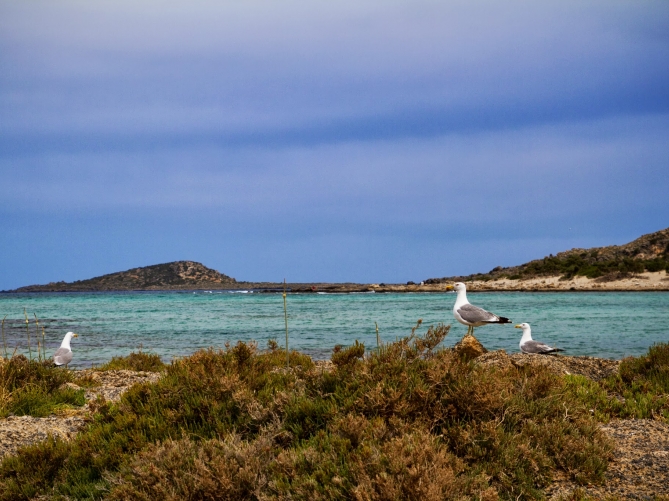
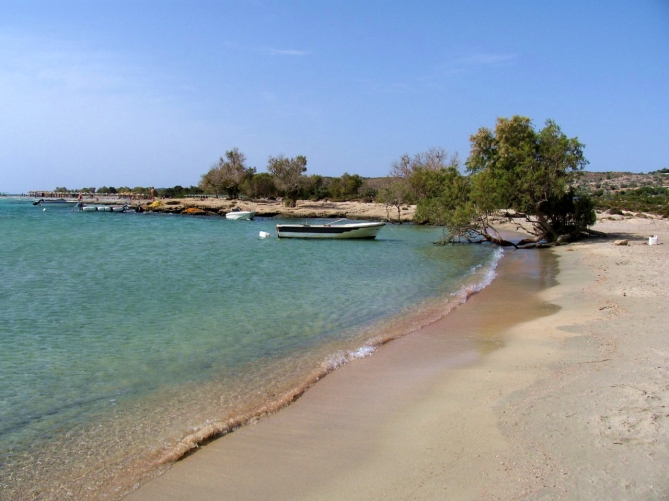
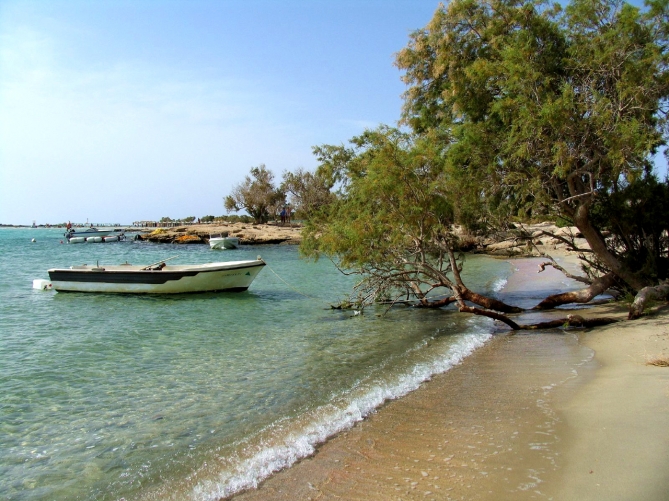
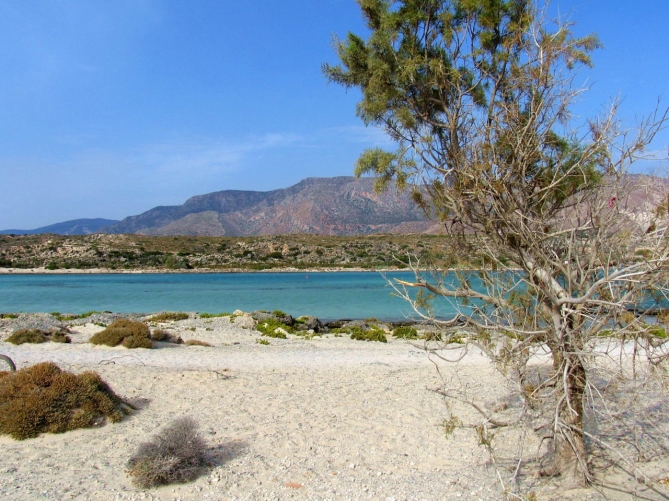
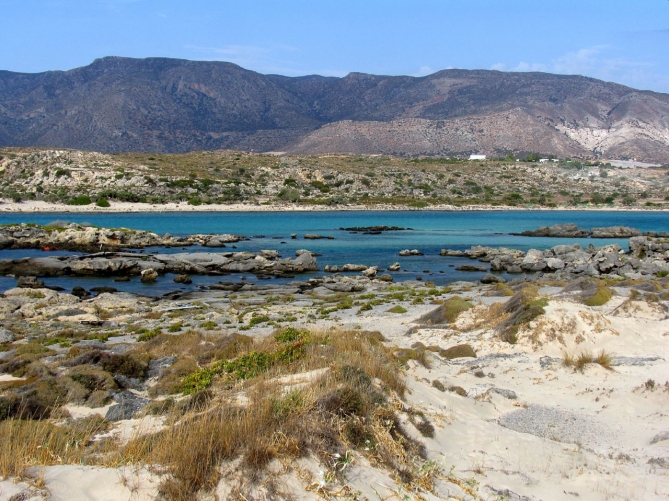
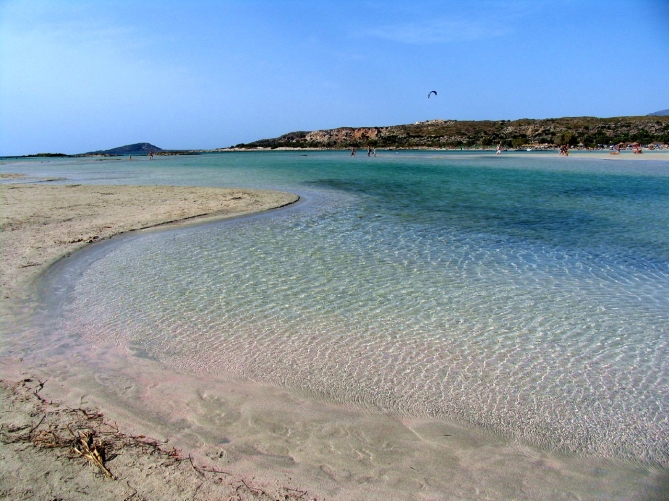
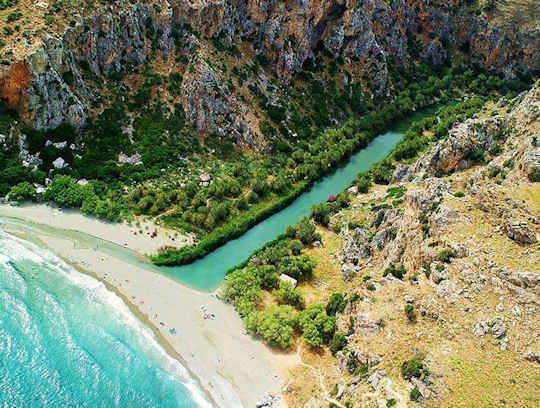 Is this real life?!? It is in Crete! This is Preveli Beach, which is located in the prefecture of Rethymnon, by the Preveli River and the famous palm forest. As with all the good Cretan beaches, there’s the easy way and the hard way to get here. The easy way is to take a boat from Plakias or Agia Galini. The hard way is to drive. From Plakias, you will drive to the Preveli Monastary, and about a mile before you reach the monastery, you will park your car and walk down a seemingly endless amount of steep stairs that lead to the beach. The best pictures are on this route. Apparently, you can also drive a dirt road leading to the nearby village of Drymiskiano Amoudi and walk a short 5 minute path to the beach. There are places to rent kayaks if you want to kayak down the river to get to the beach. Full Disclosure: I have not yet been to this beach yet (so this photo is borrowed from good ole’ Mr. Google), but it is on my list for when I return to Crete in May, so I will update this post then.
Is this real life?!? It is in Crete! This is Preveli Beach, which is located in the prefecture of Rethymnon, by the Preveli River and the famous palm forest. As with all the good Cretan beaches, there’s the easy way and the hard way to get here. The easy way is to take a boat from Plakias or Agia Galini. The hard way is to drive. From Plakias, you will drive to the Preveli Monastary, and about a mile before you reach the monastery, you will park your car and walk down a seemingly endless amount of steep stairs that lead to the beach. The best pictures are on this route. Apparently, you can also drive a dirt road leading to the nearby village of Drymiskiano Amoudi and walk a short 5 minute path to the beach. There are places to rent kayaks if you want to kayak down the river to get to the beach. Full Disclosure: I have not yet been to this beach yet (so this photo is borrowed from good ole’ Mr. Google), but it is on my list for when I return to Crete in May, so I will update this post then.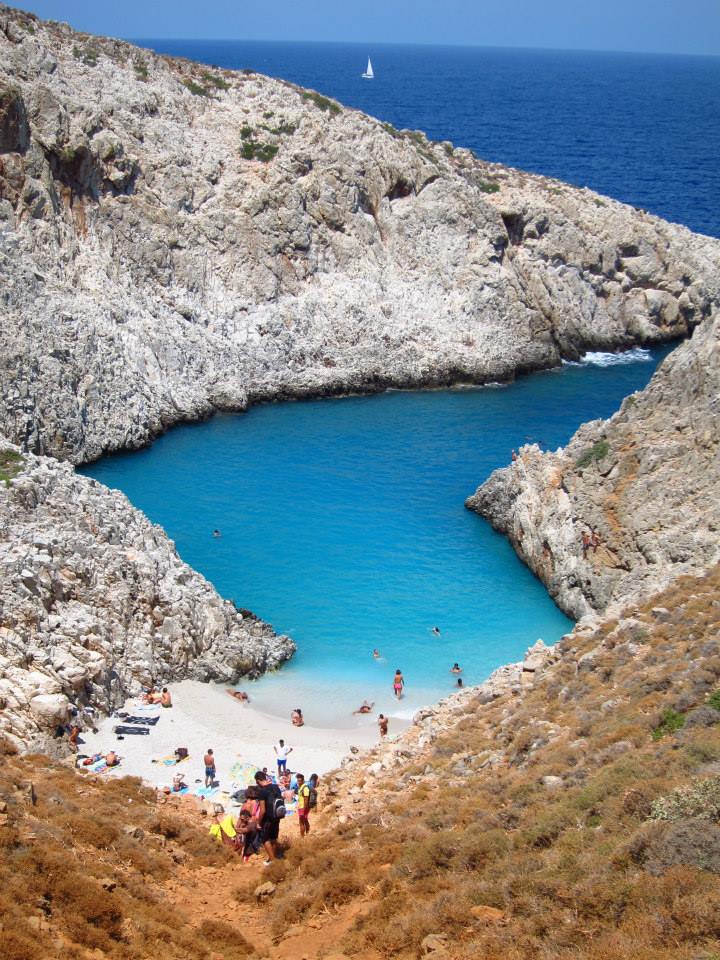 About 13 miles from the city of Chania, you will find this gem. To get here, drive towards Chania airport, and turn left towards village Chordaki and then follow the signs to Rizoskloko. Signage will lead you to the beach. The road is paved all the way, but the last part of the road is a small, winding mountain road with no guardrails. You will come to an area where you can leave your car, and then you set out on foot for about 15 minutes down a steep path of stairs to get to the beach. The beach gets very crowded in season, so go early. Also there are no amenities on this beach, so if you need it, bring it. The photos of this beach are brought to you courtesy of my god-sister, fellow wanderluster, and Cretan beach expert, Roula.
About 13 miles from the city of Chania, you will find this gem. To get here, drive towards Chania airport, and turn left towards village Chordaki and then follow the signs to Rizoskloko. Signage will lead you to the beach. The road is paved all the way, but the last part of the road is a small, winding mountain road with no guardrails. You will come to an area where you can leave your car, and then you set out on foot for about 15 minutes down a steep path of stairs to get to the beach. The beach gets very crowded in season, so go early. Also there are no amenities on this beach, so if you need it, bring it. The photos of this beach are brought to you courtesy of my god-sister, fellow wanderluster, and Cretan beach expert, Roula.
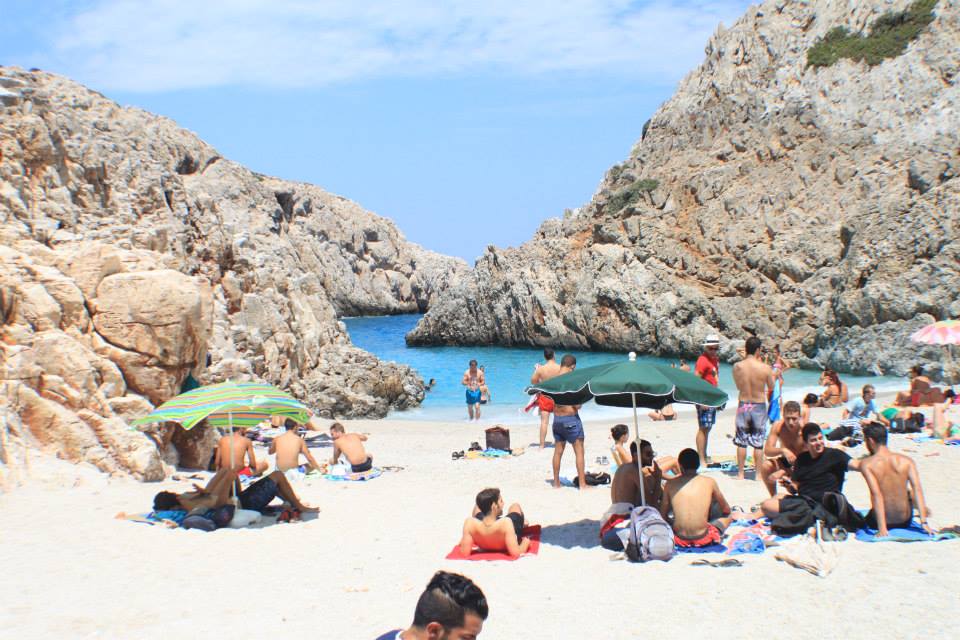
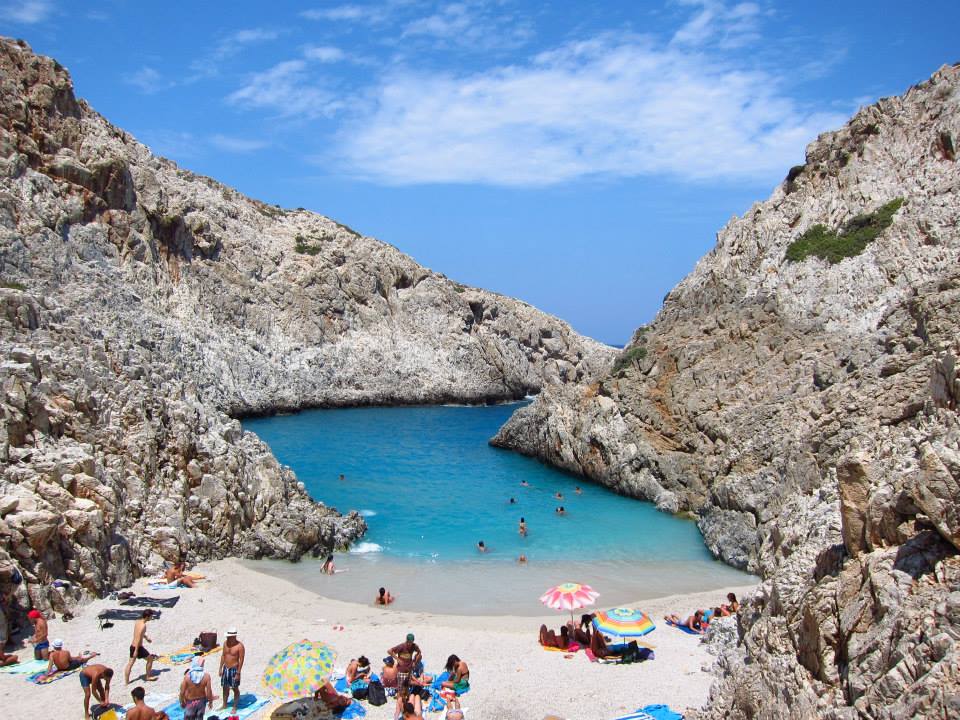
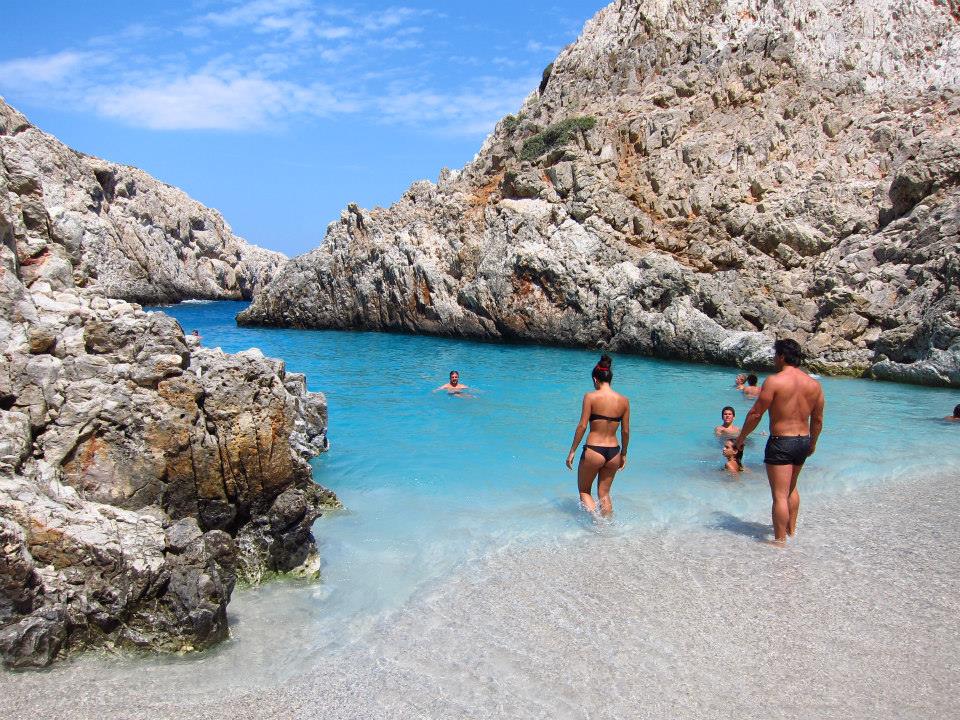
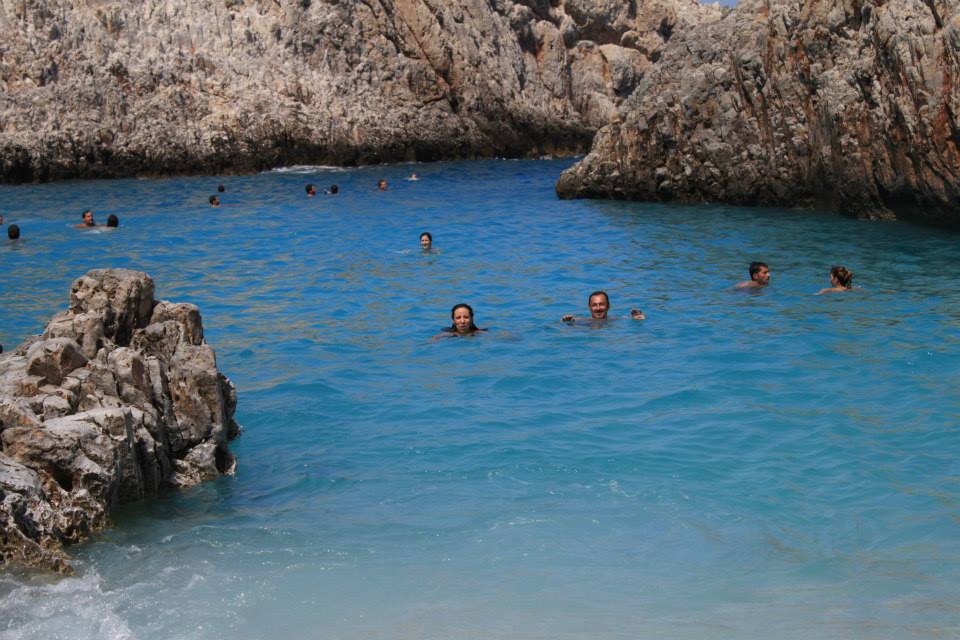
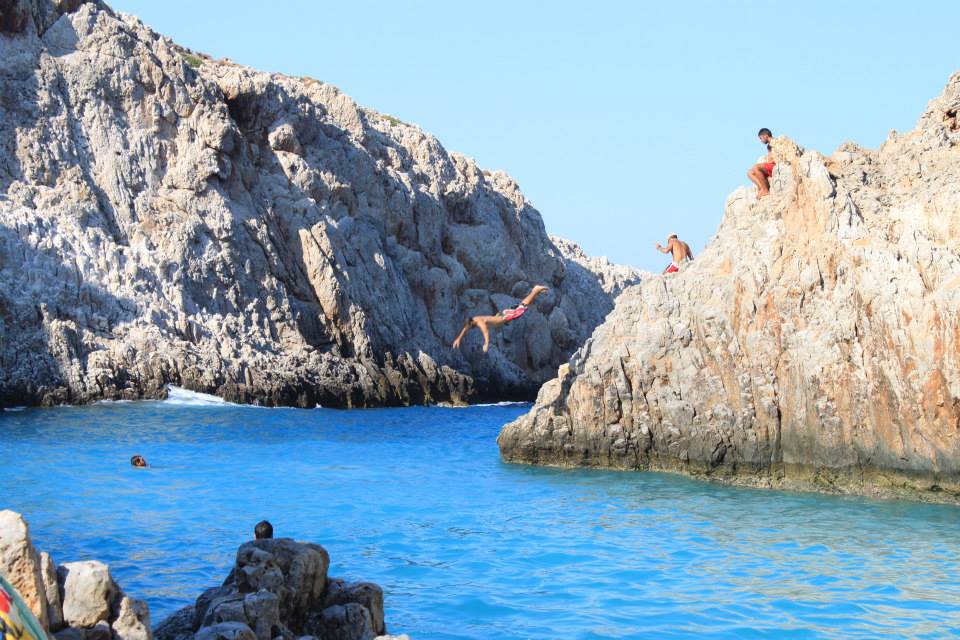
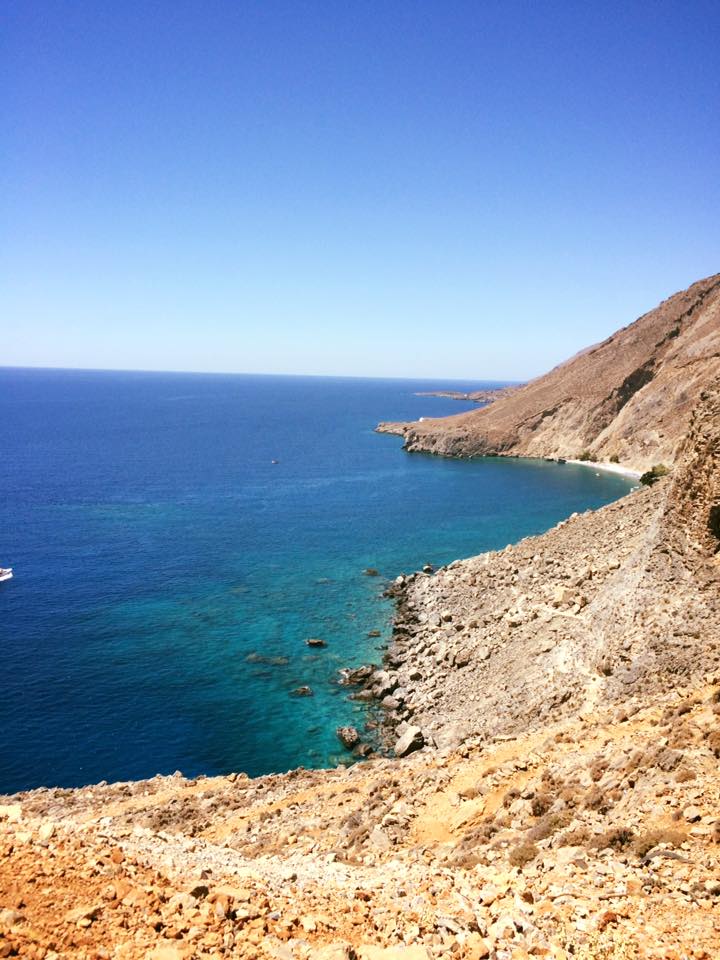 There are only two ways to get to this beach, which is located in Sfakia (where I am from) in the prefecture of Chania and literally translates into Sweet Water Beach- 1) drive, leave your car on the side of the road and walk this path about 30 minutes to the beach or 2) come by boat via the water taxis from Sfakia or Loutro. The beach is rocky and there is a small snack bar in the water perched on some rocks, but the water is crystal clear and cool.
There are only two ways to get to this beach, which is located in Sfakia (where I am from) in the prefecture of Chania and literally translates into Sweet Water Beach- 1) drive, leave your car on the side of the road and walk this path about 30 minutes to the beach or 2) come by boat via the water taxis from Sfakia or Loutro. The beach is rocky and there is a small snack bar in the water perched on some rocks, but the water is crystal clear and cool.
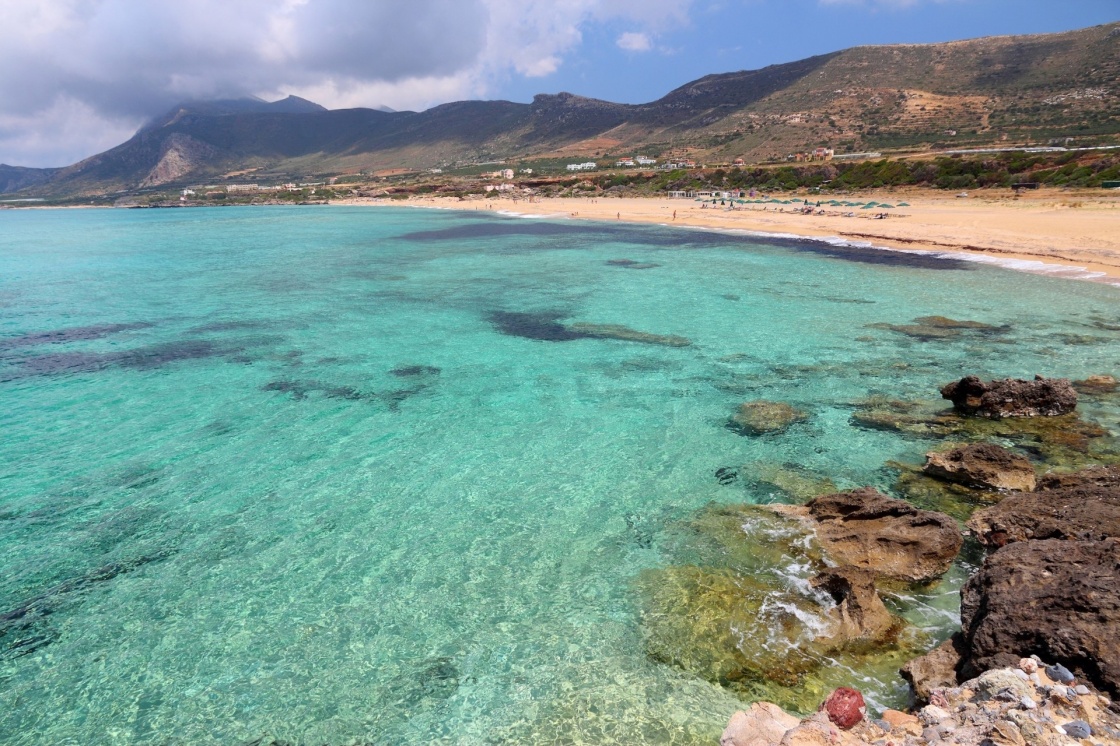 Like Elafonisi, Falasarna Beach, which is also located in the prefecture of Chania, is made up of several sandy beaches. Because it is on the west coast, this is a great beach to catch the sunset. The easiest way to get here is to drive the hour from Chania; otherwise, you can take the public bus, which runs routes during tourist season.
Like Elafonisi, Falasarna Beach, which is also located in the prefecture of Chania, is made up of several sandy beaches. Because it is on the west coast, this is a great beach to catch the sunset. The easiest way to get here is to drive the hour from Chania; otherwise, you can take the public bus, which runs routes during tourist season.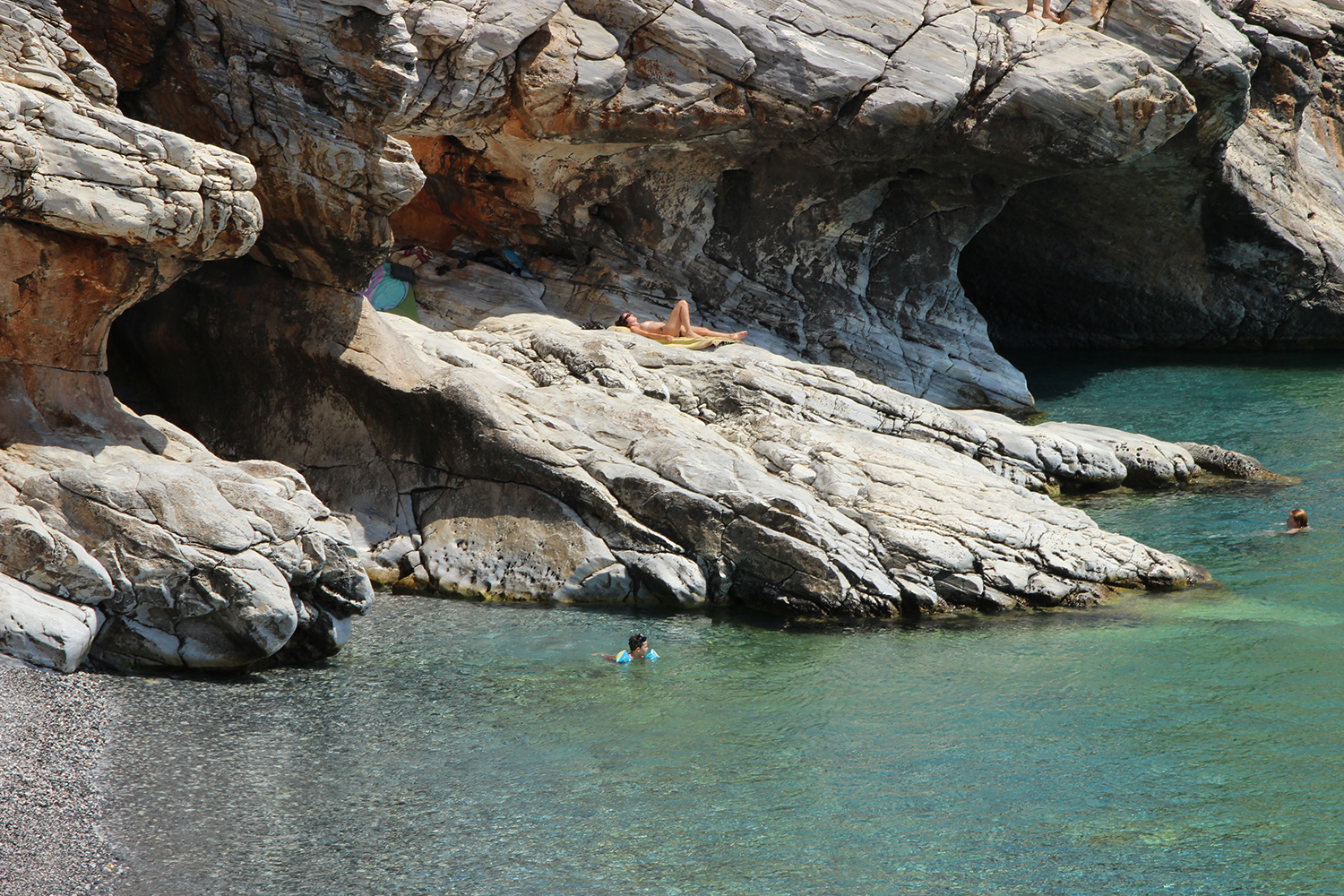 If you were brave enough to hike 4 hours through the Aradaina Gorge, guess where you ended up? Right here! Truthfully, you came to a road that had a passage for a steeper road down to the water which lead you here. This beach is also in Sfakia, about 53 miles from Chania. You can drive here (park your car up top on the side of the road and walk on down that steep path) or take a public bus to Sfakia and then take a boat over. There is a small tavern on the beach and a few umbrellas and sunbeds, but that is about it. There are some great caves to snorkel in, but the water is very deep.
If you were brave enough to hike 4 hours through the Aradaina Gorge, guess where you ended up? Right here! Truthfully, you came to a road that had a passage for a steeper road down to the water which lead you here. This beach is also in Sfakia, about 53 miles from Chania. You can drive here (park your car up top on the side of the road and walk on down that steep path) or take a public bus to Sfakia and then take a boat over. There is a small tavern on the beach and a few umbrellas and sunbeds, but that is about it. There are some great caves to snorkel in, but the water is very deep.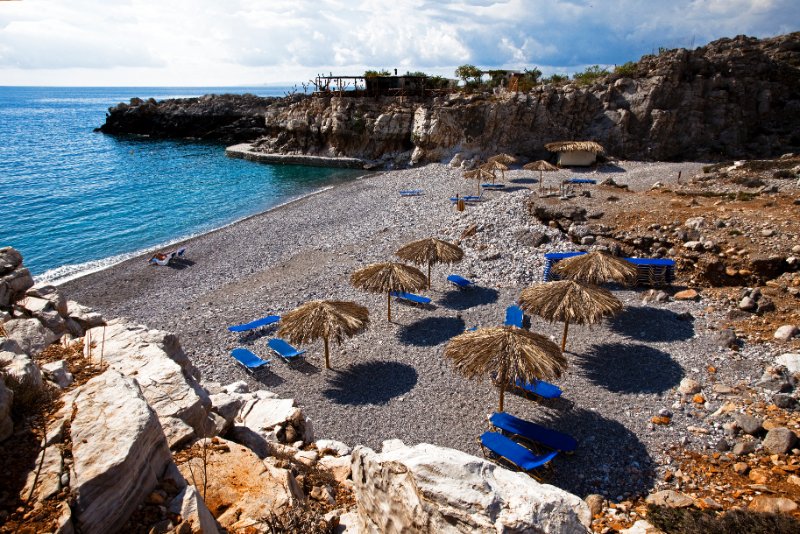
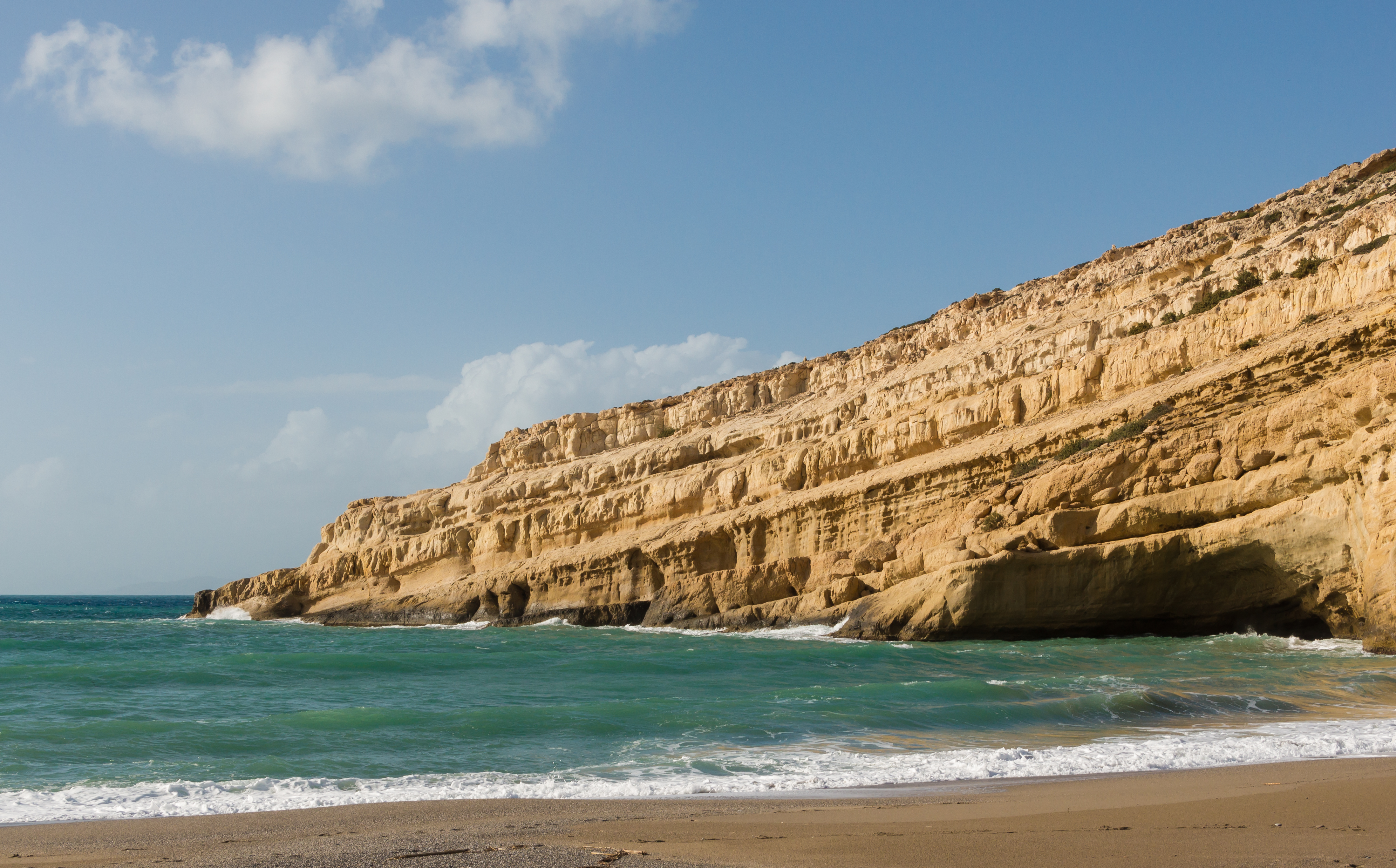
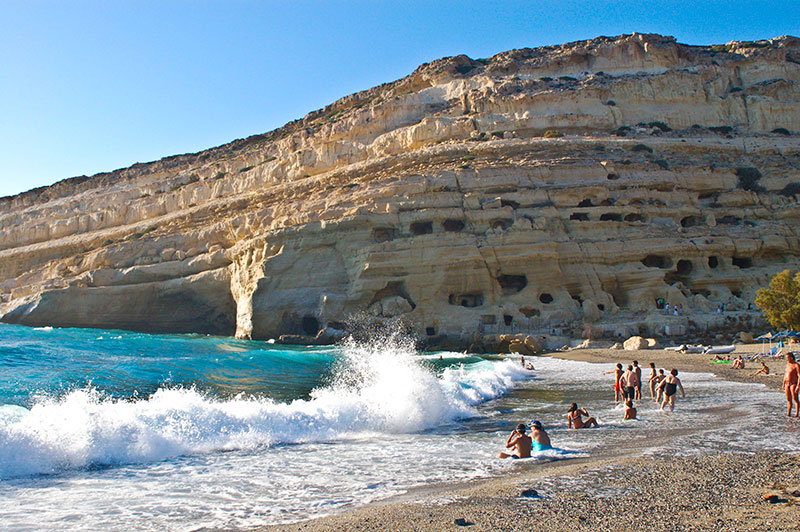
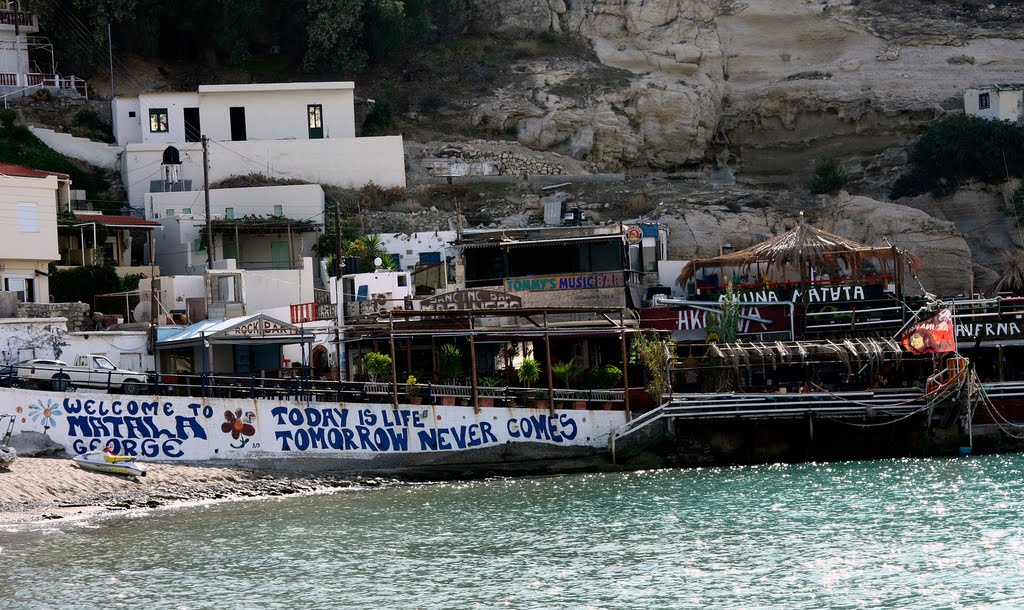
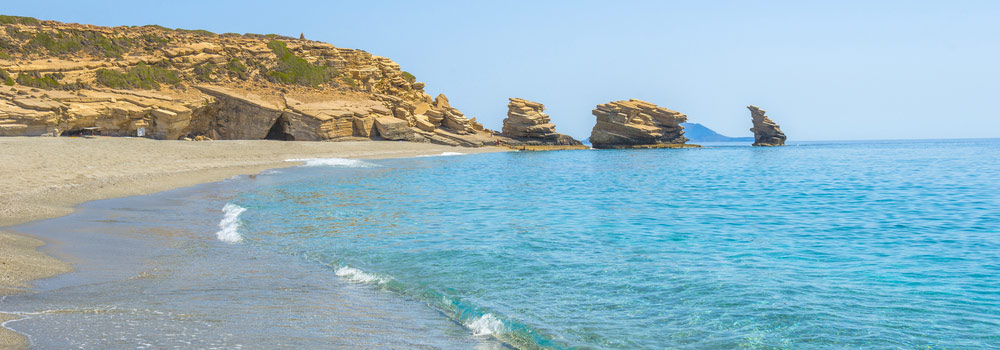
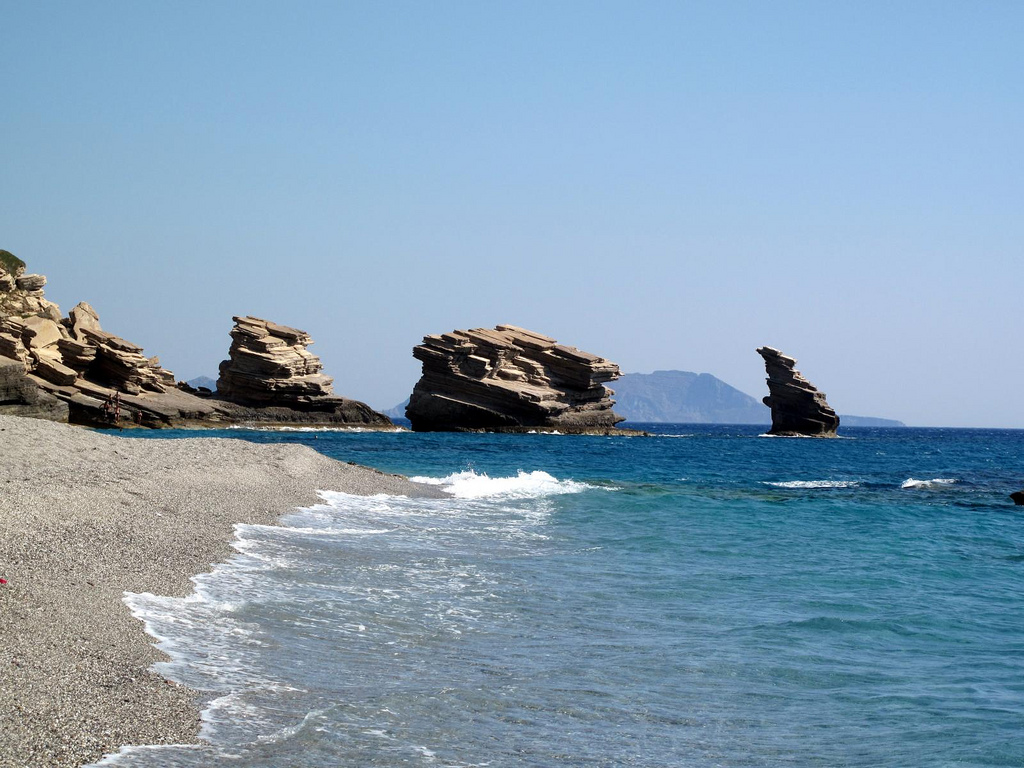
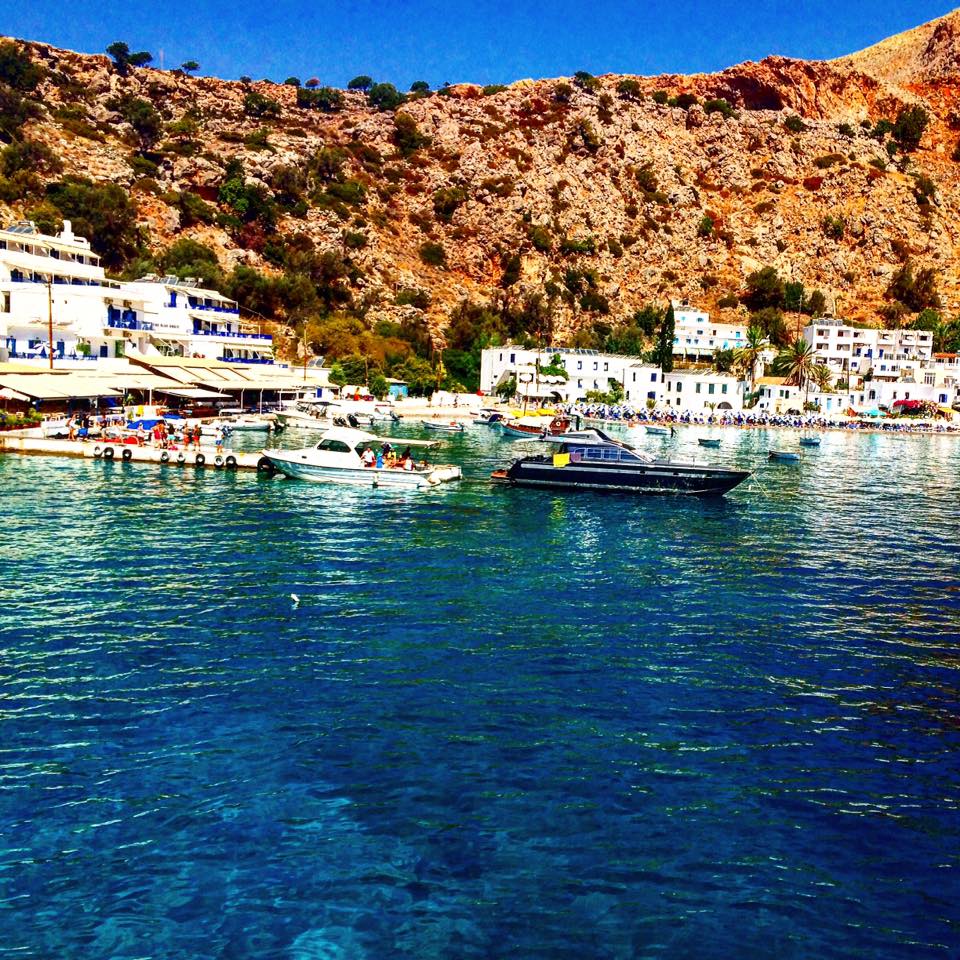 If you want to visit a true beach town, head to Loutro, in the prefecture of Chania. There are no cars here and no roads, just beaches, hotels, tavernas, and shops. There are only 2 ways to get here: 1) by foot and 2) by boat. You have to be a serious hiker to get here by foot. If that is you, take the bus (or drive) to Sfakia. You can start your hike here. In fact, you can visit Glyka Nera (number 5 above) first as you can start your hike here and the same trail will end at Loutro. This is a long hike and will likely take 3 or more hours. Alternatively, you can come to our village (Anopolis) from Sfakia, and start your hike basically from my house which sits at the foot of the mountain you need to climb up to get there. This is the center of Anopolis:
If you want to visit a true beach town, head to Loutro, in the prefecture of Chania. There are no cars here and no roads, just beaches, hotels, tavernas, and shops. There are only 2 ways to get here: 1) by foot and 2) by boat. You have to be a serious hiker to get here by foot. If that is you, take the bus (or drive) to Sfakia. You can start your hike here. In fact, you can visit Glyka Nera (number 5 above) first as you can start your hike here and the same trail will end at Loutro. This is a long hike and will likely take 3 or more hours. Alternatively, you can come to our village (Anopolis) from Sfakia, and start your hike basically from my house which sits at the foot of the mountain you need to climb up to get there. This is the center of Anopolis: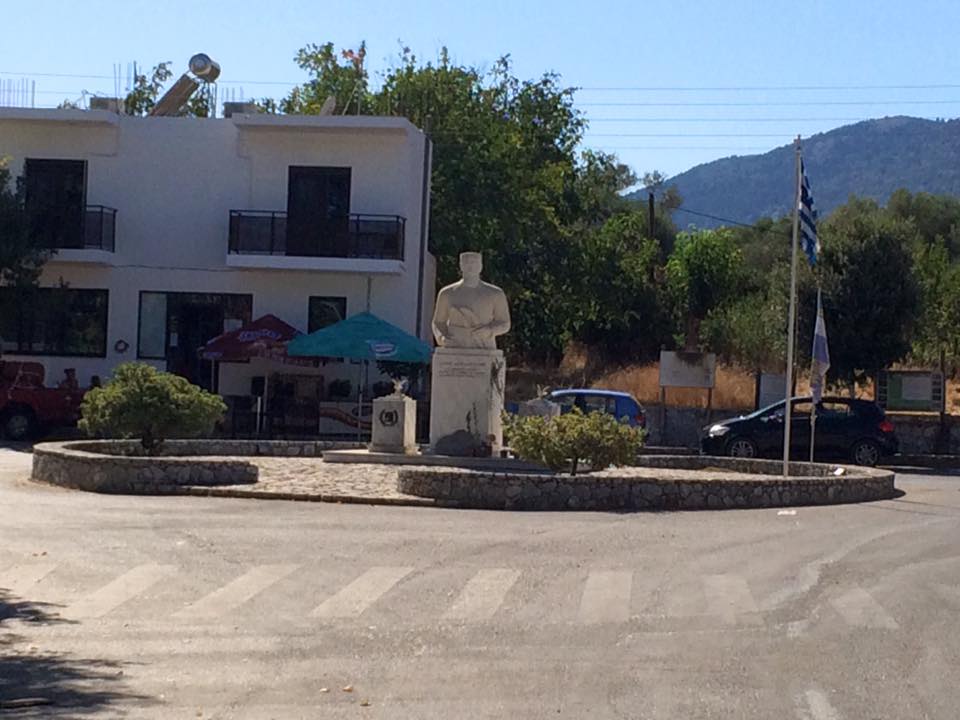 Before you get to the center, on the left hand side is my cousin’s bakery:
Before you get to the center, on the left hand side is my cousin’s bakery: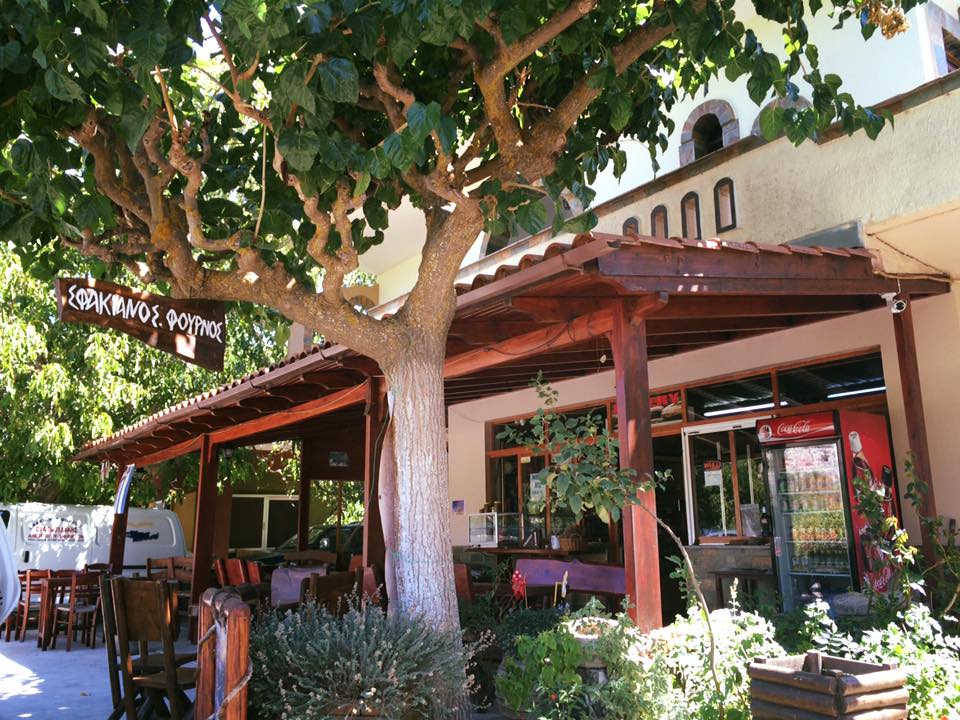
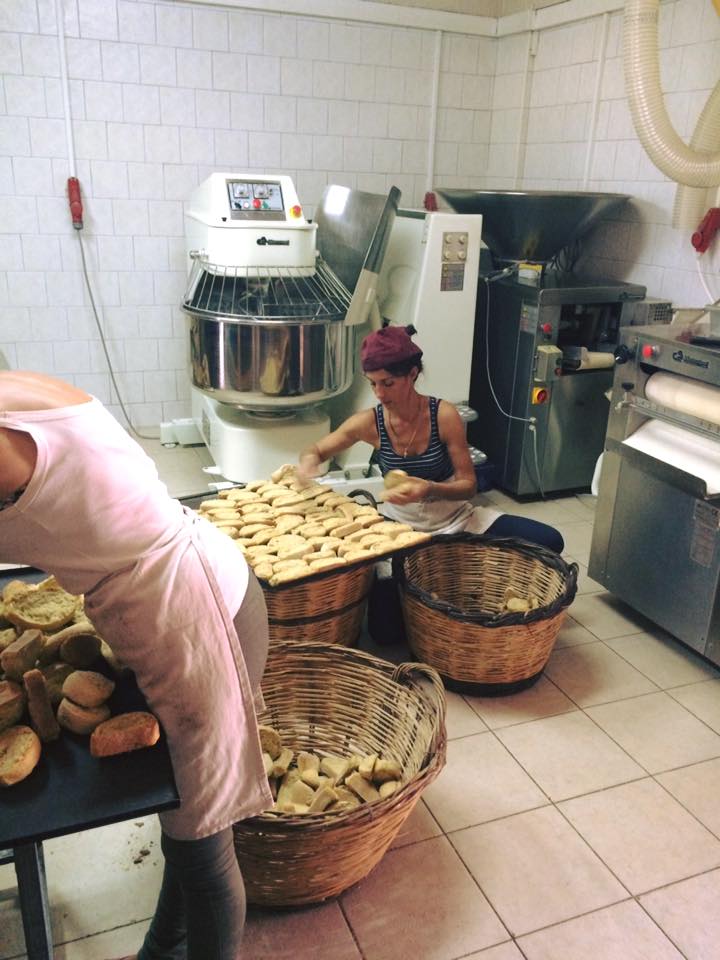
 She makes everything from scratch everyday. Her goods are delicious. She also harvests her own honey, which is life changing. Ask her to make you a Sfakian pie, stuffed with mizithra cheese from our cheese factory.
She makes everything from scratch everyday. Her goods are delicious. She also harvests her own honey, which is life changing. Ask her to make you a Sfakian pie, stuffed with mizithra cheese from our cheese factory.  Once you are at the center of Anopolis, stay to the left of the circle and then take the road to the right, you’ll be on your way. After passing about 10 houses, you will be at the foot of the mountain. If you see a black BMW with a Florida license plate, you’ll know you are in the right place, at my house! Stop in and say hi to my dad, George, and I bet he will cut you some
Once you are at the center of Anopolis, stay to the left of the circle and then take the road to the right, you’ll be on your way. After passing about 10 houses, you will be at the foot of the mountain. If you see a black BMW with a Florida license plate, you’ll know you are in the right place, at my house! Stop in and say hi to my dad, George, and I bet he will cut you some 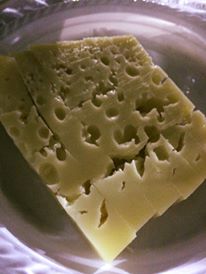 This cheese is legendary! You can only get it in Crete. There is an entire festival held in August in its honor! I’m not kidding:
This cheese is legendary! You can only get it in Crete. There is an entire festival held in August in its honor! I’m not kidding: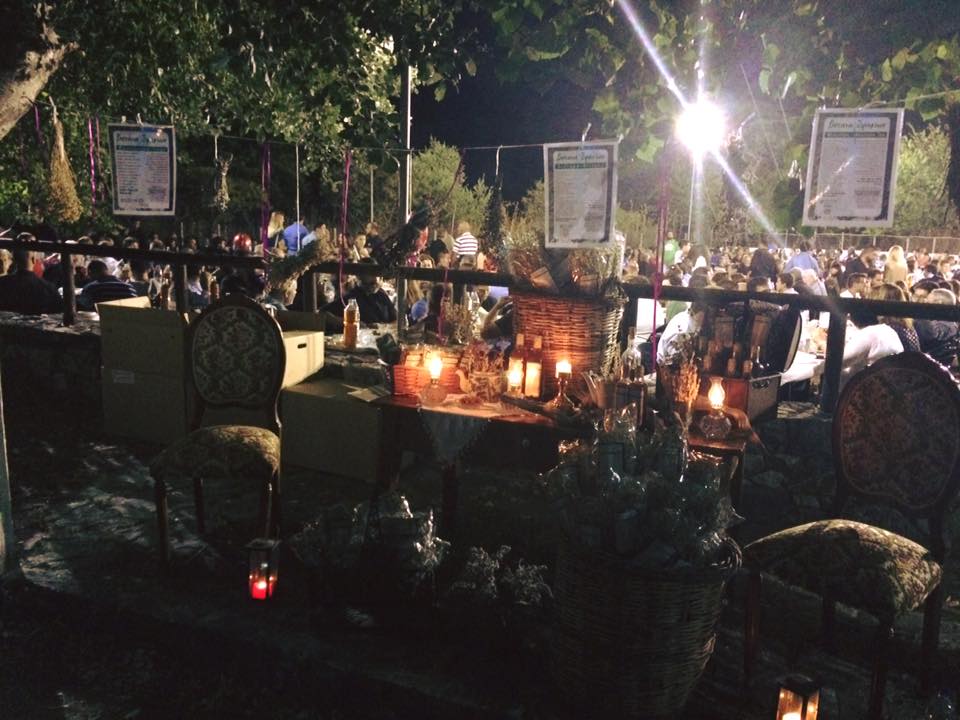 This is my uncle Andrea, who, with the help of my dad, makes the cheese:
This is my uncle Andrea, who, with the help of my dad, makes the cheese: Next thing you know, this will be your situation (by the way, you are supposed to dip the cheese in the honey!):
Next thing you know, this will be your situation (by the way, you are supposed to dip the cheese in the honey!): He may even take you out back and show you some of our goats!
He may even take you out back and show you some of our goats!  After fueling up for your hike, you will be on your way! The hike will take about 2 hours. Go straight through the gate below to start your Loutro hike, or stay on the path to the right, and climb up to the church at the top before heading down and on to Loutro.
After fueling up for your hike, you will be on your way! The hike will take about 2 hours. Go straight through the gate below to start your Loutro hike, or stay on the path to the right, and climb up to the church at the top before heading down and on to Loutro.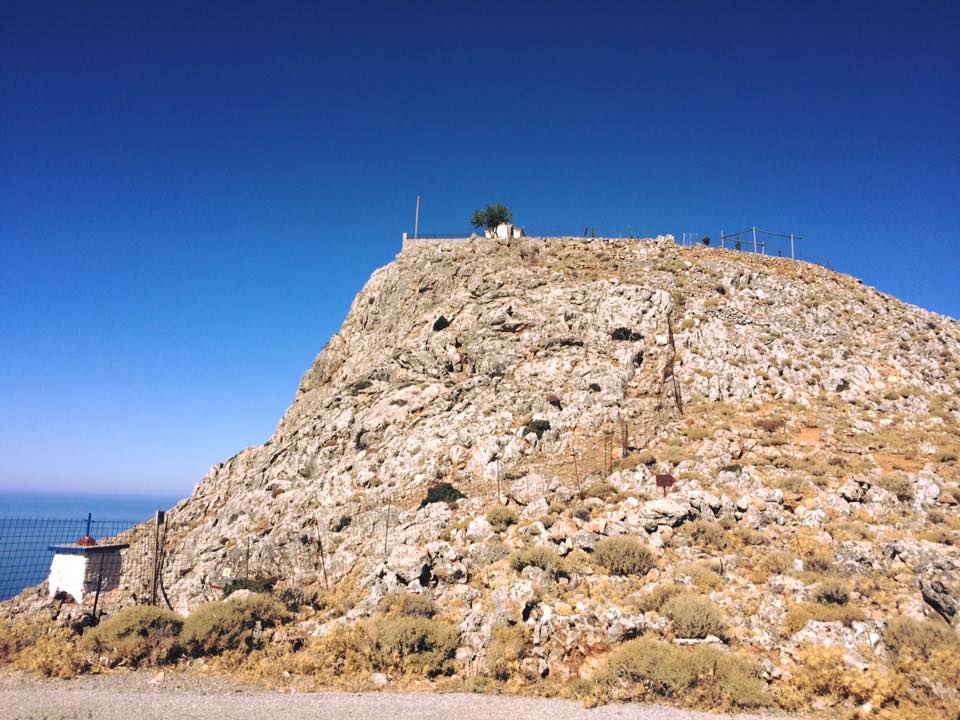
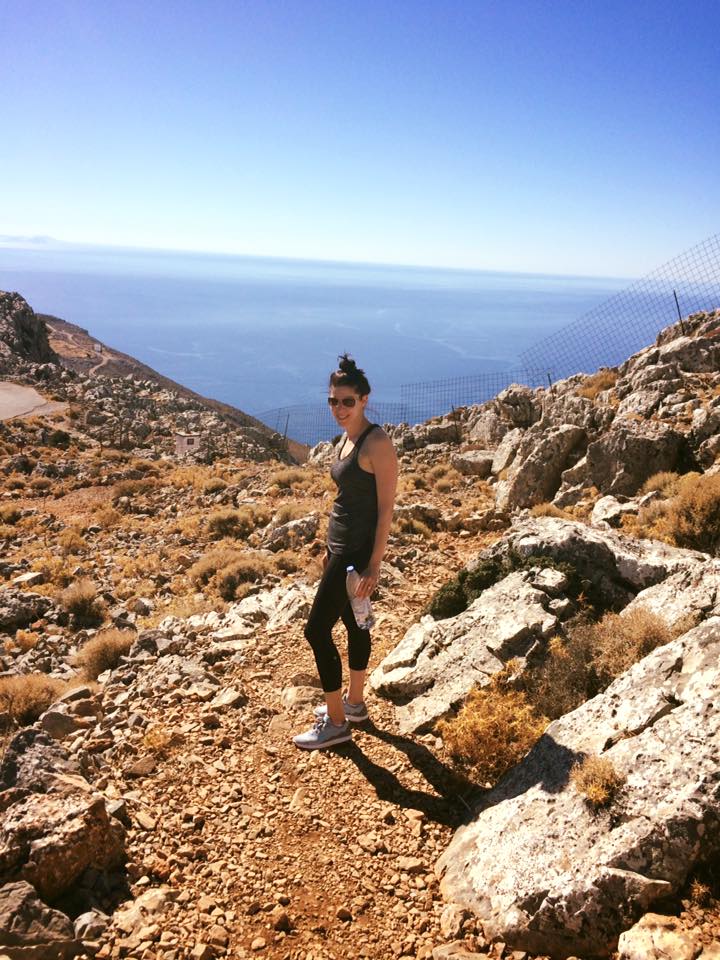 If you chose to the visit the small church on top of the mountain, you will come through this gate. There are amazing views from up here.
If you chose to the visit the small church on top of the mountain, you will come through this gate. There are amazing views from up here.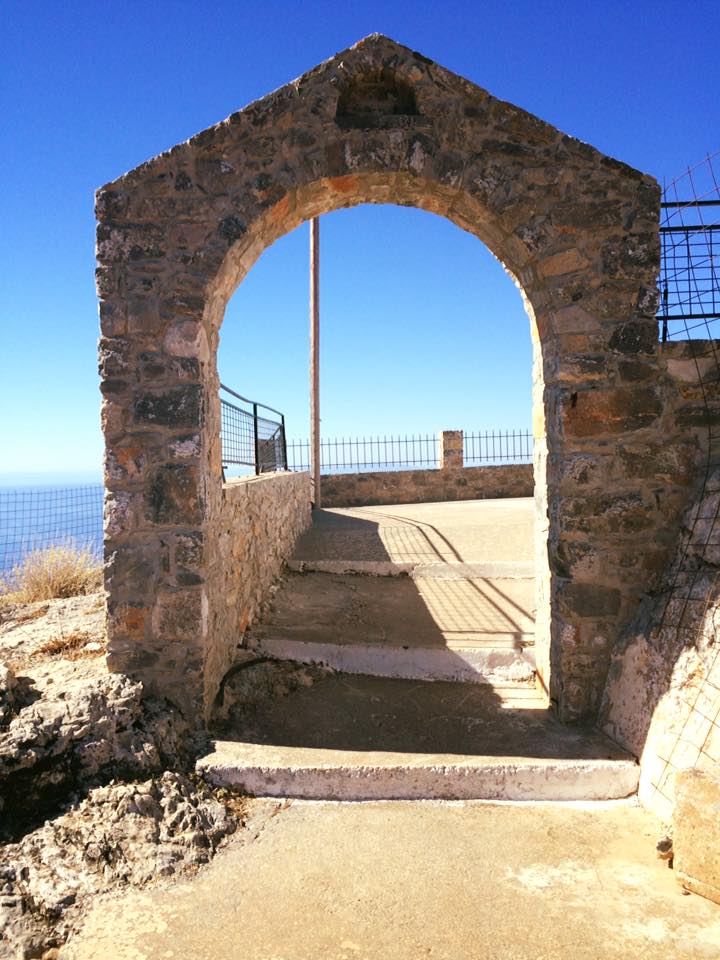
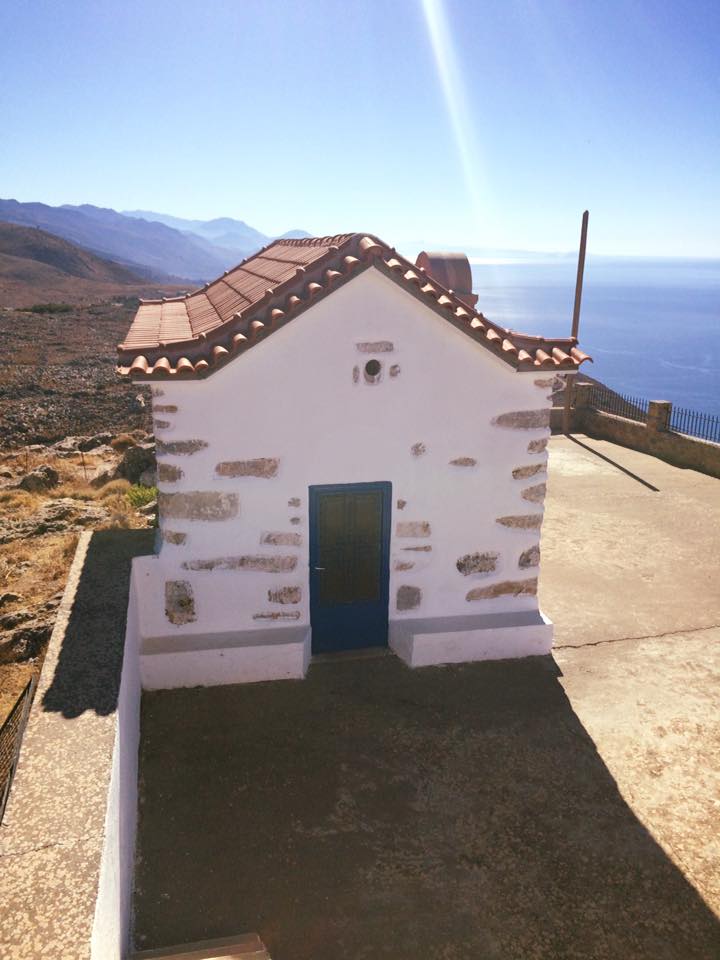
 After your visit look for this cross on the bottom of the small path leading to the church and across from this cross will be a rock that shows you the way.
After your visit look for this cross on the bottom of the small path leading to the church and across from this cross will be a rock that shows you the way.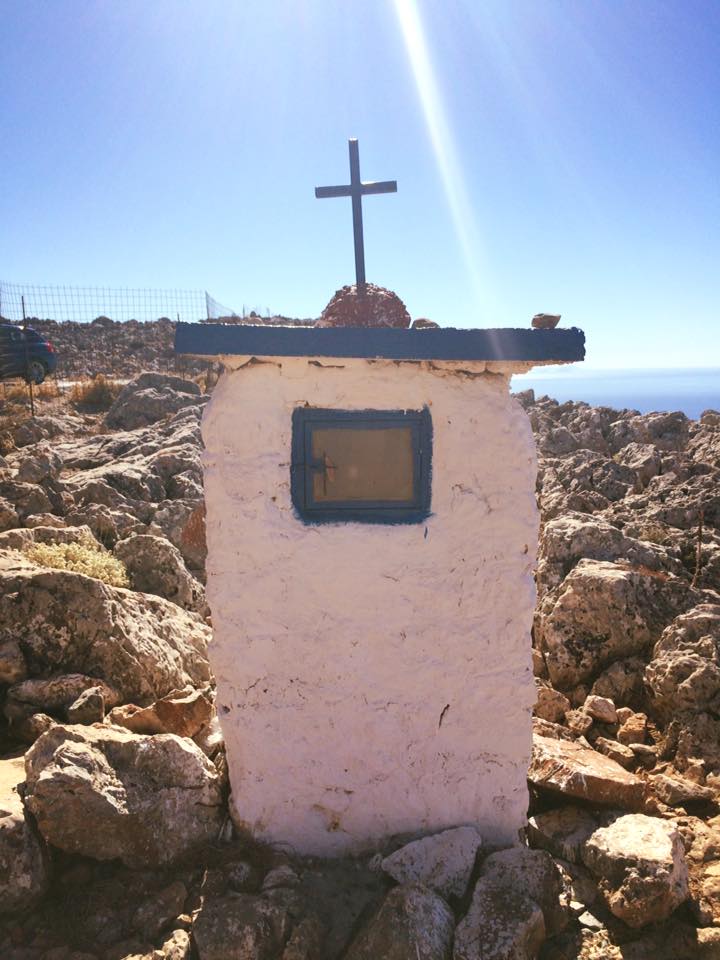
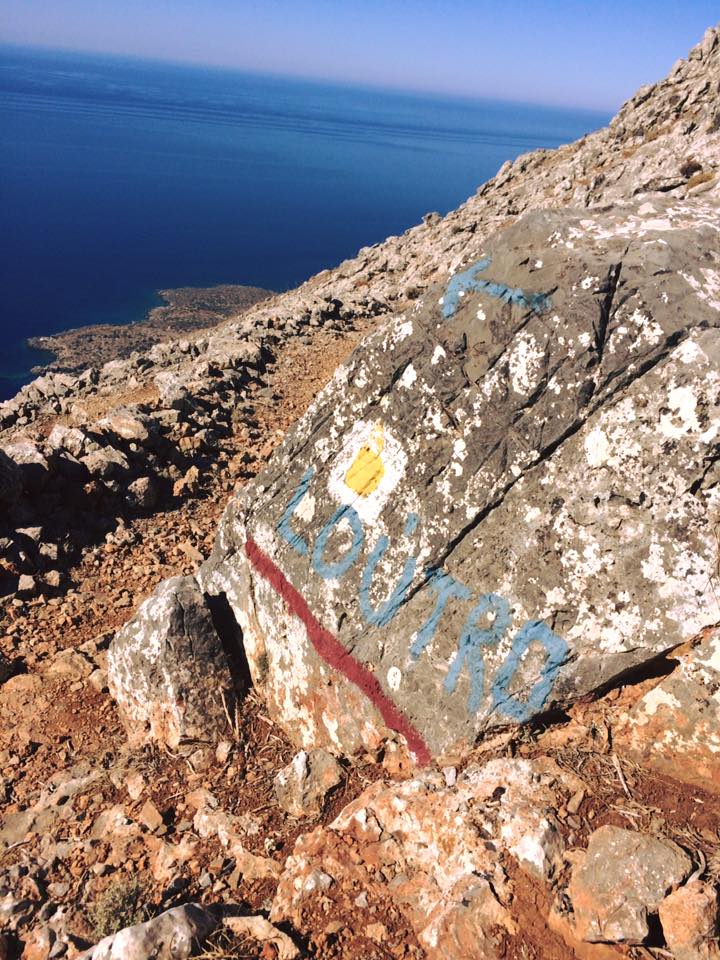 You are heading here:
You are heading here: 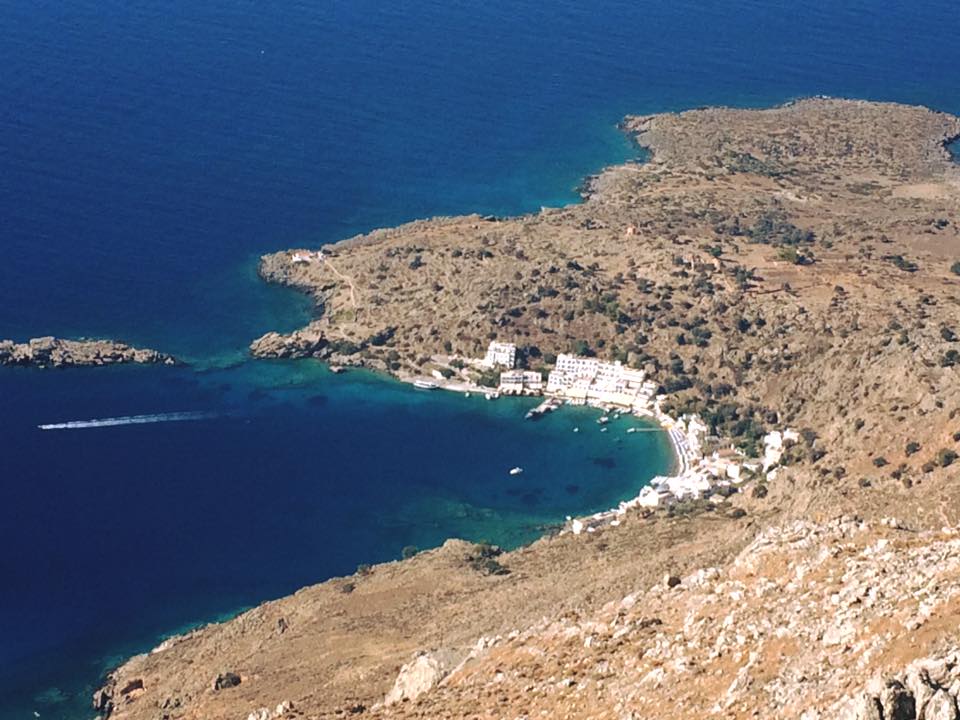 If you opt for the easier route, you can take the
If you opt for the easier route, you can take the 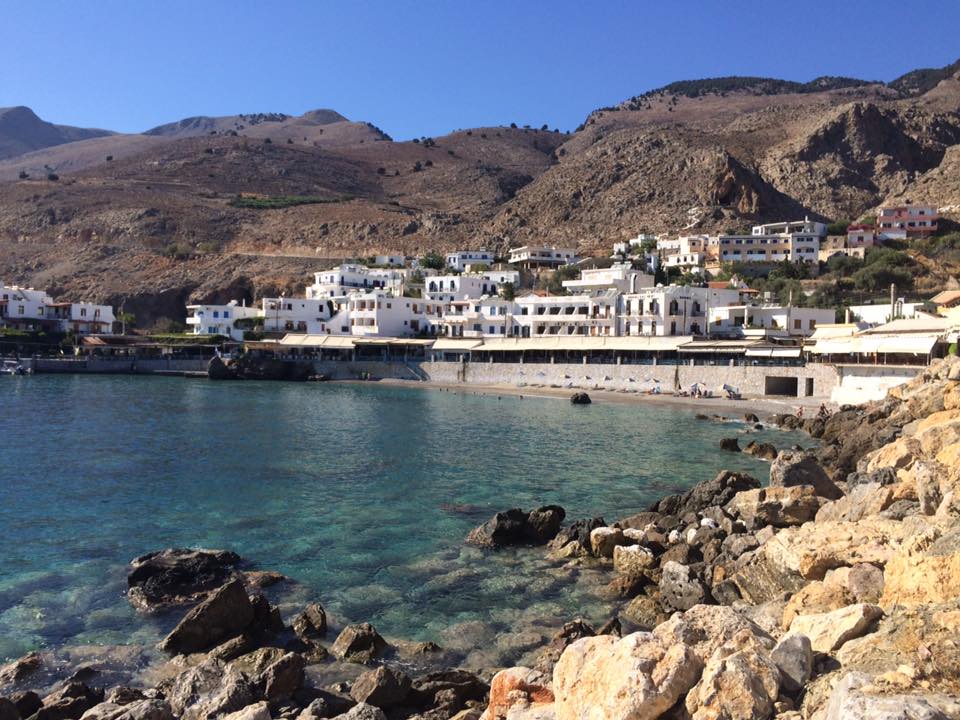 The ferry leaves from here in Sfakia:
The ferry leaves from here in Sfakia: The ticket office is before you reach this landing:
The ticket office is before you reach this landing: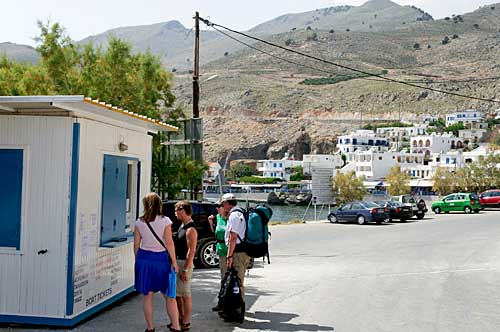 Before you reach the ticket kiosk, there is a small ocean-side snack bar where you can stop in for a delicious gyro and wait for the ferry to arrive.
Before you reach the ticket kiosk, there is a small ocean-side snack bar where you can stop in for a delicious gyro and wait for the ferry to arrive.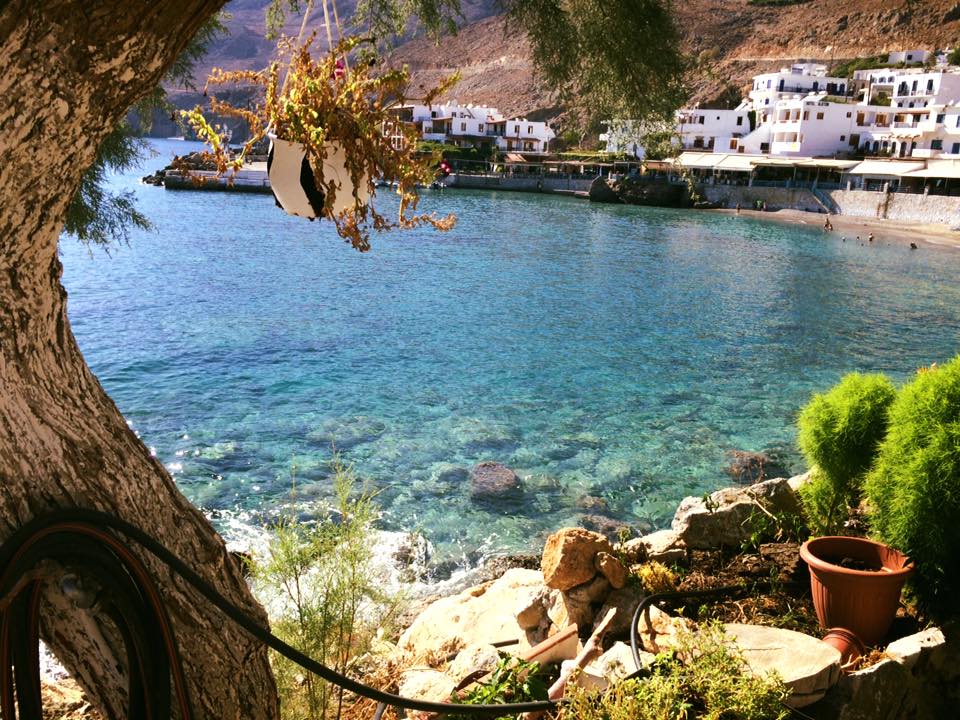
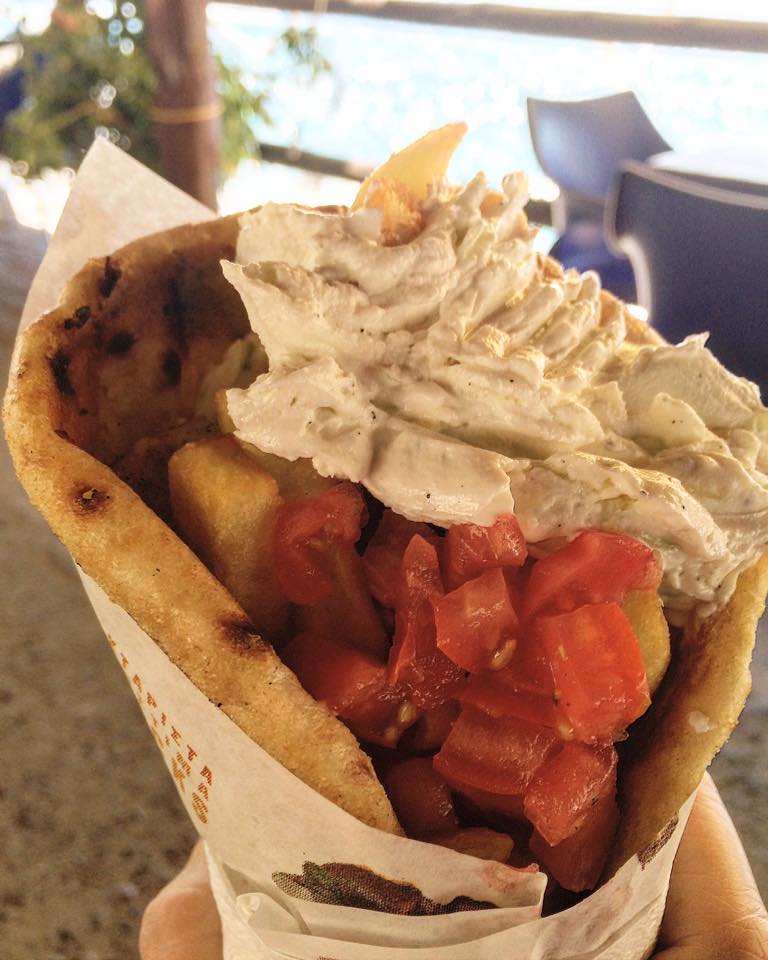 Once you board the ferry, in about 20 minutes, you will reach Loutro.
Once you board the ferry, in about 20 minutes, you will reach Loutro.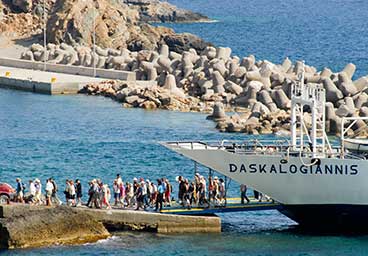
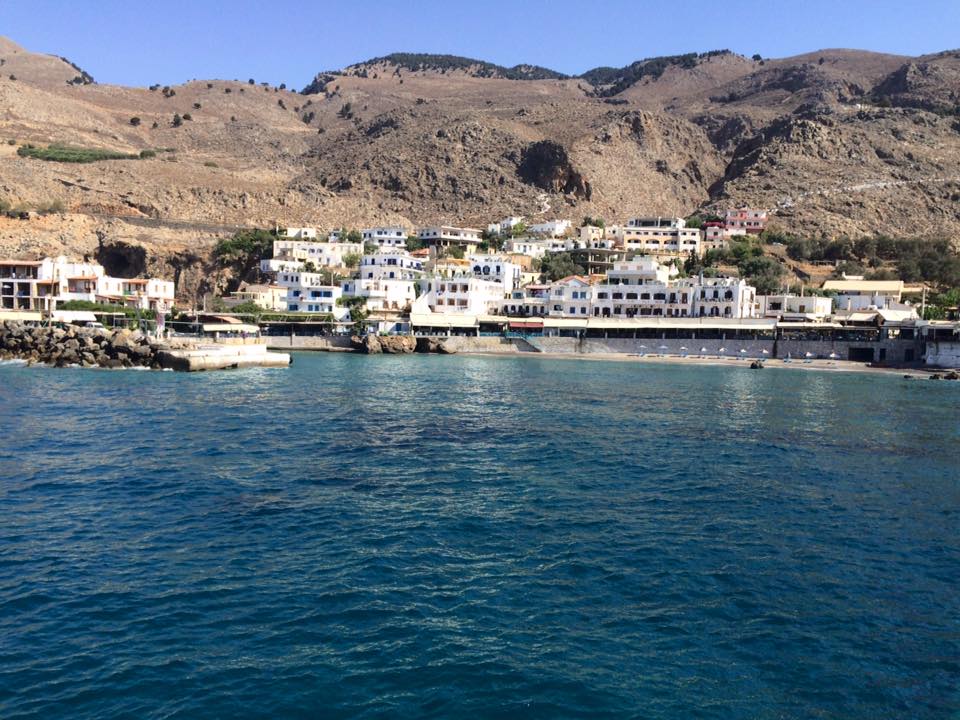 Most people walk the semi-circle and stop at the first beach. If you keep going all the way to the end, there is another beach next to some huge rocks, which offer nice snorkeling opportunities, and this beach is less crowded. There is also a snack bar right near the beach with a restroom. The water is cool and the beaches are rocky.
Most people walk the semi-circle and stop at the first beach. If you keep going all the way to the end, there is another beach next to some huge rocks, which offer nice snorkeling opportunities, and this beach is less crowded. There is also a snack bar right near the beach with a restroom. The water is cool and the beaches are rocky.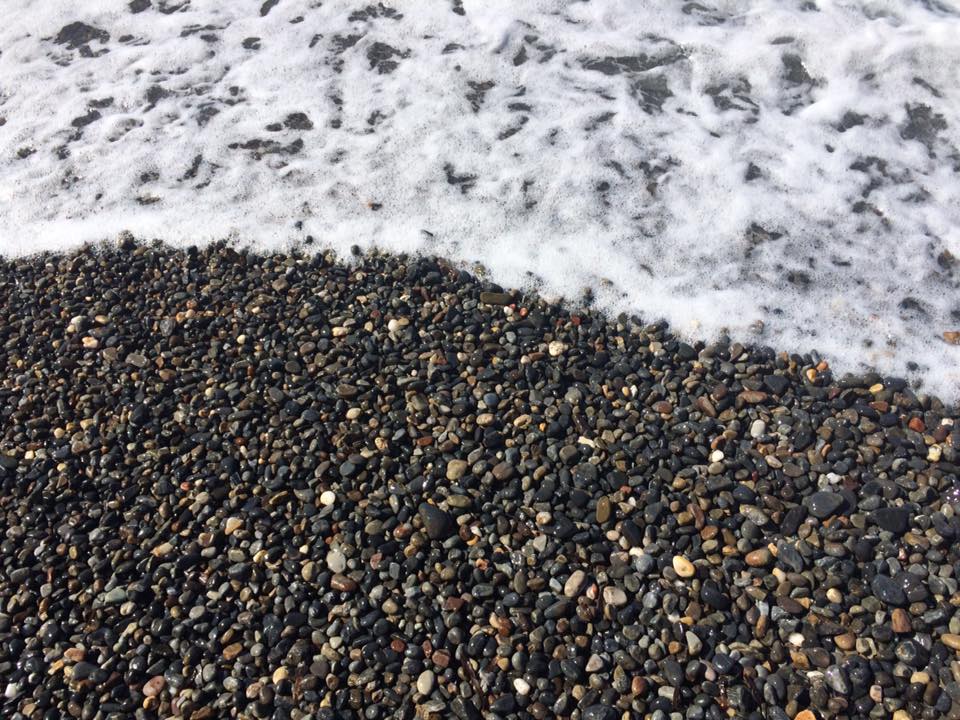 If you miss the ferry back or want to stay for a while, book a room at my family’s hotel on the island, and tell my cousin George that I sent you!
If you miss the ferry back or want to stay for a while, book a room at my family’s hotel on the island, and tell my cousin George that I sent you!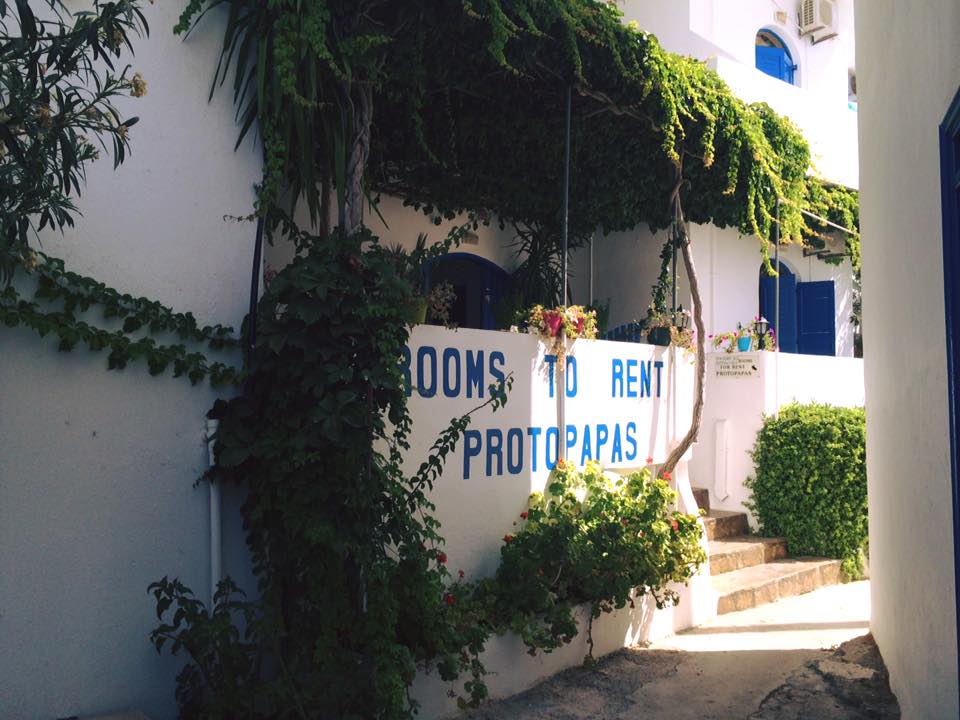 Also, there is no nude or topless bathing in Loutro.
Also, there is no nude or topless bathing in Loutro.
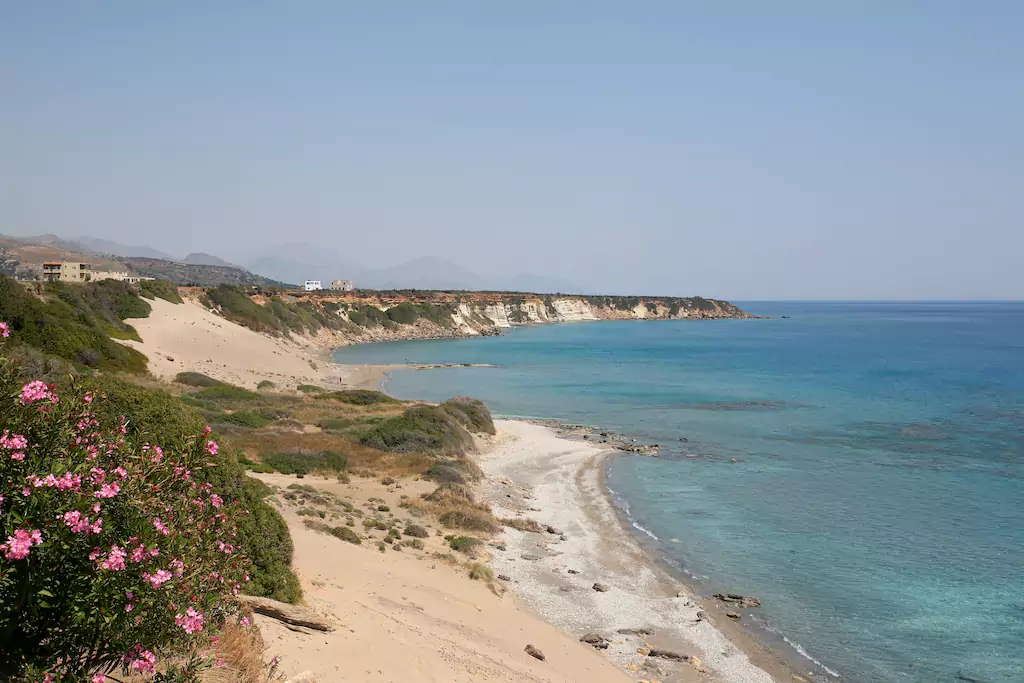 If you are looking for long sandy beaches that are suitable for families with children and have an added bonus of ruins to explore, then you have found your paradise. Frangokastello is located in the prefecture of Chania. You can get here by bus, car, or boat. There are a few beaches you can visit in this area. The first is right at the foot of an ancient castle.
If you are looking for long sandy beaches that are suitable for families with children and have an added bonus of ruins to explore, then you have found your paradise. Frangokastello is located in the prefecture of Chania. You can get here by bus, car, or boat. There are a few beaches you can visit in this area. The first is right at the foot of an ancient castle.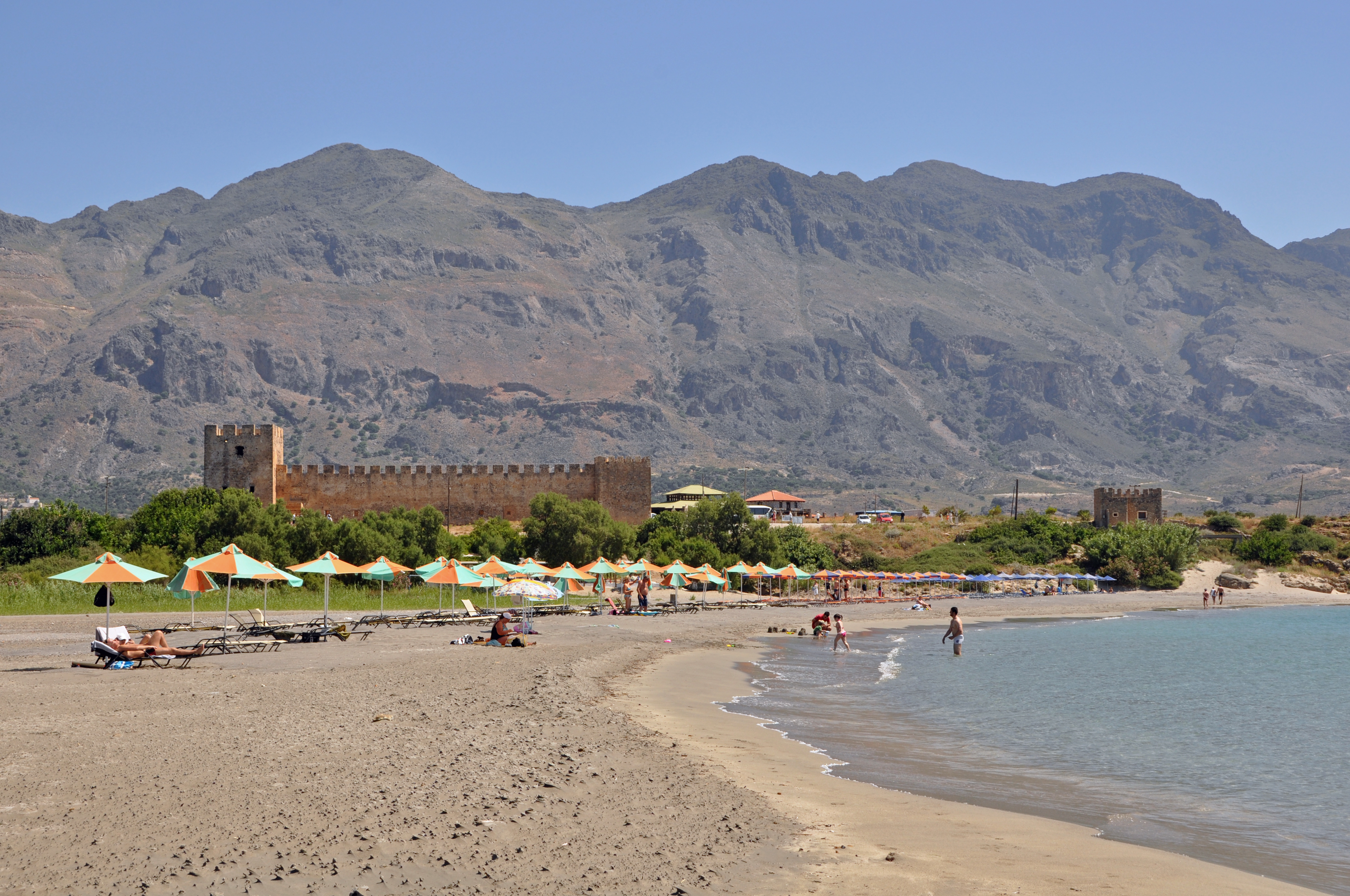 Either before or after the beach, make sure to stop in and explore the castle.
Either before or after the beach, make sure to stop in and explore the castle.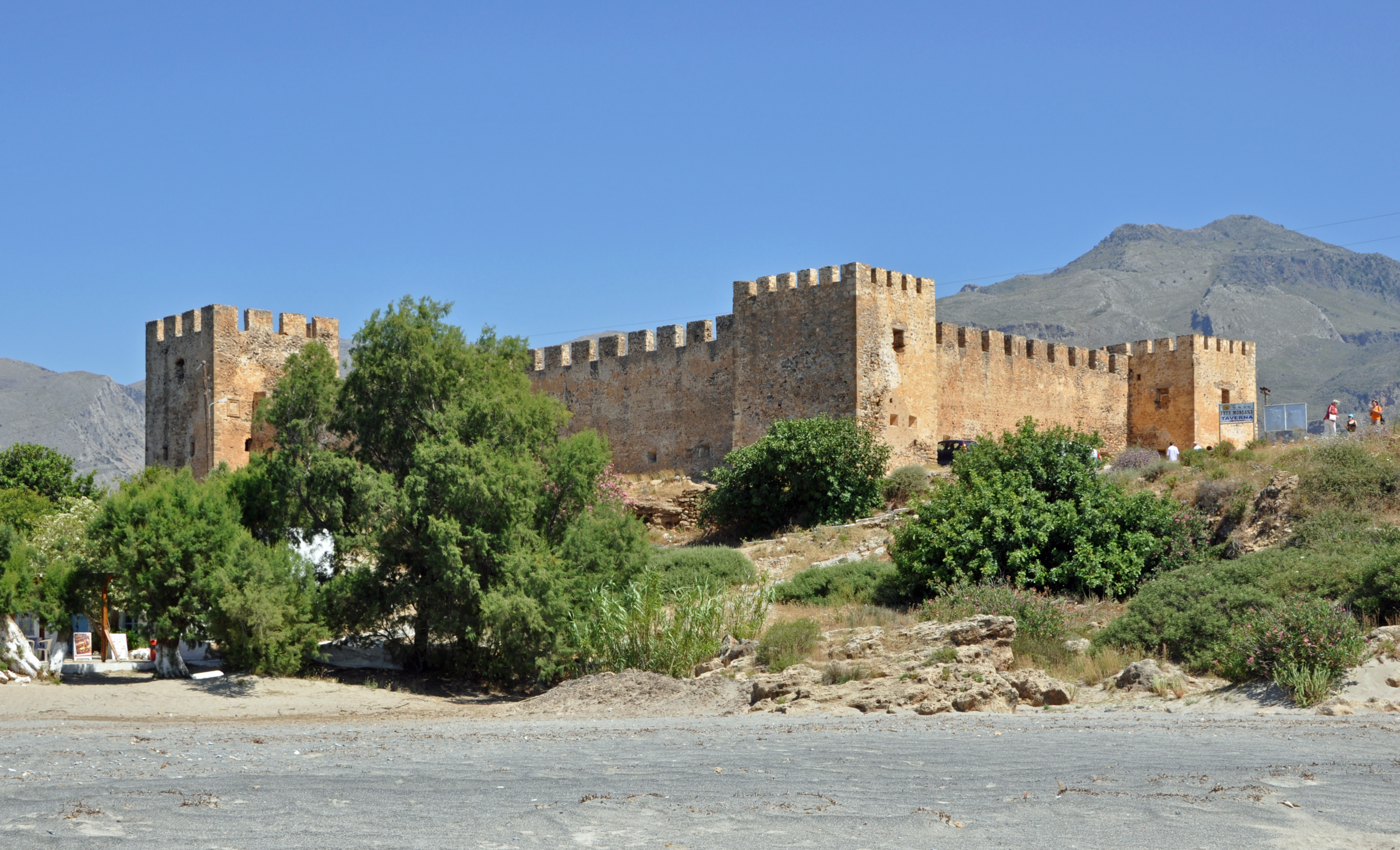
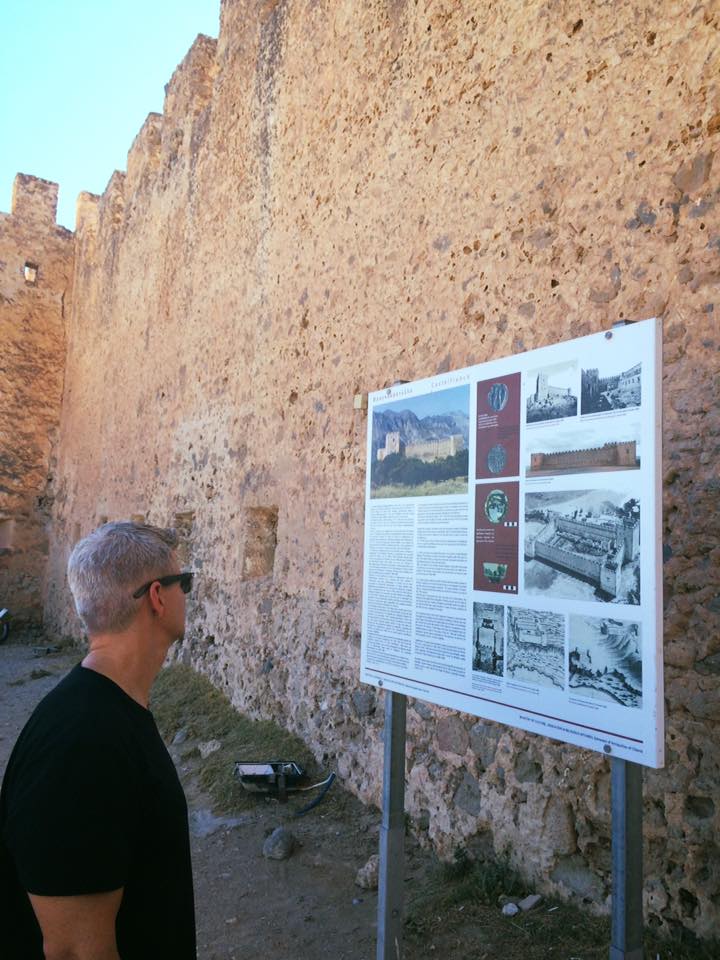
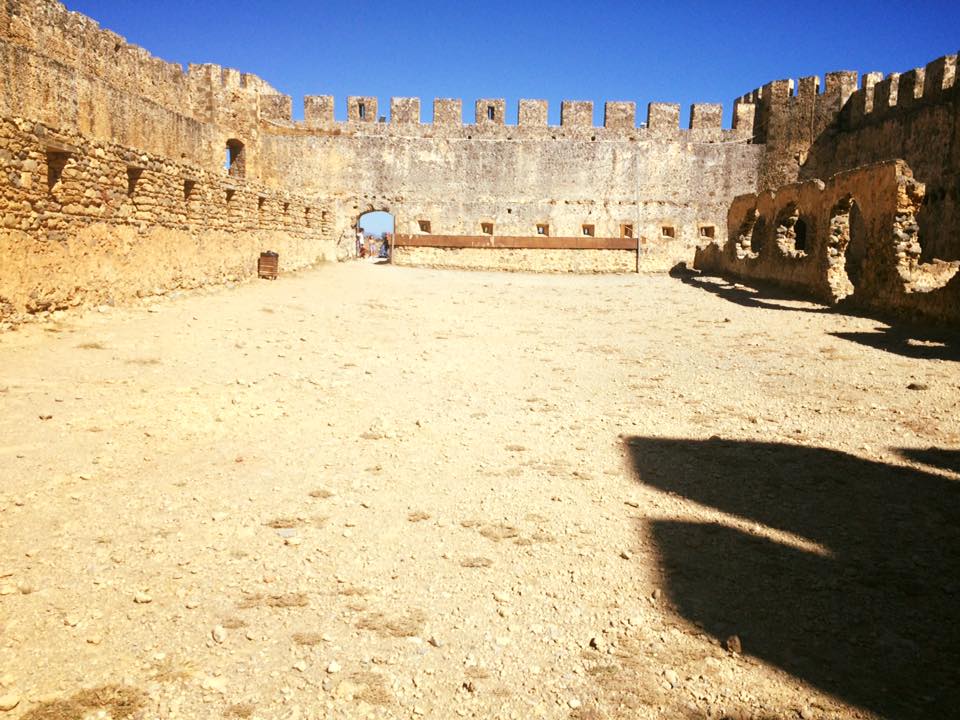
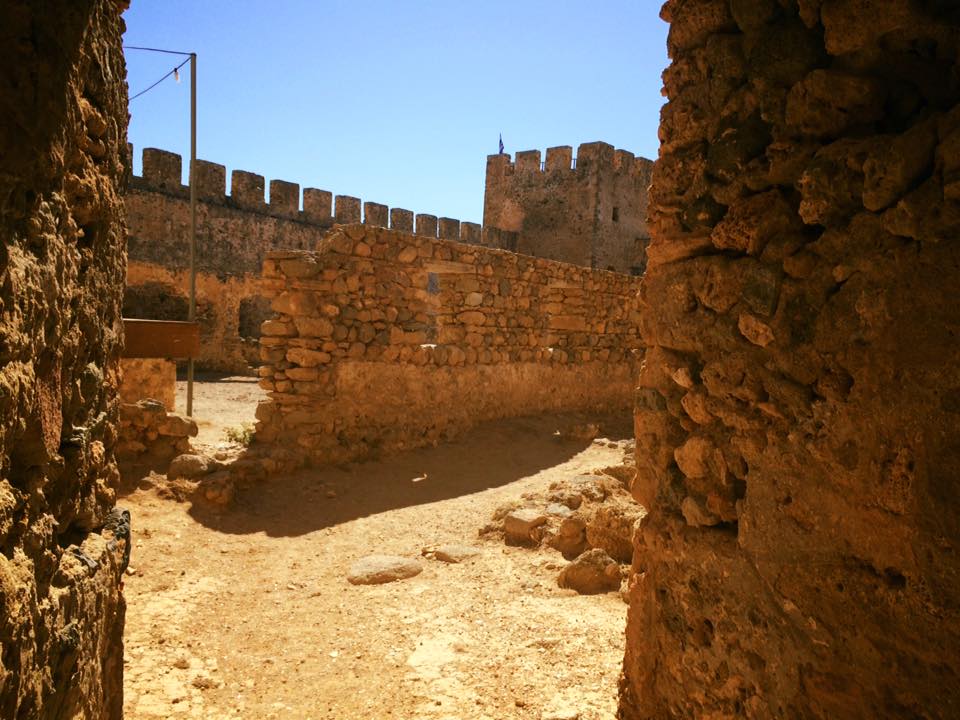
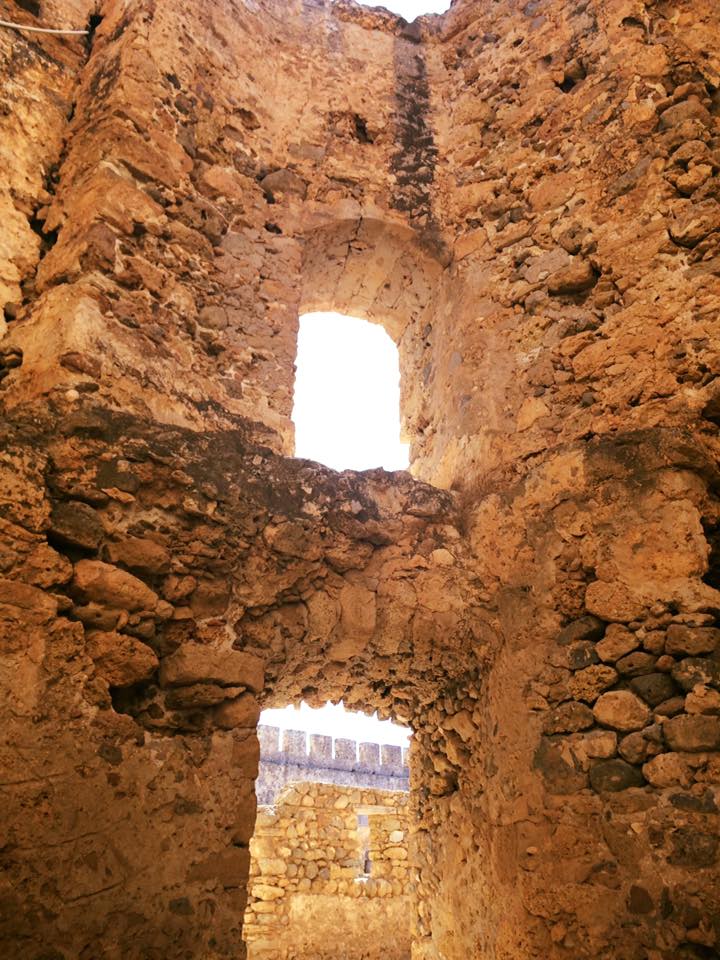
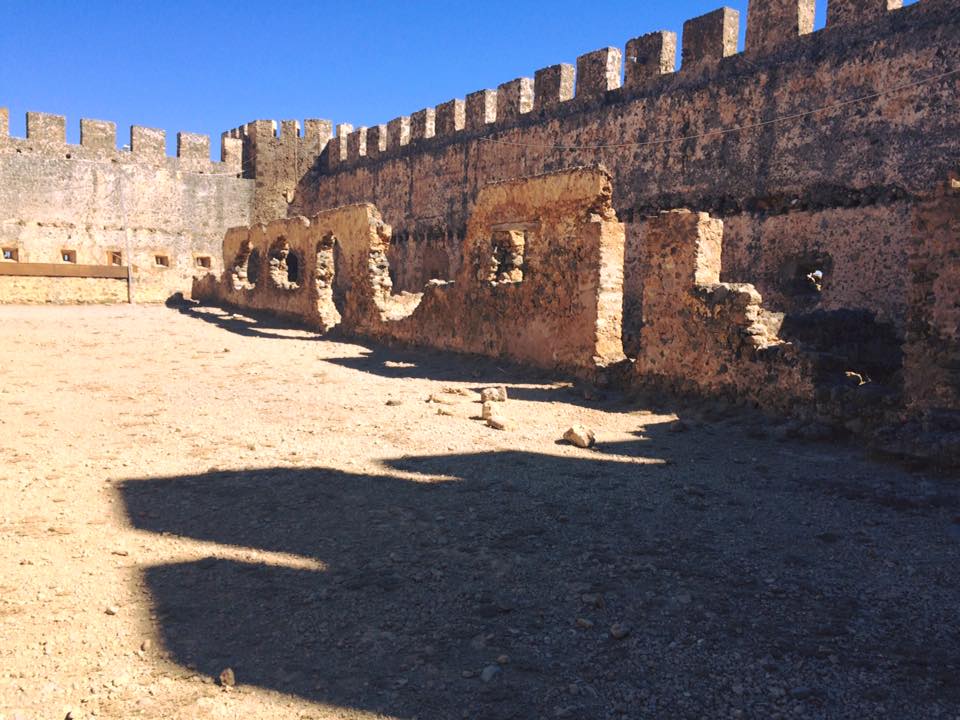
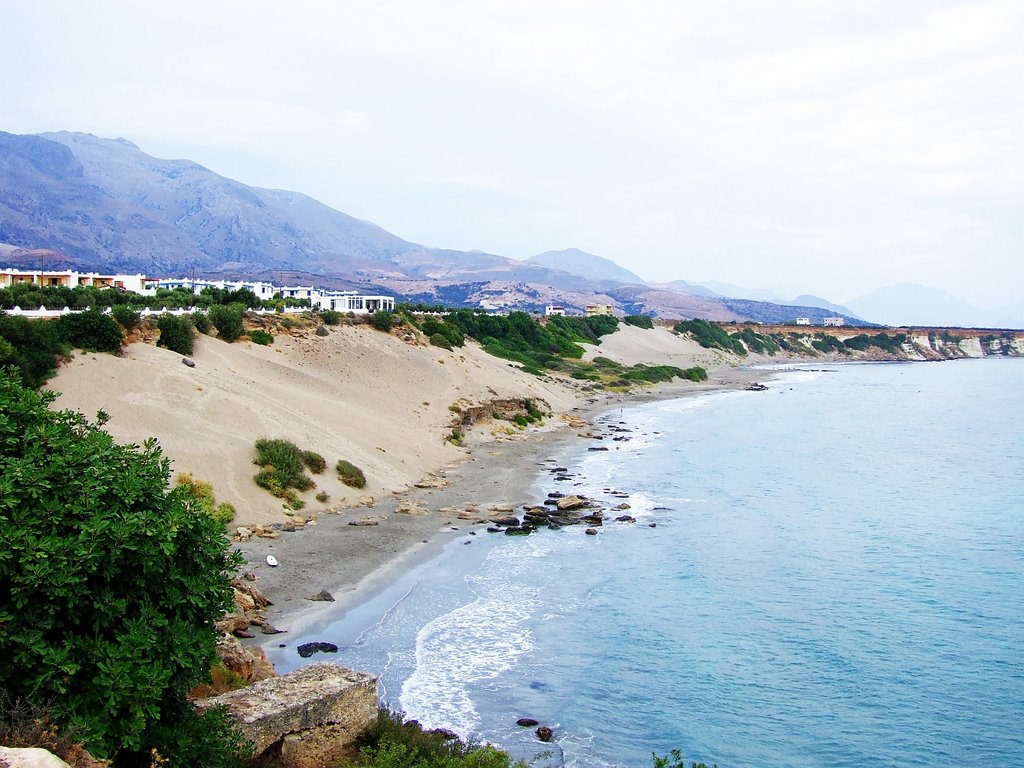
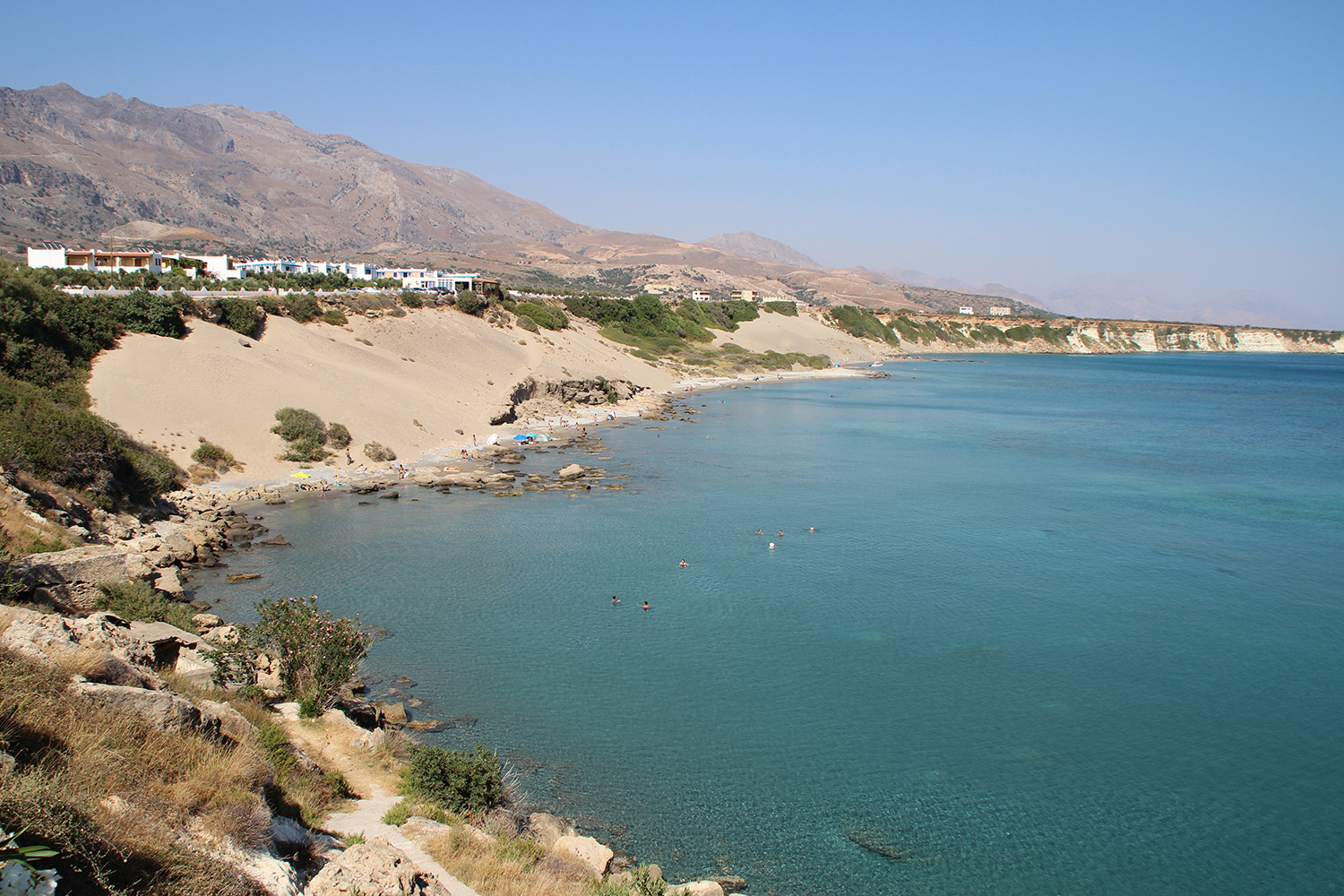 Are you still with me or have you wandered off into beach bliss heaven? Quite frankly, I couldn’t blame you if you have. As you can see, Crete is not lacking in the amazing beaches department. The waters are clear and a kaleidoscope of blues. The landscapes and backdrops surrounding the beaches aint too shabby either! But wait, there’s more! Here are a few other beaches that are also nice: Kournas Lake, Ombros Galos, Agia Roumeli (if you hiked the
Are you still with me or have you wandered off into beach bliss heaven? Quite frankly, I couldn’t blame you if you have. As you can see, Crete is not lacking in the amazing beaches department. The waters are clear and a kaleidoscope of blues. The landscapes and backdrops surrounding the beaches aint too shabby either! But wait, there’s more! Here are a few other beaches that are also nice: Kournas Lake, Ombros Galos, Agia Roumeli (if you hiked the 